D Link IR859A1 AC1750 High Power Wi-Fi Gigabit Router User Manual
D Link Corporation AC1750 High Power Wi-Fi Gigabit Router
D Link >
User Manual

Version 1.00 | 02/10/2015
User Manual
DIR-859
AC1750 High Power Wi-Fi Gigabit Router

iD-Link DIR-859 User Manual
D-Link reserves the right to revise this publication and to make changes in the content hereof without obligation to notify any
person or organization of such revisions or changes.
Manual Revisions
Trademarks
D-Link and the D-Link logo are trademarks or registered trademarks of D-Link Corporation or its subsidiaries in the United States or other countries.
All other company or product names mentioned herein are trademarks or registered trademarks of their respective companies.
Apple®, Apple logo®, Safari®, iPhone®, iPad®, iPod touch® and Macintosh® are trademarks of Apple Inc., registered in the U.S. and other countries. App
StoreSM is a service mark of Apple Inc. Chrome™ browser, Google Play™ and Android™ are trademarks of Google Inc. Internet Explorer®, Windows®
and the Windows logo are trademarks of the Microsoft group of companies.
Copyright © 2015 by D-Link Corporation, Inc. All rights reserved. This publication may not be reproduced, in whole or in part, without prior expressed
written permission from D-Link Corporation, Inc.
Revision Date Description
1.00 January 22, 2015 • Initial release
Preface

iiD-Link DIR-859 User Manual
Table of Contents
Product Overview .............................................................. 1
Package Contents ......................................................................... 1
System Requirements ................................................................. 2
Introduction ................................................................................... 3
Features ............................................................................................ 4
Hardware Overview ..................................................................... 5
Connections ........................................................................... 5
LEDs ........................................................................................... 6
Installation ......................................................................... 7
Before you Begin ........................................................................... 7
Wireless Installation Considerations ......................................8
Wall Mounting ............................................................................... 9
Manual Setup ............................................................................... 10
Getting Started ................................................................12
Setup Wizard ................................................................................13
QRS Mobile App ..........................................................................17
Conguration ...................................................................22
Home ..............................................................................................23
Internet ................................................................................... 23
DIR-859 ...................................................................................24
Connected Clients ..............................................................25
Settings ..........................................................................................26
Wizard .....................................................................................26
Internet ................................................................................... 26
IPv6 .....................................................................................35
Internet ................................................................................... 50
Wireless ..................................................................................53
Guest Zone .......................................................................55
Network .................................................................................. 56
Advanced ......................................................................................58
QoS Engine............................................................................58
Firewall Settings ..................................................................59
IPv4/IPv6 Rules ...............................................................61
Port Forwarding ..................................................................62
Website Filter ........................................................................ 63
Static Routes .........................................................................64
IPv6 .....................................................................................65
Dynamic DNS .......................................................................66
IPv6 Host ...........................................................................67
Management ................................................................................ 68
Time & Schedule .................................................................68
Time ....................................................................................68
Schedule ...........................................................................69
System Log ............................................................................70
Admin .....................................................................................71
System ...............................................................................72
Upgrade .................................................................................73
Statistics .................................................................................74
Connect a Wireless Client to your Router ......................75
WPS Button ...................................................................................75
Windows® 8 ................................................................................... 76
Table of Contents

iiiD-Link DIR-859 User Manual
Table of Contents
WPA/WPA2 ............................................................................76
Windows® 7 ................................................................................... 78
WPA/WPA2 ............................................................................78
WPS ..........................................................................................81
Windows Vista® ............................................................................ 85
WPA/WPA2 ............................................................................86
Windows® XP ................................................................................ 88
WPA/WPA2 ............................................................................89
Troubleshooting ..............................................................91
Wireless Basics .................................................................95
What is Wireless? ......................................................................... 96
Tips ...................................................................................................98
Wireless Modes ............................................................................99
Networking Basics .........................................................100
Check your IP address ............................................................ 100
Statically Assign an IP address ............................................ 101
Wireless Security ......................................................... 102
What is WPA? ................................................................ 102
Technical Specications ................................................103
Regulatory Information ................................................104

1D-Link DIR-859 User Manual
Section 1 - Product Overview
Product Overview
Package Contents
Note: Using a power supply with a dierent voltage rating than the one included with the DIR-859 will cause damage and void the warranty
for this product.
If any of the above items are missing, please contact your reseller.
DIR-859 AC1750 High Power Wi-Fi Gigabit Router
Ethernet Cable
Power Adapter
Wi-Fi Conguration Note
Wi-Fi Conguration Note

2D-Link DIR-859 User Manual
Section 1 - Product Overview
Network Requirements • An Ethernet-based cable or DSL modem
• 802.11ac, n, g, b, or a wireless or Ethernet port
Web-based Conguration
Utility Requirements
Computer with the following:
• Windows®, Macintosh, or Linux-based operating system
• An installed Ethernet adapter
Browser Requirements:
• Internet Explorer® 9 or higher
• Firefox® 20 or higher
• Safari 5.1 or higher
• Chrome™ 25 or higher
Windows® Users: Make sure you have the latest version of Java
installed. Visit www.java.com to download the latest version.
System Requirements

3D-Link DIR-859 User Manual
Section 1 - Product Overview
Introduction
The D-Link DIR-859 AC1750 High Power Wi-Fi Gigabit Router uses advanced AC technology to maximize the speed and range of
your wireless signal to signicantly outperform 802.11n and other 802.11ac devices. It also comes equipped with four Gigabit
ports to provide speeds up to 10x faster than standard 10/100 ports. With the addition of advanced Quality of Service (QoS),
data streams are separated, which helps organize and prioritize your network trac so your video streaming, gaming, and
VoIP calls run smoother over both your wired and wireless network.
The DIR-859 supports convenient set up options including QRS Mobile, which allows you to setup and congure the router
using a mobile app. You can set up your router right from your sofa, no PC required. Add in an easy-to-use web interface and
conguring your network is a quick and simple aair.
The DIR-859 AC1750 High Power Wi-Fi Gigabit Router provides incredible speeds, Gigabit ports, mobile setup, and terric
security features. To top it all o, the router has a stylish and innovative design and easy installation options.

4D-Link DIR-859 User Manual
Section 1 - Product Overview
Features
• Faster Wireless Networking - The DIR-859 uses advanced AC to provide up to a full 1750 Mbps* wireless
connection with concurrent 801.11ac and 802.11n wireless clients . It also operates on both the 2.4 GHz and
5 GHz bands to allow separation of trac so users can participate in high-bandwidth activities, such as video
streaming, online gaming, and real-time audio, without aecting low-priority trac like email and web surng.
• Set Up On Your Mobile - The DIR-859 supports the QRS Mobile app to let you set up the router using a mobile
device.
• Compatible with 802.11n/g/b/a Devices - The DIR-859 is still fully compatible with the 802.11n, IEEE 802.11g
and 802.11a standards, so it can connect with existing 802.11n, 802.11g, 802.11b, and 802.11a wireless devices.
• Advanced Firewall Features - The web-based user interface displays a number of advanced network
management features including:
• Content Filtering - Easily applied content ltering based on MAC address, URL, and/or domain name.
• Filter Scheduling - These lters can be scheduled to be active on certain days, or for a duration of
hours or minutes.
• Secure Multiple/Concurrent Sessions - The DIR-859 can pass through VPN sessions. It supports
multiple and concurrent IPSec and PPTP sessions, so users behind the DIR-859 can securely access
corporate networks.
• User-friendly Setup Wizard - Through its easy-to-use web-based user interface, the DIR-859 lets you control what
information is accessible to those on the wireless network, whether from the Internet, or from your company’s
server. Congure your router to your specic settings within minutes.
* Maximum wireless signal rate derived from IEEE Standard 802.11a, 802.11b, 802.11g, and 802.11n specications. Actual data throughput will vary. Network conditions and
environmental factors, including volume of network trac, building materials and construction, and network overhead, lower actual data throughput rate. Environmental
conditions will adversely aect wireless signal range.

5D-Link DIR-859 User Manual
Section 1 - Product Overview
Hardware Overview
Connections
1 LAN Ports (1-4) Connect Ethernet devices such as computers, switches, storage (NAS) devices and game consoles.
2 Internet Port Using an Ethernet cable, connect your broadband modem to this port.
3 Power Receptor Receptor for the supplied power adapter.
4 Power Button Press the button to power on the device.
5 WPS Button Press this button to initiate WPS with supported client devices.
34
125
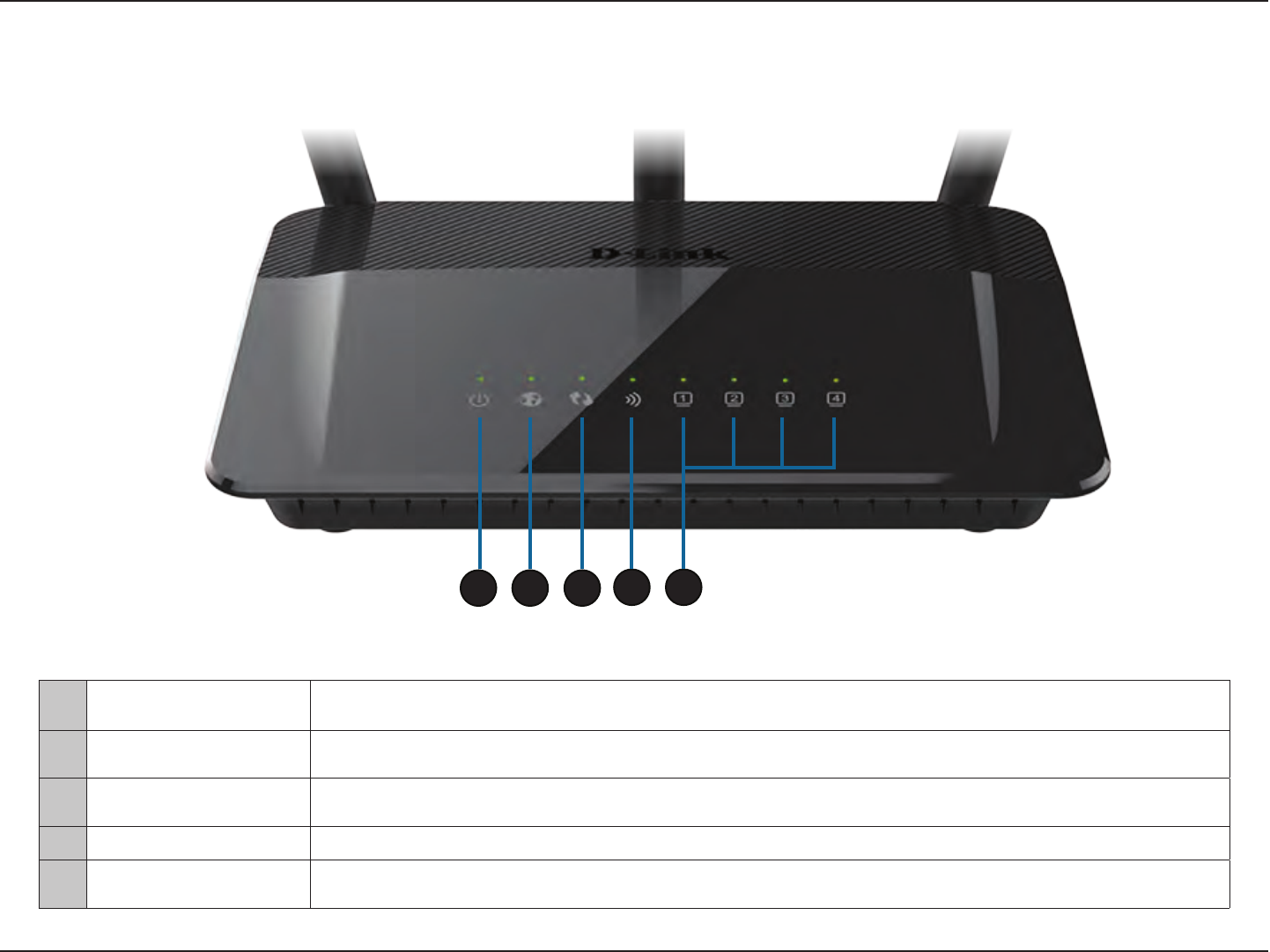
6D-Link DIR-859 User Manual
Section 1 - Product Overview
Hardware Overview
LEDs
1 Power LED A solid blue light indicates a proper connection to the power supply. The light will be a solid orange during
boot up.
2 Internet LED A solid light indicates connection on the Internet port. If the LED is orange, the connection is good but the
router cannot connect to the Internet.
3 WPS LED A solid light indicates that the WPS handshake has been completed. The light will blink while the WPS
handshake is processing.
4 WLAN LED A solid light indicates that the wireless segment is ready. The light will blink while data is being transmitted.
5 Ethernet LEDs 1-4 A solid light indicates a connection to an Ethernet-enabled computer on ports 1-4 respectively. The light
will blink while data is being transmitted.
1 2 4 5
3

7D-Link DIR-859 User Manual
Section 2 - Installation
Before you Begin
Installation
This section will walk you through the installation process. Placement of the router is very important. Do not place the router
in an enclosed area such as a closet, cabinet, or in the attic or garage.
• Please congure the router with the computer that was last connected directly to your modem.
• You can only use the Ethernet port on your modem. If you were using the USB connection before using the router,
then you must turn o your modem, disconnect the USB cable and connect an Ethernet cable to the Internet port
on the router, and then turn the modem back on. In some cases, you may need to call your ISP to change connection
types (USB to Ethernet).
• If you have DSL and are connecting via PPPoE, make sure you disable or uninstall any PPPoE software such as WinPoET,
BroadJump, or EnterNet 300 from your computer or you will not be able to connect to the Internet.

8D-Link DIR-859 User Manual
Section 2 - Installation
Wireless Installation Considerations
The D-Link wireless router lets you access your network using a wireless connection from virtually anywhere within the operating
range of your wireless network. Keep in mind that the number, thickness and location of walls, ceilings, or other objects that the
wireless signals must pass through may limit the range. Typical ranges vary depending on the types of materials and background
RF (radio frequency) noise in your home or business. The key to maximizing wireless range is to follow these basic guidelines:
1. Keep the number of walls and ceilings between the D-Link router and other network devices to a minimum -
each wall or ceiling can reduce your adapter’s range from 3-90 feet (1-30 meters.) Position your devices so that
the number of walls or ceilings is minimized.
2. Be aware of the direct line between network devices. A wall that is 1.5 feet thick (0.5 meters), at a 45-degree
angle appears to be almost 3 feet (1 meter) thick. At a 2-degree angle it looks over 42 feet (14 meters) thick!
Position devices so that the signal will travel straight through a wall or ceiling (instead of at an angle) for better
reception.
3. Building materials make a dierence. A solid metal door or aluminum studs may have a negative eect on range.
Try to position access points, wireless routers, and computers so that the signal passes through drywall or open
doorways. Materials and objects such as glass, steel, metal, walls with insulation, water (sh tanks), mirrors, le
cabinets, brick, and concrete will degrade your wireless signal.
4. Keep your product away (at least 3-6 feet or 1-2 meters) from electrical devices or appliances that generate RF
noise.
5. If you are using 2.4 GHz cordless phones or X-10 (wireless products such as ceiling fans, lights, and home security
systems), your wireless connection may degrade dramatically or drop completely. Make sure your 2.4 GHz phone
base is as far away from your wireless devices as possible. The base transmits a signal even if the phone is not
in use.

9D-Link DIR-859 User Manual
Section 2 - Installation
Wall Mounting
You can mount the DIR-859 on a wall or partition for ease and convenience.
To wall mount your device:
Step 1
Screw the provided screws to the wall to which the router will be
mounted.
Step 2
Place the mounting holes on the bottom of the device over the screws,
and slide the device into place.
Step 3
Finally, connect the required cables to the device as outlined on page 10.
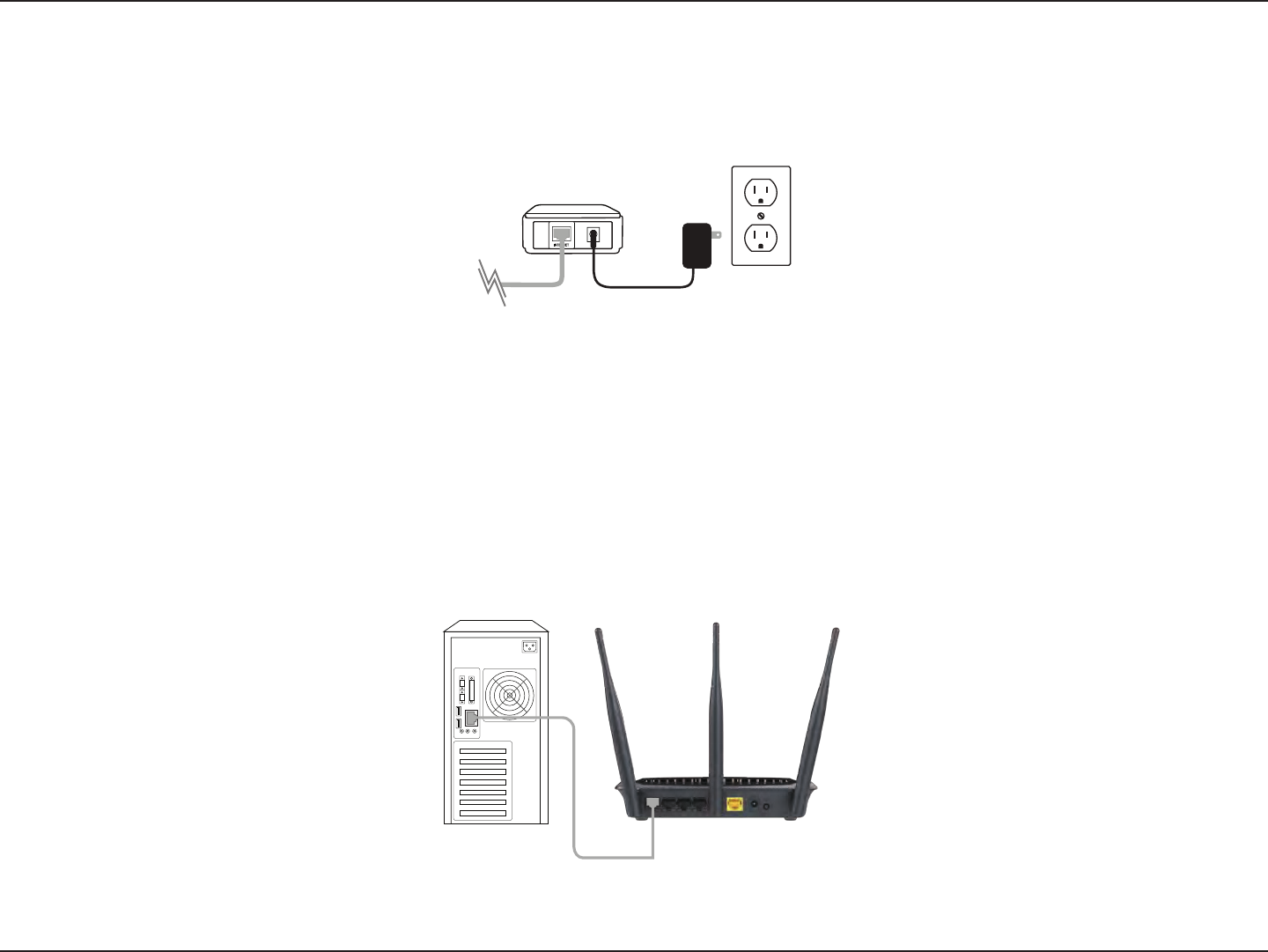
10D-Link DIR-859 User Manual
Section 2 - Installation
4
1. Turn o and unplug your cable or DSL broadband modem. This is required.
Manual Setup
2. Position your router close to your modem and a computer. Place the router in an open area of your intended
work area for better wireless coverage.
3. Unplug the Ethernet cable from your modem (or existing router if upgrading) that is connected to your computer.
Plug it into the LAN port labeled 1 on the back of your router. The router is now connected to your computer.
DIR-859Computer
Modem
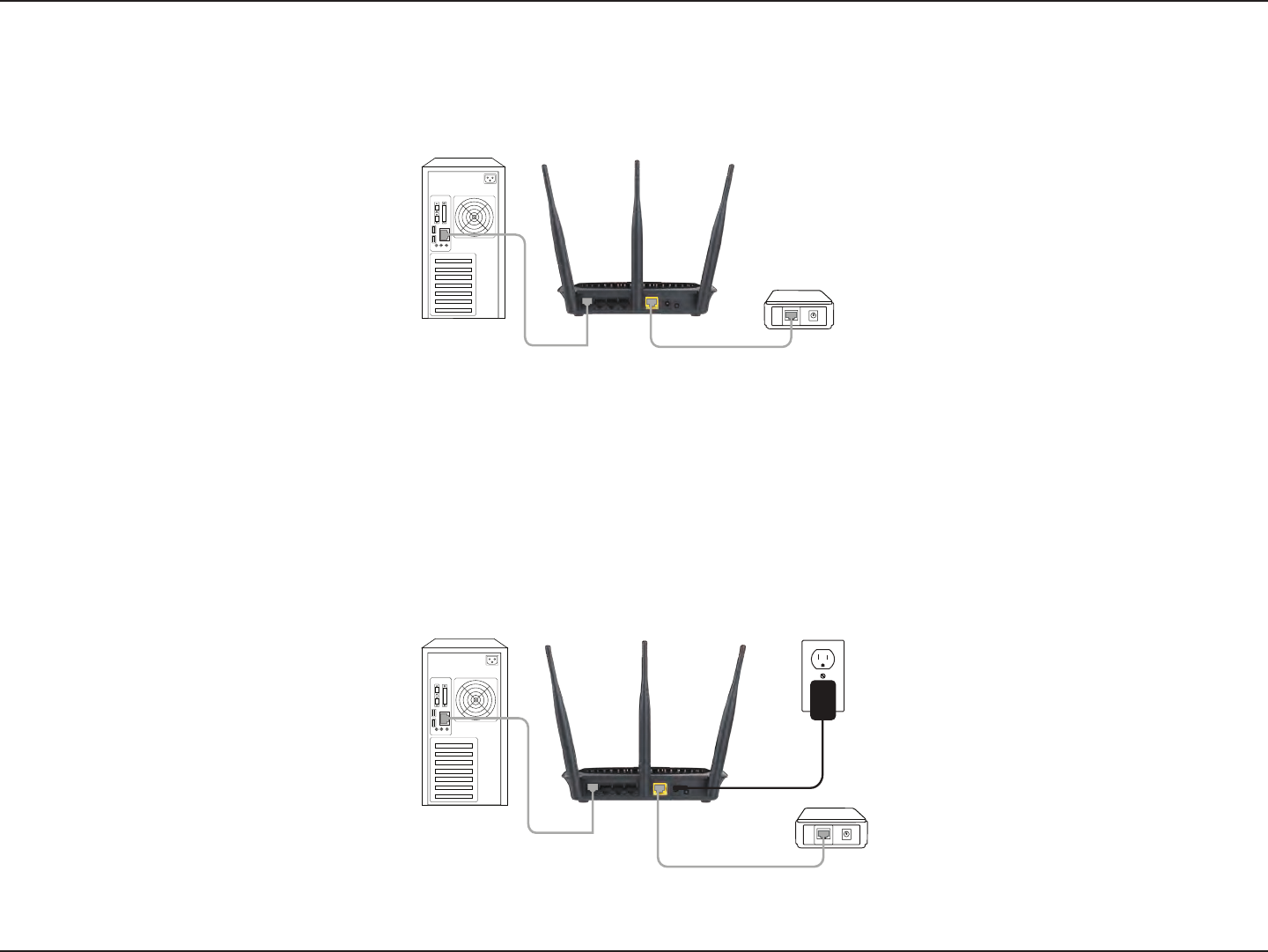
11D-Link DIR-859 User Manual
Section 2 - Installation
44
INTERNET
4
INTERNET
4
4. Plug one end of the included Ethernet cable that came with your router into the yellow port labeled INTERNET
on the back of the router. Plug the other end of this cable into the Ethernet port on your modem.
5. Reconnect the power adapter to your cable or DSL broadband modem and wait for two minutes.
6. Connect the supplied power adapter into the power receptor on the back of the router and then plug it into a
power outlet or surge protector. Press the power button and verify that the power LED is lit. Allow 1 minute for
the router to boot up.
7. If you are connecting to a broadband service, you may be online already and further conguration will be optional.
DIR-859
DIR-859
Modem
Computer
Modem
Computer

12D-Link DIR-859 User Manual
Section 3 - Getting Started
There are several dierent ways you can congure your router to connect to the Internet and connect to your clients:
• D-Link Setup Wizard - This wizard will launch when you log into the router for the rst time. Refer to page 13.
• QRS Mobile App - Use your iPhone, iPad, or iPod touch to congure your router. Refer to page 17.
• Manual Setup - Log into the router and manually congure your router. Refer to page 22.
Getting Started

13D-Link DIR-859 User Manual
Section 3 - Getting Started
The wizard is designed to guide you through a step-by-step process to
congure your new D-Link router and connect to the Internet.
Click Next to continue.
Setup Wizard
If this is your rst time installing the router, open your web browser and
enter http://dlinkrouter.local/ in the address bar. Alternatively, enter
the IP address of the router (default: http://192.168.0.1). Please refer
to page 22.
Please wait while your router detects your Internet connection type. If
the router detects your Internet connection, you may need to enter your
ISP information such as username and password.
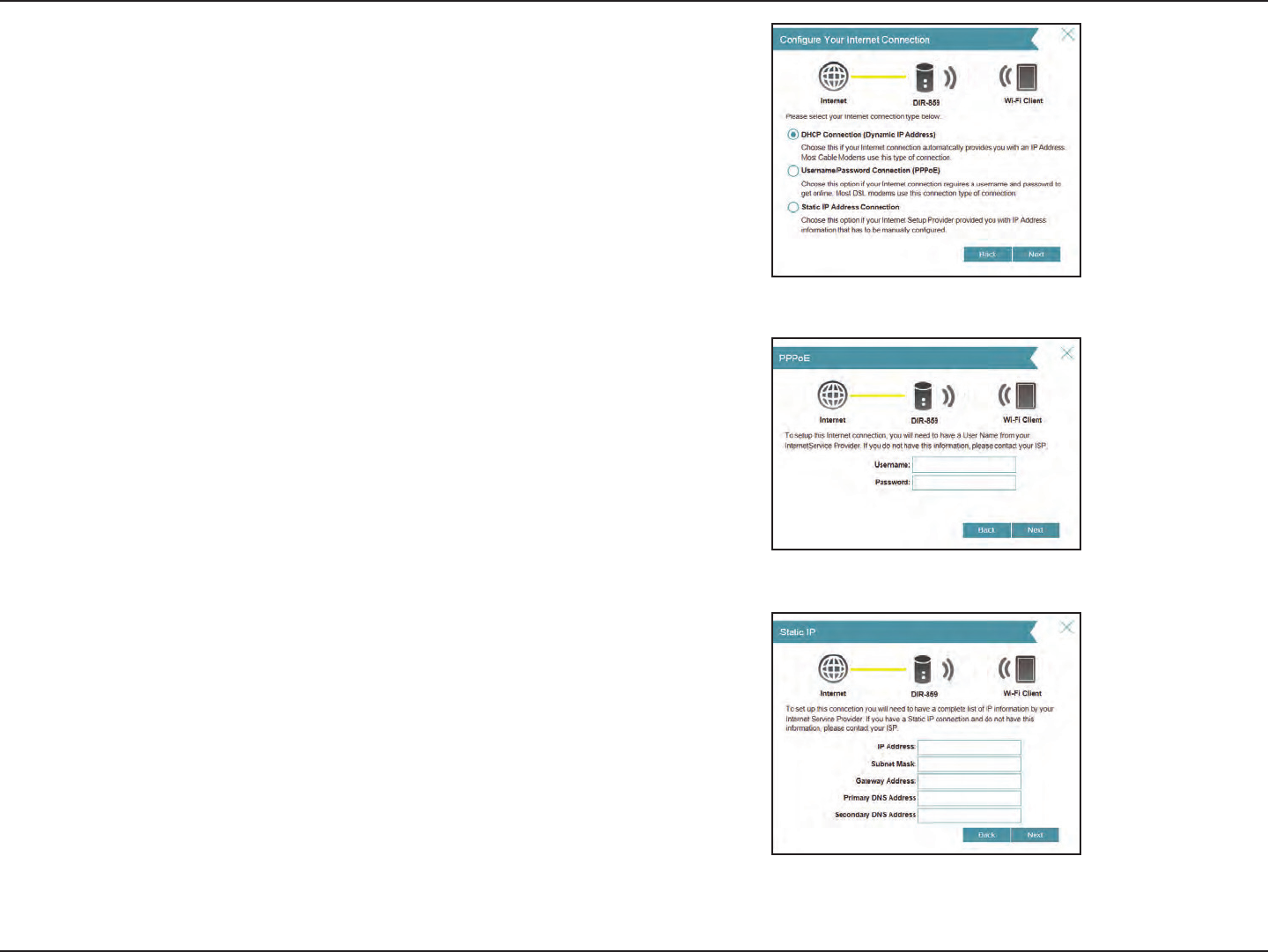
14D-Link DIR-859 User Manual
Section 3 - Getting Started
If the router does not detect a valid Internet connection, a list of
connection types to choose from will be displayed.
Select your Internet connection type (this information can be obtained
from your Internet service provider) and click Next to continue.
If the router detected or you selected PPPoE, enter your PPPoE username
and password and click Next to continue.
Note: Make sure to remove your PPPoE software from your computer. The
software is no longer needed and will not work through a router.
If the router detected or you selected Static, enter the IP and DNS settings
supplied by your ISP. Click Next to continue.
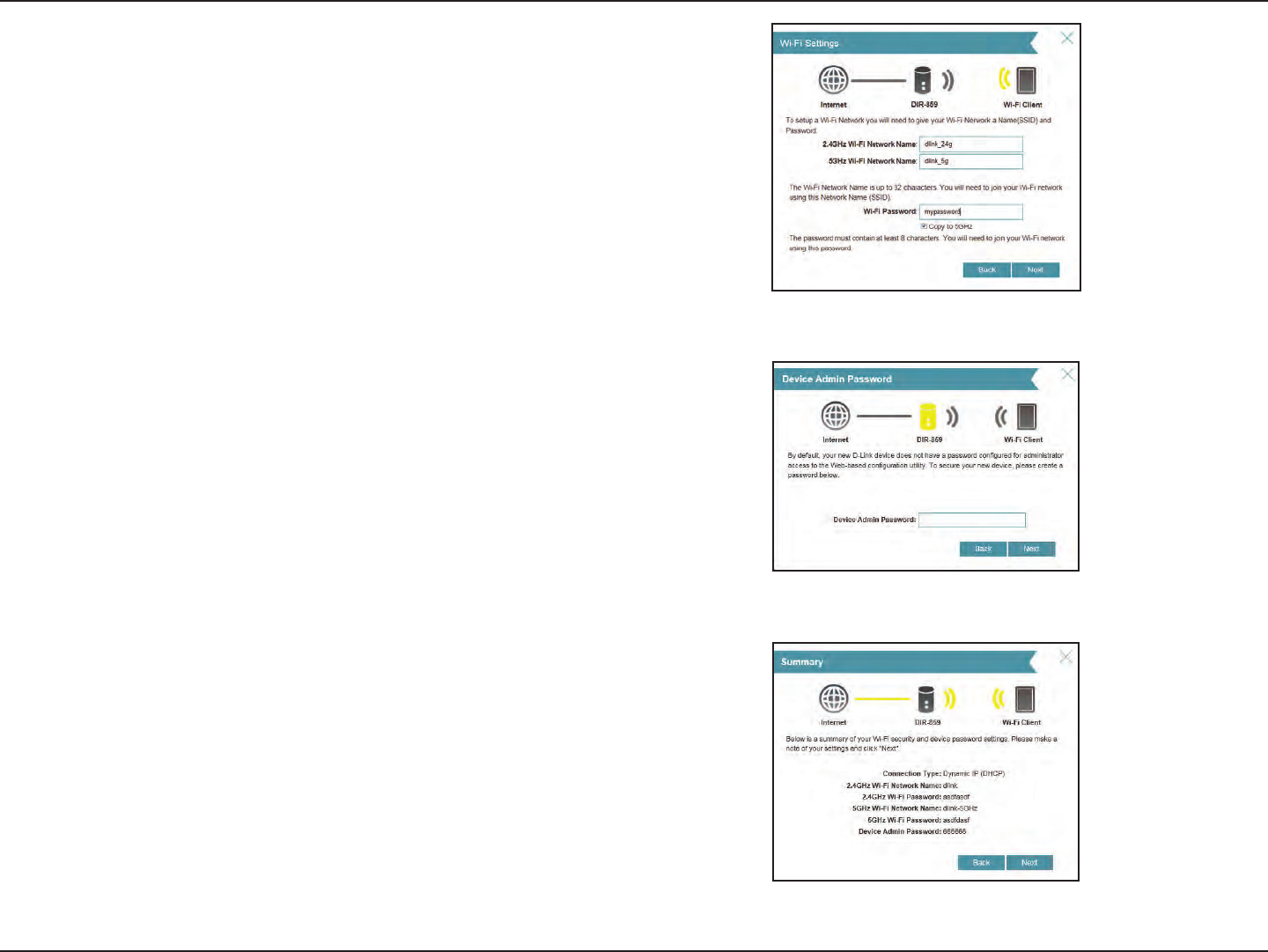
15D-Link DIR-859 User Manual
Section 3 - Getting Started
For both the 2.4 GHz and 5 GHz segments, create a Wi-Fi network name
(SSID) using up to 32 characters.
Create a Wi-Fi password (between 8-63 characters). Your wireless clients
will need to have this passphrase or key entered to be able to connect
to your wireless network.
Click Next to continue.
In order to secure the router, please enter a new password. You will be
prompted for this password every time you want to use the router’s web
conguration utility. Click Next to continue.
The Summary window will display your settings. Click Next if you are
satised, or click Back to make changes to them.
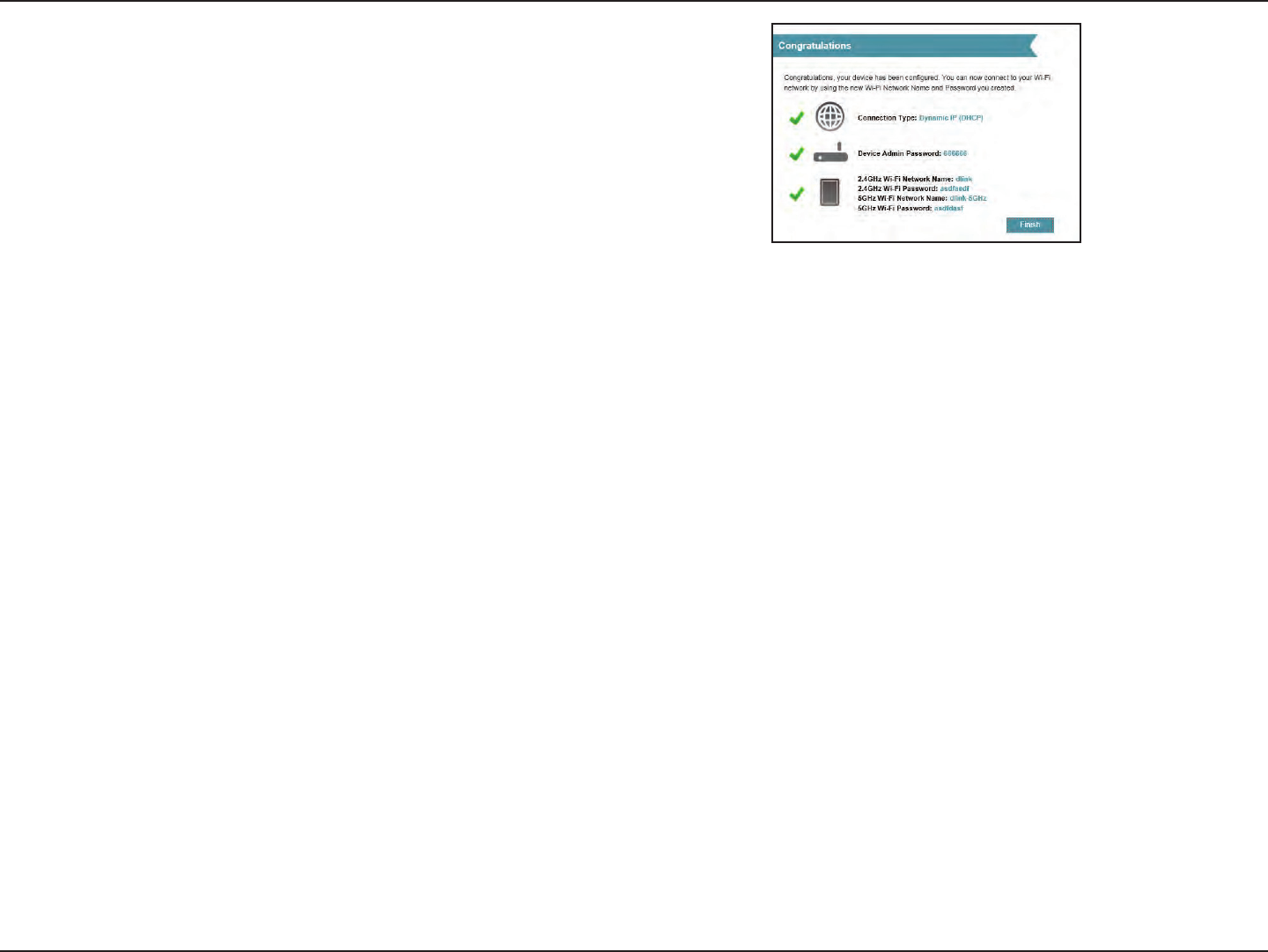
16D-Link DIR-859 User Manual
Section 3 - Getting Started
At the end of the wizard, you will be presented with a nal summary of
your settings. Click Finish to close the wizard.
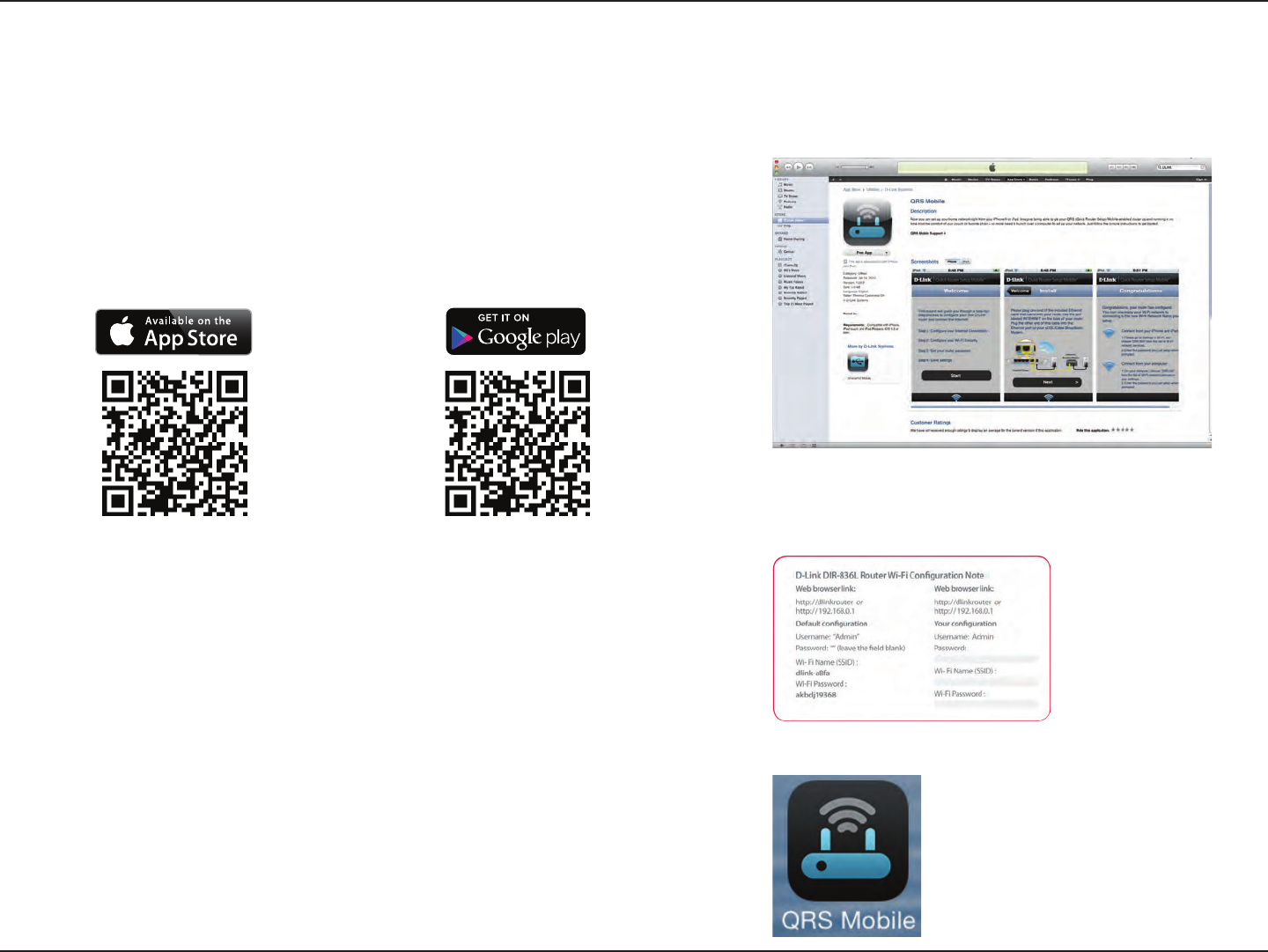
17D-Link DIR-859 User Manual
Section 3 - Getting Started
QRS Mobile App
QRS Mobile app allows you to install and congure your router from your mobile device.
Step 1
Search for the free QRS Mobile App on the iTunes Store or Google Play.
Step 2
Once your app is installed, you may now congure your router. Connect
to the router wirelessly by going to your wireless utility on your device.
Scan for the Wi-Fi name (SSID) as listed on the supplied info card. Select
and then enter your Wi-Fi password.
Step 3
Once you connect to the router, launch the QRS Mobile app from the
Home screen of your device.
For the iTunes Store, you may
also scan this code to download.
For Google Play, you may also
scan this code to download.
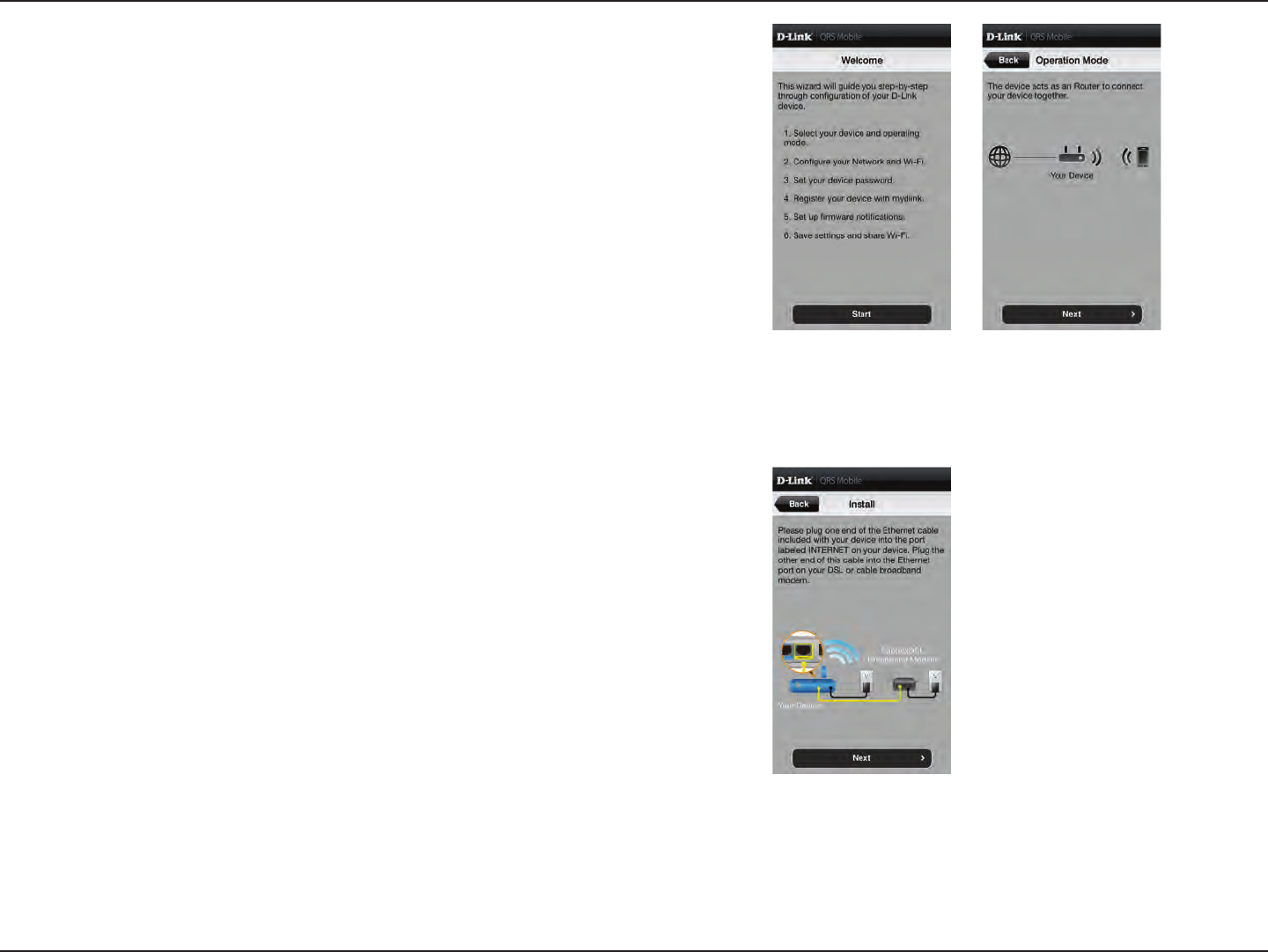
18D-Link DIR-859 User Manual
Section 3 - Getting Started
Step 4
You will see the welcome screen. Tap Start to proceed, then Next once
the Operation Mode screen appears.
Step 5
At this point, please ensure that you the router is connected to a modem.
Plug one end of the provided Ethernet cable into your DSL or cable
modem, and plug the other end into the port marked INTERNET on the
DIR-859. Tap Next to automatically detect your Internet connection and
proceed to the next step.
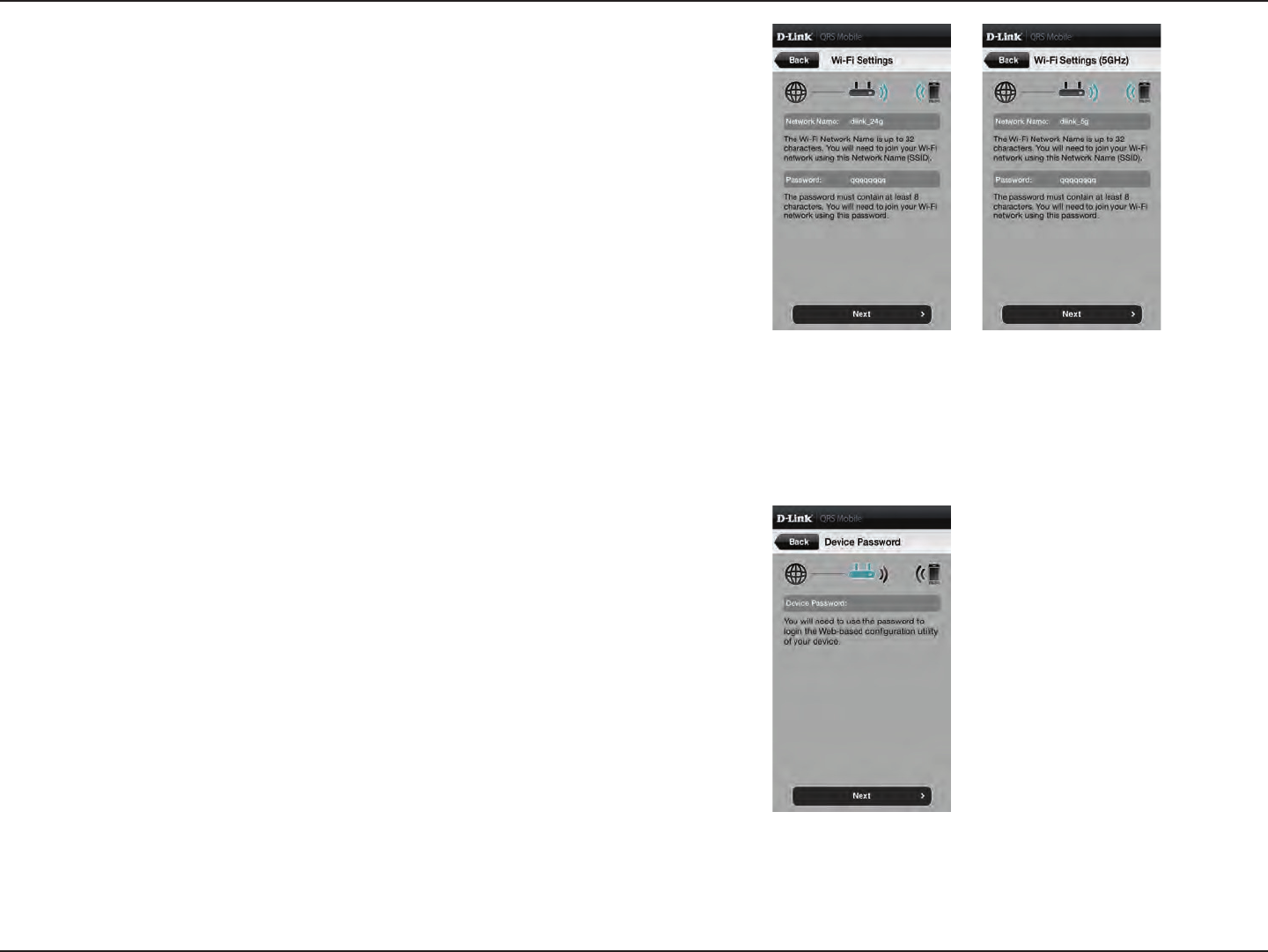
19D-Link DIR-859 User Manual
Section 3 - Getting Started
Step 6
You will be prompted to set up each wireless frequency band in turn;
the 2.4 GHz band followed by the 5 GHz band.
Firstly, enter a network name (SSID) of your choice, or leave it unchanged
to accept the default SSID. Each wireless band can be assigned its own
SSID.
Secondly, choose a Wi-Fi password of at least 8 characters. Any device
trying to connect to the router wirelessly will need to enter this password
the rst time it connects.
Finally, tap Next to proceed.
Step 7
Enter the administrator password of your choice. Unlike the Wi-Fi
password, this password is only required when you need to congure
the router. See page 22 for details of when this password is used. Tap Next
to proceed.
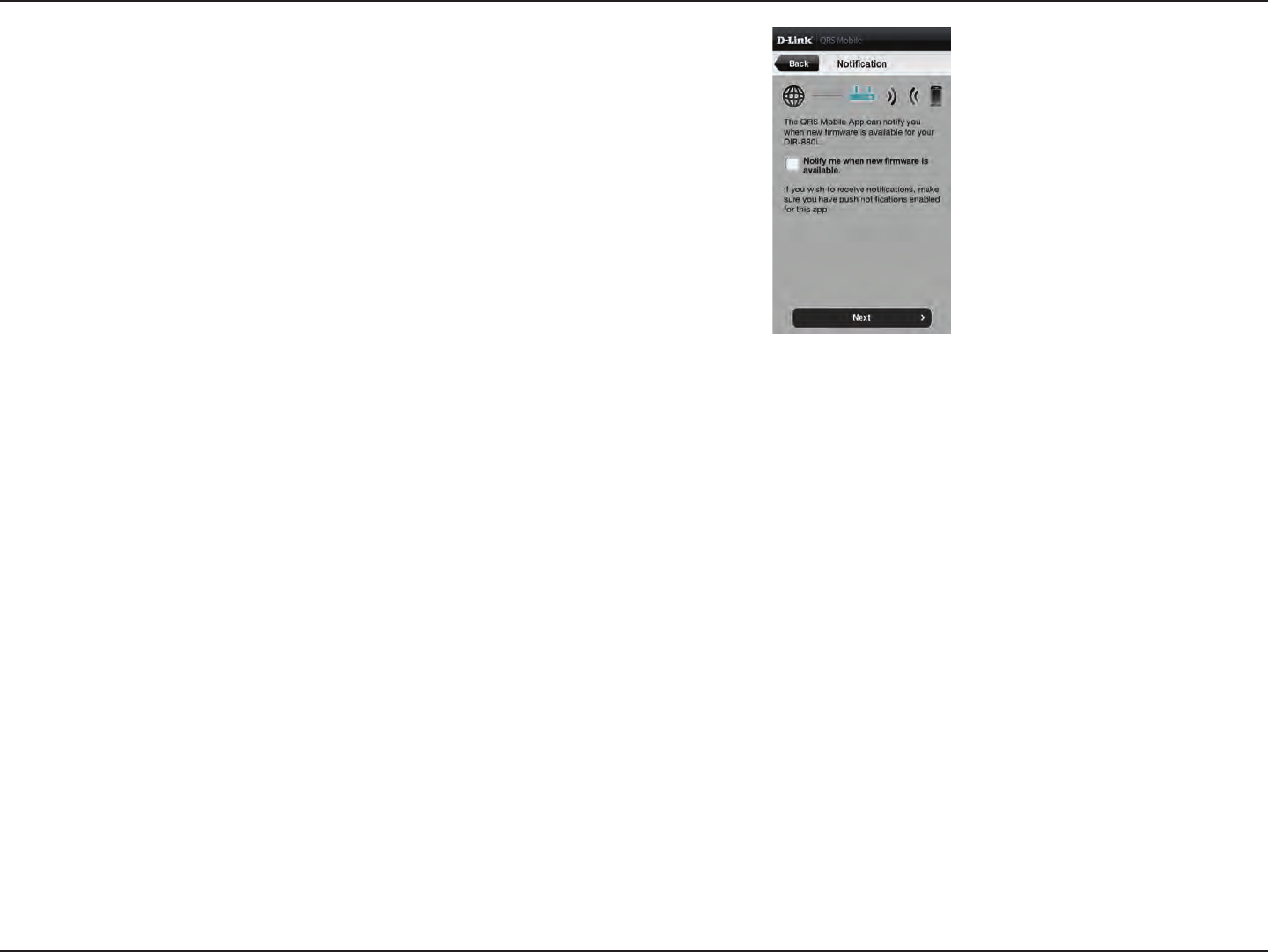
20D-Link DIR-859 User Manual
Section 3 - Getting Started
Step 8
If you wish to receive push notications whenever a new rmware update
is available, check the Notify me when new rmware is available box
and tap Next.
Otherwise, just tap Next to proceed.
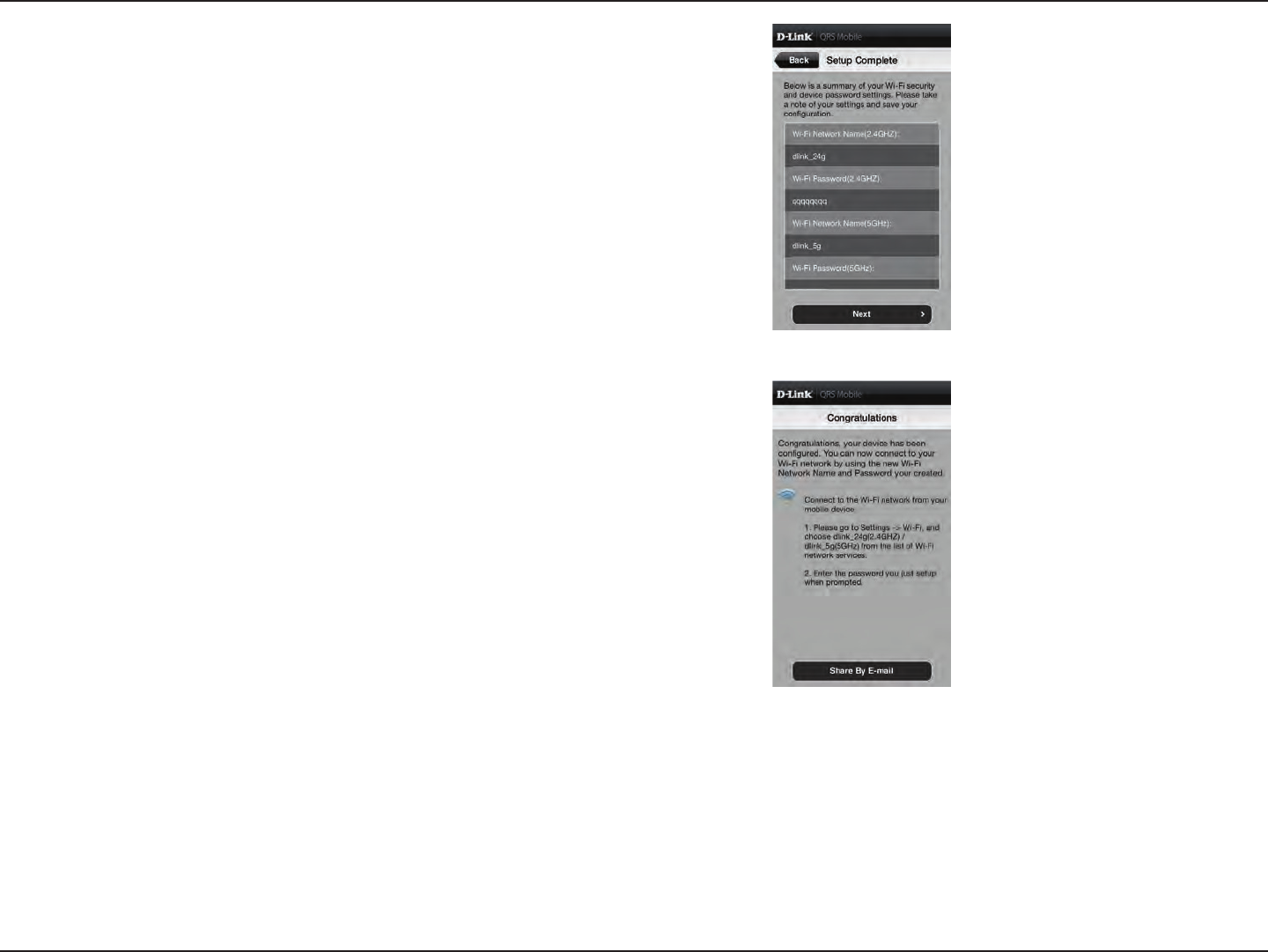
21D-Link DIR-859 User Manual
Section 3 - Getting Started
Step 10
You will be presented with a summary of your chosen settings. If you wish
to make any changes, tap Back to step back through the previous pages.
Otherwise, tap Next to complete the setup.
Congratulations, your device has been successfully congured! You may
now exit the QRS app.
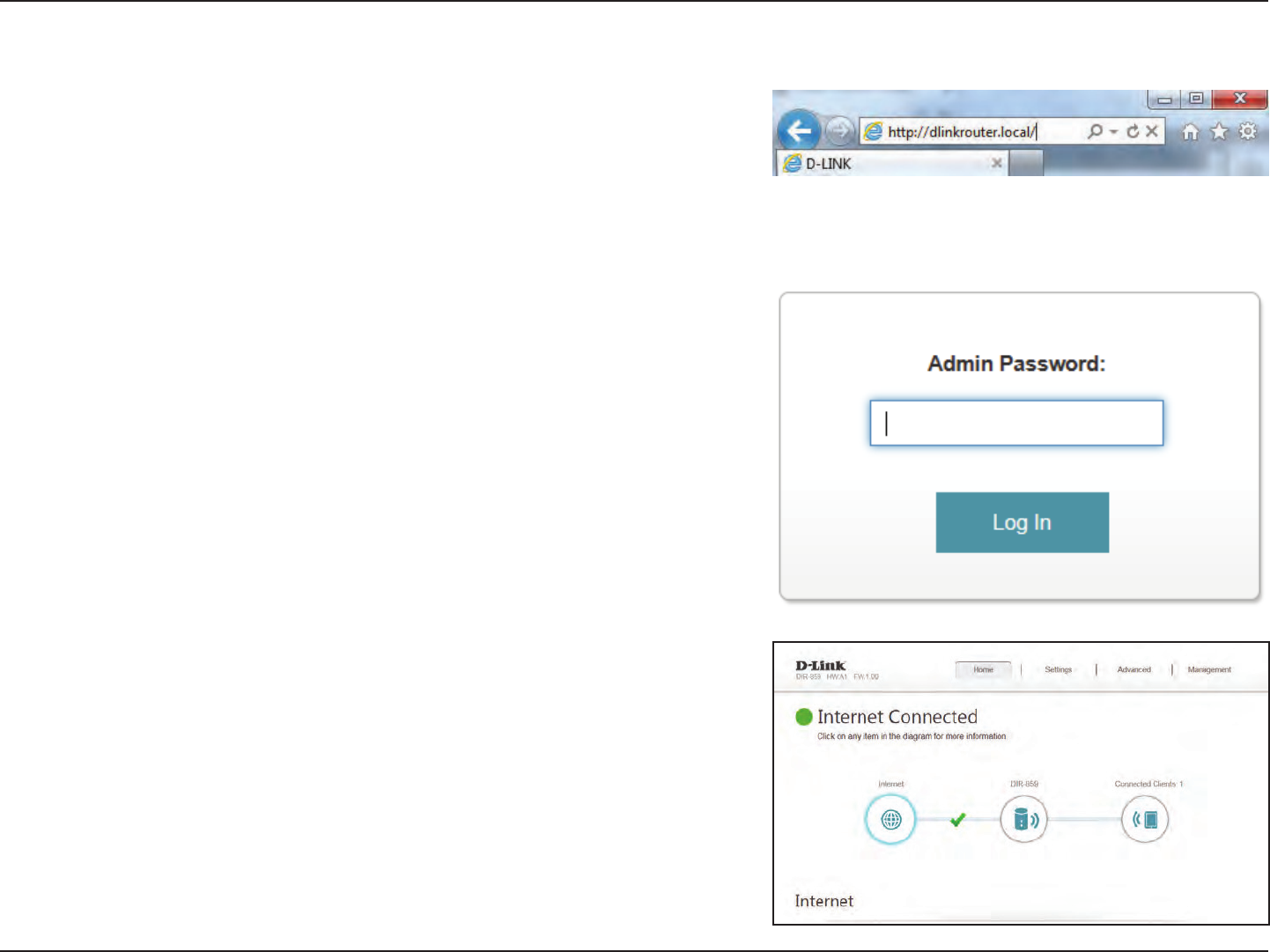
22D-Link DIR-859 User Manual
Section 4 - Conguration
Conguration
Enter your password. If you previously followed the setup wizard (see page 13), please
use the admin password you entered during the wizard. Otherwise, leave the
password blank. Click Log In to proceed.
Note: If you cannot remember your password and cannot log in, press the reset button
(see "Troubleshooting" on page 91) to restore the router to its default settings.
To access the conguration utility, open a web-browser such as Internet Explorer
and enter http://dlinkrouter.local.
Windows and Mac users may also connect by typing the IP address of the router (by
default this is http://192.168.0.1) in the address bar.
The router’s home page will open displaying its current connection status.
The bar at the top of the page has quick access to Settings and Management
functions. You may quickly jump back Home at any time.
Note: The system will automatically log out after a period of inactivity.

23D-Link DIR-859 User Manual
Section 4 - Conguration
Home
The Home page displays the current status of the router in the form of an interactive diagram. You can click each icon to display
information about each part of the network at the bottom of the screen. The menu bar at the top of the page will allow you
to quickly navigate to other pages.
The Home page displays whether or not the router is currently connected to the
Internet. If it is disconnected, click Click to repair to bring up the setup wizard
(see page 13).
To bring up more details about your Internet connection, click on the Internet
icon. Click IPv4 or IPv6 to see details of the IPv4 connection and IPv6 connection
respectively.
Click Release to disconnect from the Internet. If you do this and wish to reconnect,
click Renew.
To recongure the Internet settings, refer to page 26.
Internet
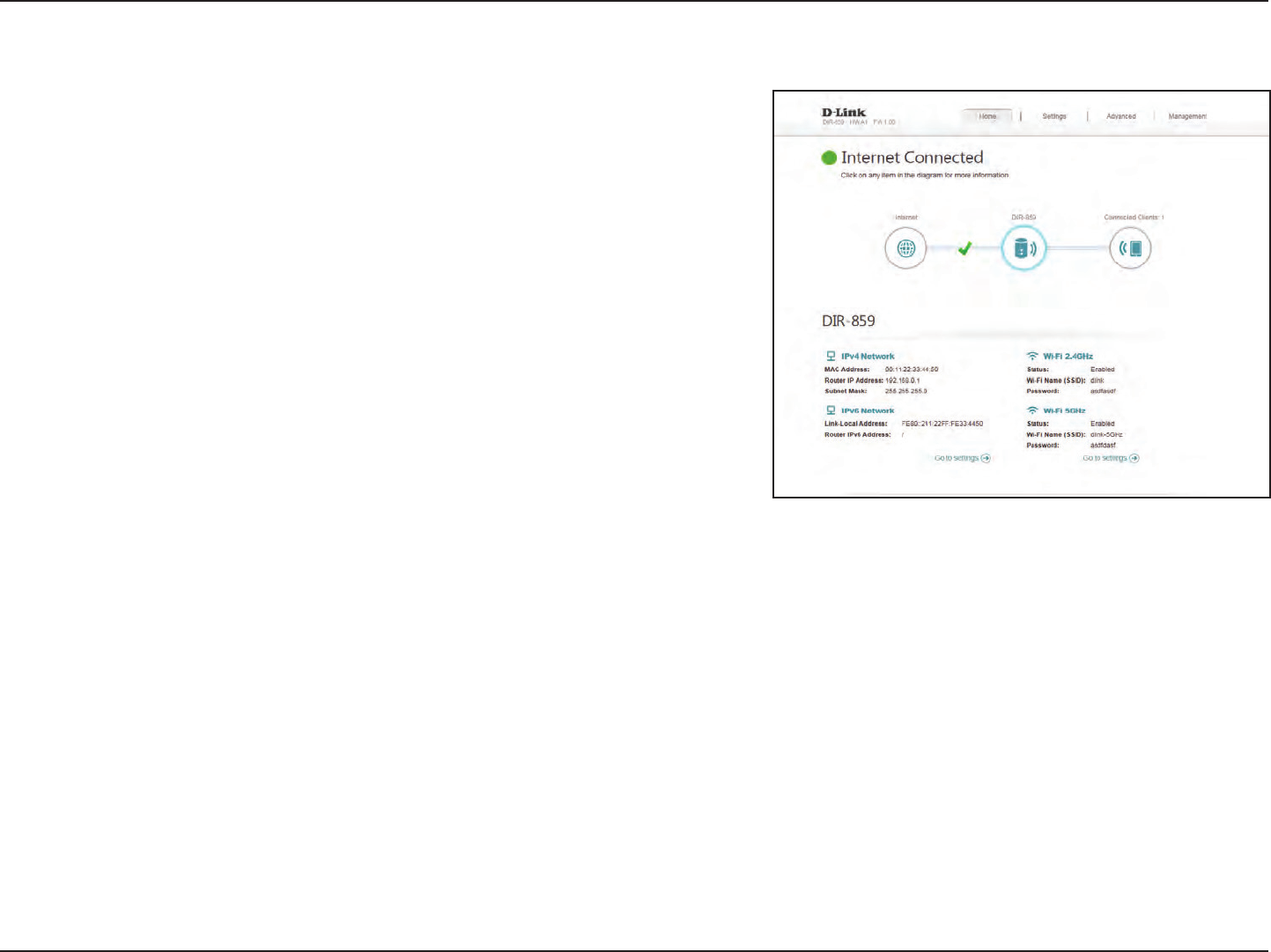
24D-Link DIR-859 User Manual
Section 4 - Conguration
DIR-859
Click on the DIR-859 icon to view details about the router and its wireless settings.
Here you can see the router’s current wireless settings, as well as its MAC address
and IPv4/IPv6 addresses.
To recongure the network settings, either click Go to settings on the lower left, or
click Settings (at the top of the page) and then Network on the menu that appears.
Refer to page 56.
To recongure the wireless settings, either click Go to settings, on the lower right, or
click Settings (at the top of the page) and then Wireless on the menu that appears.
Refer to page 53.
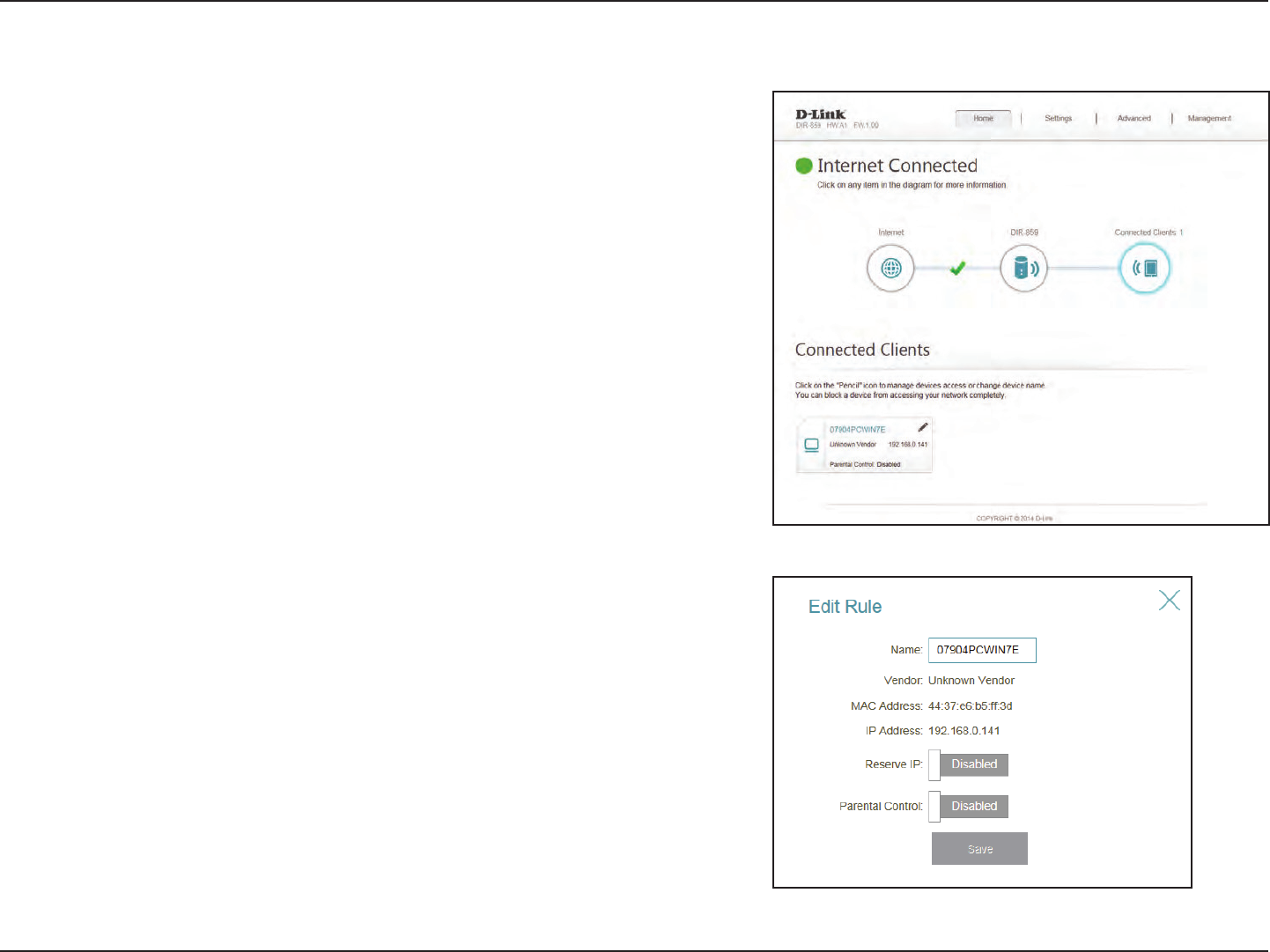
25D-Link DIR-859 User Manual
Section 4 - Conguration
Connected Clients
Click on the Connected Clients icon to view details about the router and its wireless
settings.
On this page you can see all the clients currently connected to the router, and their
IP addresses.
To edit each client’s settings, click the pencil icon on the client you want to edit.
Enter a custom name for this client.
Displays the vendor of the device.
Enter a specic IP address for this client.
Enable to reserve this IP address for this client.
Enable or disable parental control.
Click Save when you are done.
Name:
Vendor:
IP Address:
Reserve IP:
Parental
Control:
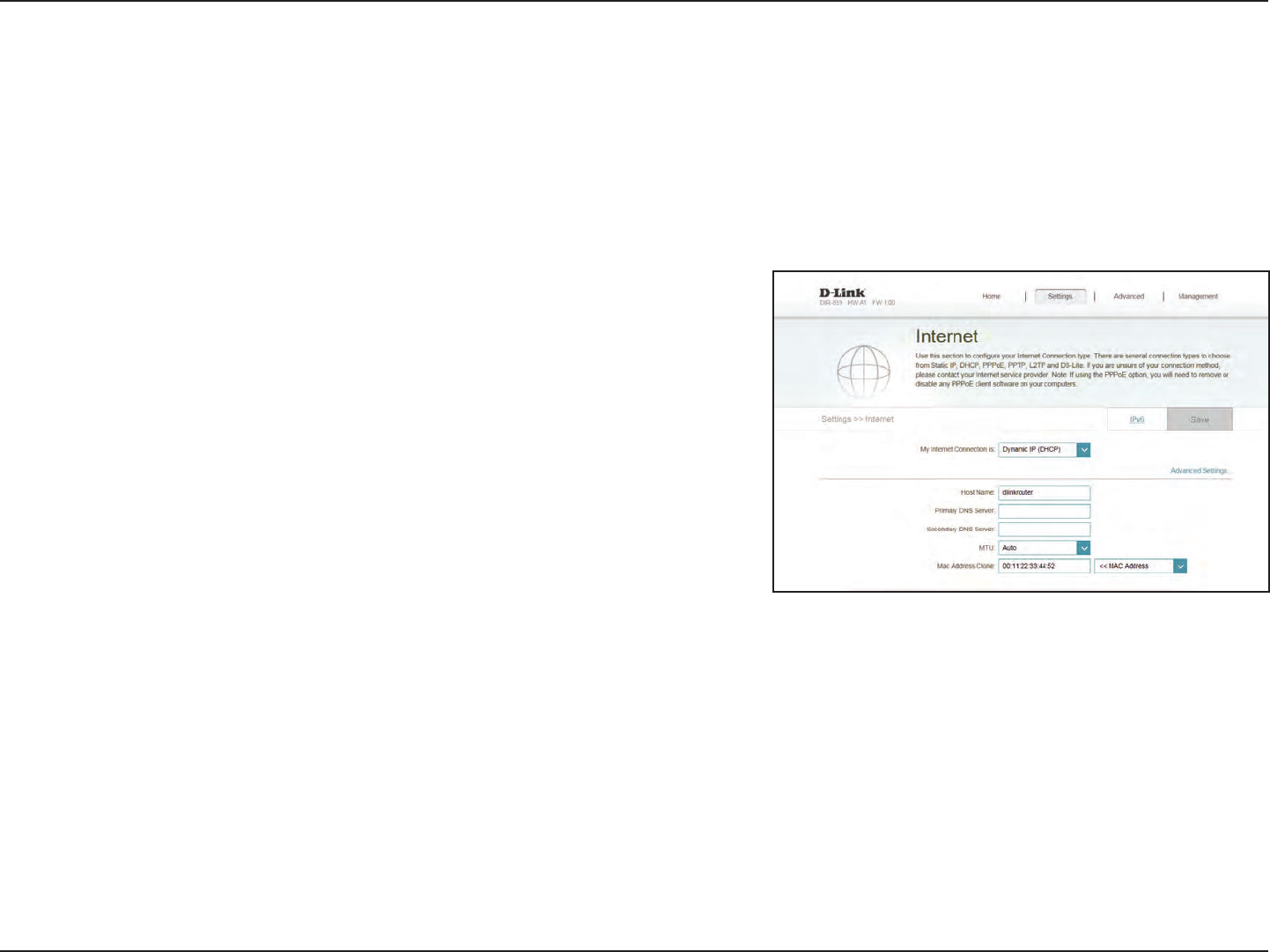
26D-Link DIR-859 User Manual
Section 4 - Conguration
Settings
Wizard
Internet
In the Settings menu on the bar on the top of the page, click Wizard to open the setup wizard. This is the same wizard that appears when you start
the router for the rst time. Refer to page 13 for details.
In the Settings menu on the bar on the top of the page, click Internet to see the
Internet conguration options.
Choose your Internet connection type from the drop-down menu.
You will be presented with the appropriate options for your
connection type. Click Advanced Settings... to expand the list and
see all of the options.
My Internet
Connection Is:
For Dynamic IP (DHCP) refer to page 27.
For Static IP refer to page 28.
For PPPoE refer to page 29.
For PPTP refer to page 30.
For L2TP refer to page 32.
For DS-Lite refer to page 34.
To congure an IPv6 connection, click the IPv6 link. Refer to page 35.

27D-Link DIR-859 User Manual
Section 4 - Conguration
The host name is optional but may be required by some ISPs. Leave
it blank if you are not sure.
Enter the primary DNS server IP address assigned by your ISP. This
address is usually obtained automatically from your ISP.
Enter the secondary DNS server IP address assigned by your ISP. This
address is usually obtained automatically from your ISP.
Maximum Transmission Unit - you may need to change the MTU for
optimal performance with your ISP.
The default MAC address is set to the Internet port’s physical interface
MAC address on the router. You can use the drop-down menu to
replace the Internet port’s MAC address with the MAC address of a
connected client.
Click Save when you are done.
Host Name:
Primary DNS
Server:
Secondary DNS
Server:
MTU:
MAC Address
Clone:
Dynamic IP (DCHP)
Select Dynamic IP (DHCP) to obtain IP address information automatically from your Internet Service Provider (ISP). Select this option if your ISP
does not give you an IP address to use.
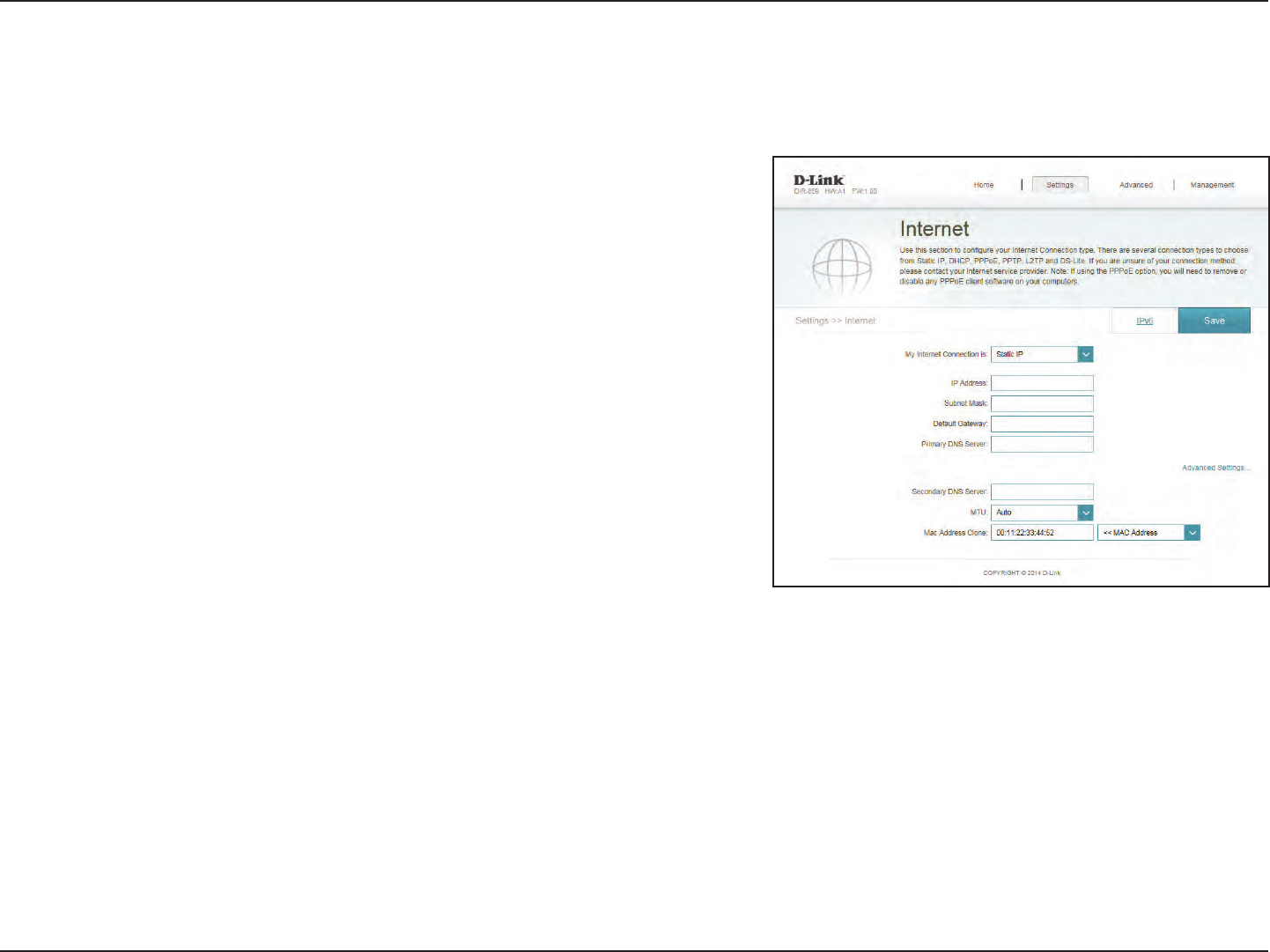
28D-Link DIR-859 User Manual
Section 4 - Conguration
Enter the IP address provided by your ISP.
Enter the subnet mask provided by your ISP.
Enter the default gateway address provided by your ISP.
Enter the primary DNS server IP address assigned by your ISP.
Enter the secondary DNS server IP address assigned by your ISP.
Maximum Transmission Unit - you may need to change the MTU for
optimal performance with your ISP.
The default MAC address is set to the Internet port’s physical interface
MAC address on the router. You can use drop-down menu to replace
the Internet port’s MAC address with the MAC address of a connected
client.
Click Save when you are done.
IP Address:
Subnet Mask:
Default
Gateway:
Primary DNS
Server:
Secondary DNS
Server:
MTU:
MAC Address
Clone:
Static IP
Select Static IP if your IP information is provided by your Internet service provider (ISP).
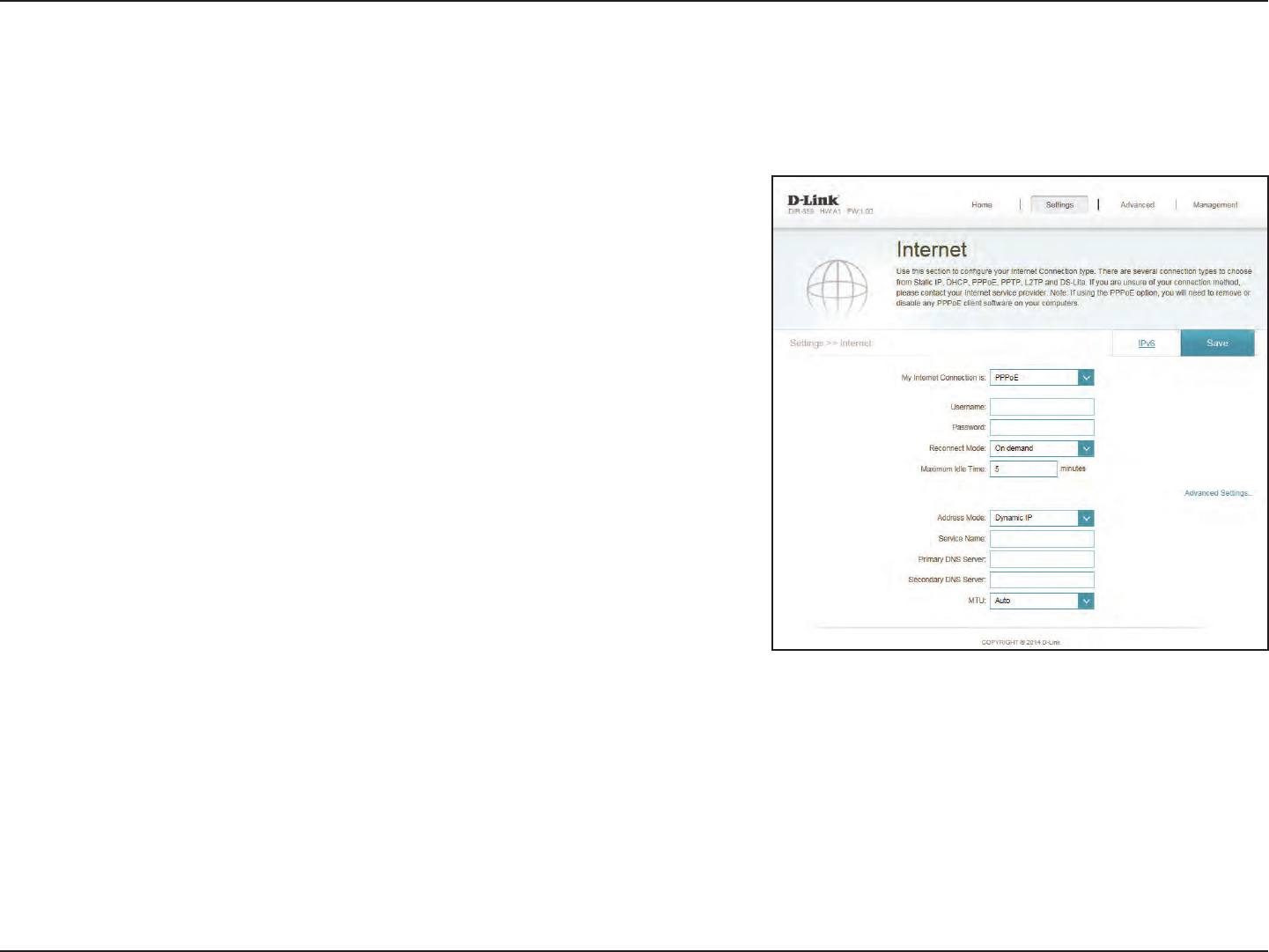
29D-Link DIR-859 User Manual
Section 4 - Conguration
Enter the username provided by your ISP.
Enter the password provided by your ISP.
Select either Always-on, On-Demand, or Manual.
Enter a maximum idle time during which the Internet connection
is maintained during inactivity. To disable this feature, enable Auto-
reconnect.
Select Static IP if your ISP assigned you the IP address, subnet mask,
gateway, and DNS server addresses. In most cases, select Dynamic IP.
Enter the IP address provided by your ISP (Static IP only).
Enter the ISP service name (optional).
Enter the primary DNS server IP address assigned by your ISP.
Enter the secondary DNS server IP address assigned by your ISP.
Maximum Transmission Unit - you may need to change the MTU for
optimal performance with your ISP.
Click Save when you are done.
Username:
Password:
Reconnect
Mode:
Maximum Idle
Time:
Address Mode:
IP Address:
Service Name:
Primary DNS
Server:
Secondary DNS
Server:
MTU:
Select PPPoE if your Internet connection requires you to enter a username and password. This information is provided by your Internet service
provider (ISP).
PPPoE
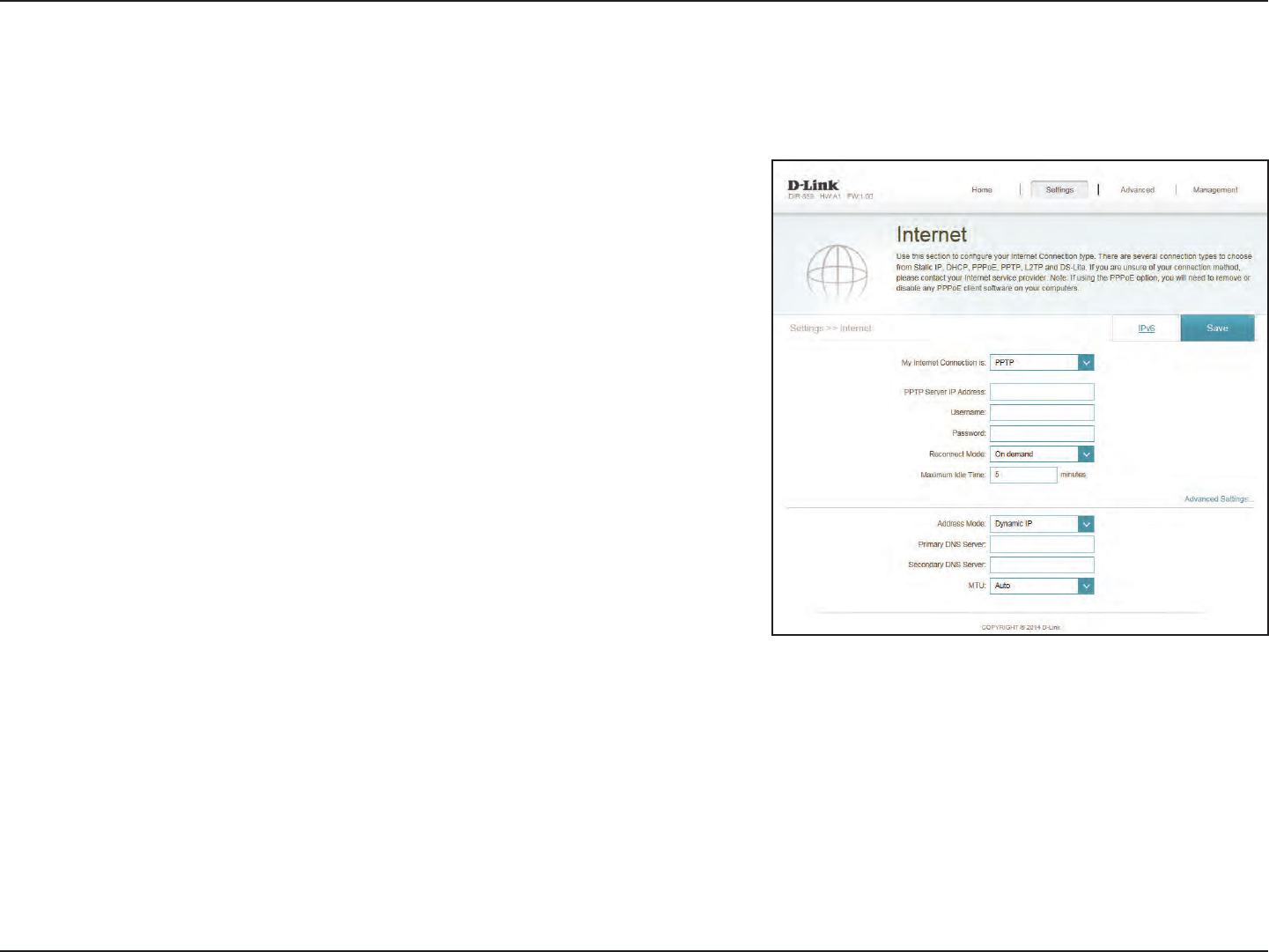
30D-Link DIR-859 User Manual
Section 4 - Conguration
Enter the PPTP server IP address provided by your ISP.
Enter the username provided by your ISP.
Enter the password provided by your ISP.
Select either Always-on, On-Demand, or Manual.
Enter a maximum idle time during which the Internet connection
is maintained during inactivity. To disable this feature, enable Auto-
reconnect.
Select Static IP if your ISP assigned you the IP address, subnet mask,
gateway, and DNS server addresses. In most cases, select Dynamic IP.
Enter the IP address provided by your ISP (Static IP only).
Enter the subnet mask provided by your ISP (Static IP only).
Enter the gateway IP address provided by your ISP (Static IP only).
Enter the primary DNS server IP address assigned by your ISP.
PPTP Server IP
Address:
Username:
Password:
Reconnect
Mode:
Maximum Idle
Time:
Address Mode:
PPTP IP
Address:
PPTP Subnet
Mask:
PPTP Gateway
IP Address:
Primary DNS
Server:
Choose PPTP (Point-to-Point-Tunneling Protocol ) if your Internet Service Provider (ISP) uses a PPTP connection. Your ISP will provide you with a
username and password.
PPTP

31D-Link DIR-859 User Manual
Section 4 - Conguration
Enter the secondary DNS server IP address assigned by your ISP.
Maximum Transmission Unit - you may need to change the MTU for
optimal performance with your ISP.
Click Save when you are done.
Secondary DNS
Server:
MTU:
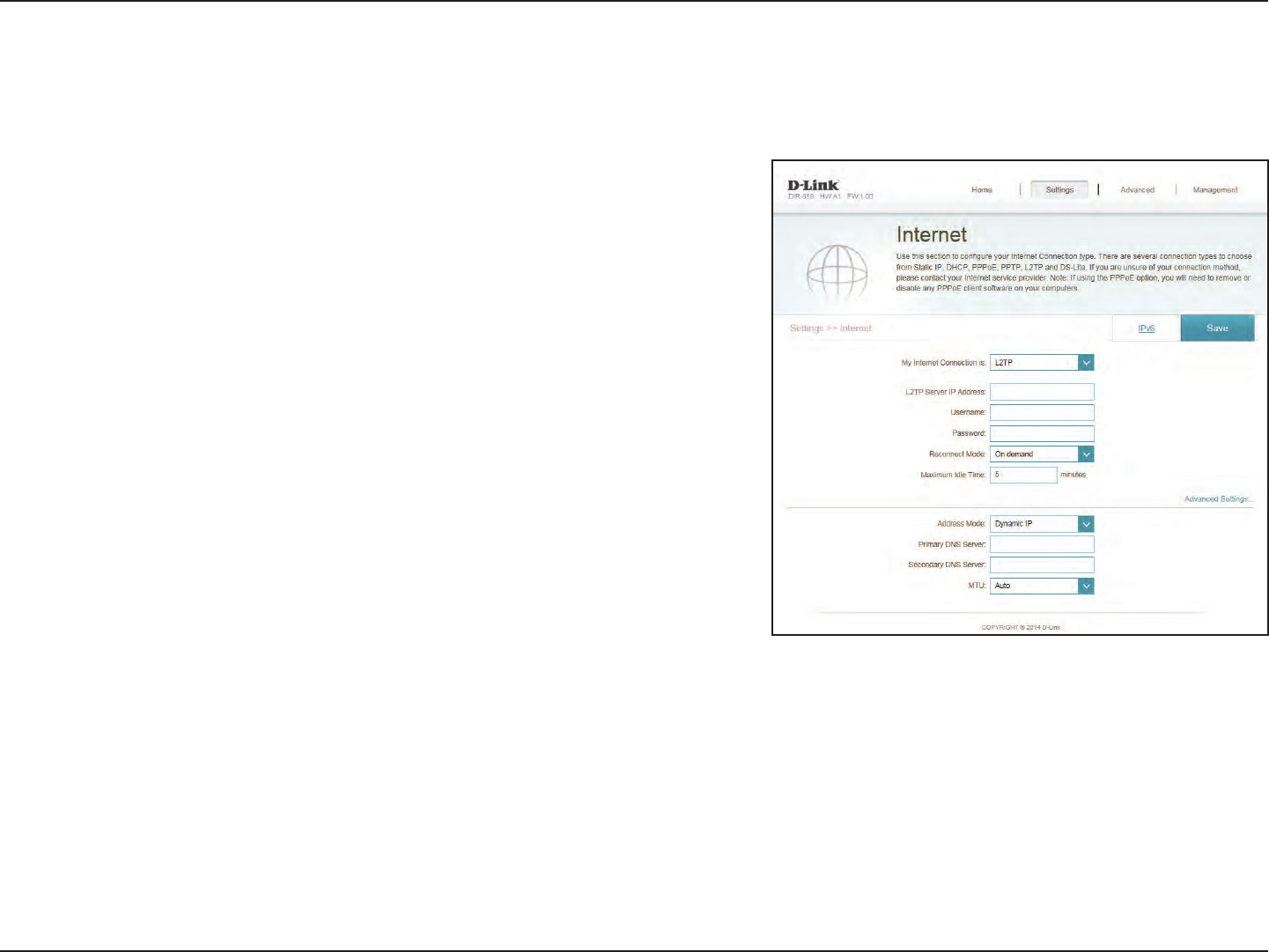
32D-Link DIR-859 User Manual
Section 4 - Conguration
L2TP
Enter the L2TP server IP address provided by your ISP.
Enter the username provided by your ISP.
Enter the password provided by your ISP.
Select either Always-on, On-Demand, or Manual.
Enter a maximum idle time during which the Internet connection
is maintained during inactivity. To disable this feature, enable Auto-
reconnect.
Select Static IP if your ISP assigned you the IP address, subnet mask,
gateway, and DNS server addresses. In most cases, select Dynamic IP.
Enter the IP address provided by your ISP (Static IP only).
Enter the subnet mask provided by your ISP (Static IP only).
Enter the gateway IP address provided by your ISP (Static IP only).
Enter the primary DNS server IP address assigned by your ISP.
L2TP Server IP
Address:
Username:
Password:
Reconnect
Mode:
Maximum Idle
Time:
Address Mode:
L2TP IP
Address:
L2TP Subnet
Mask:
L2TP Gateway
IP Address:
Primary DNS
Server:
Choose L2TP (Layer 2 Tunneling Protocol) if your Internet Service Provider (ISP) uses a L2TP connection. Your ISP will provide you with a username
and password.
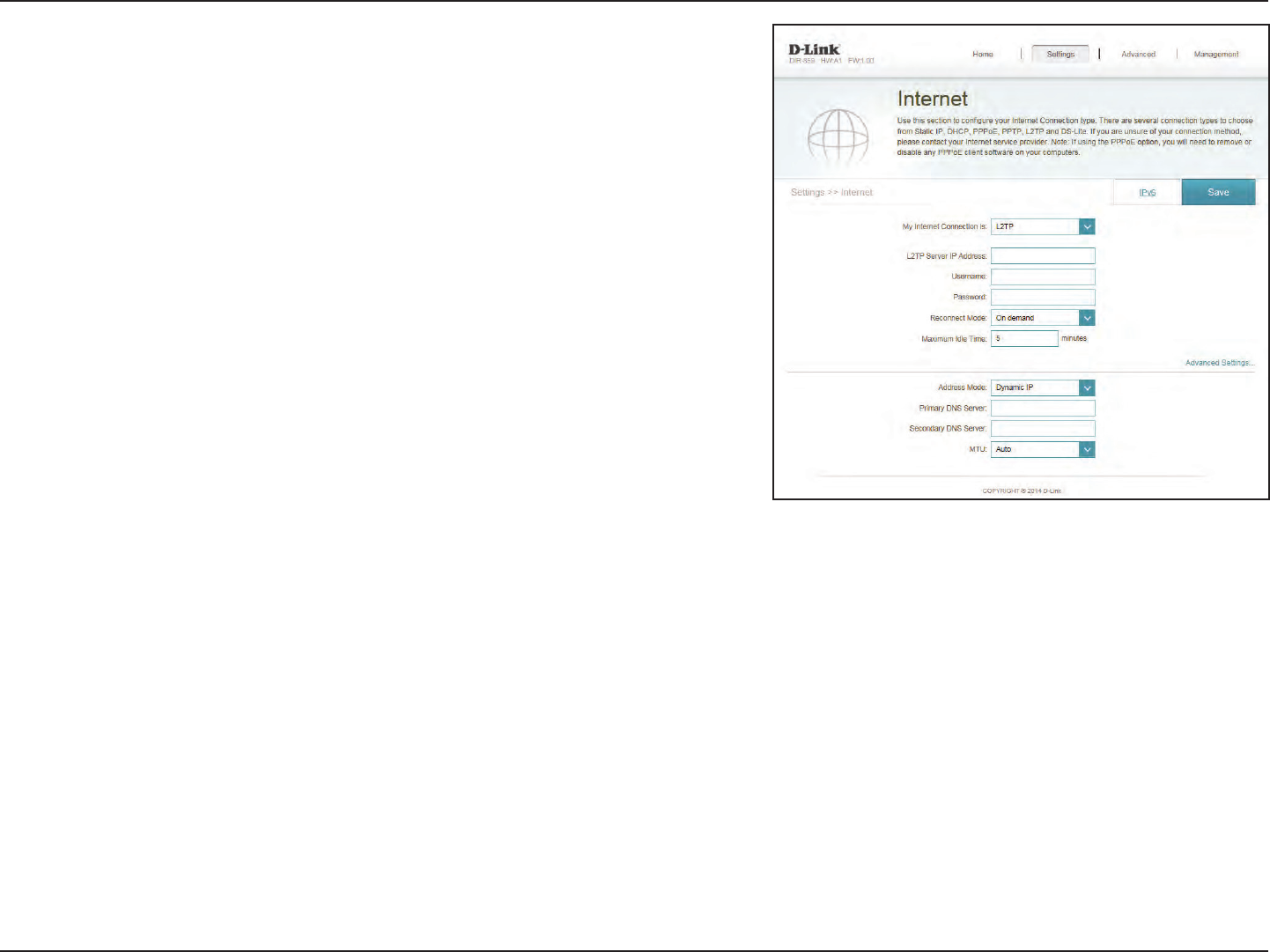
33D-Link DIR-859 User Manual
Section 4 - Conguration
Enter the secondary DNS server IP address assigned by your ISP.
Maximum Transmission Unit - you may need to change the MTU for
optimal performance with your ISP.
Click Save when you are done.
Secondary DNS
Server:
MTU:
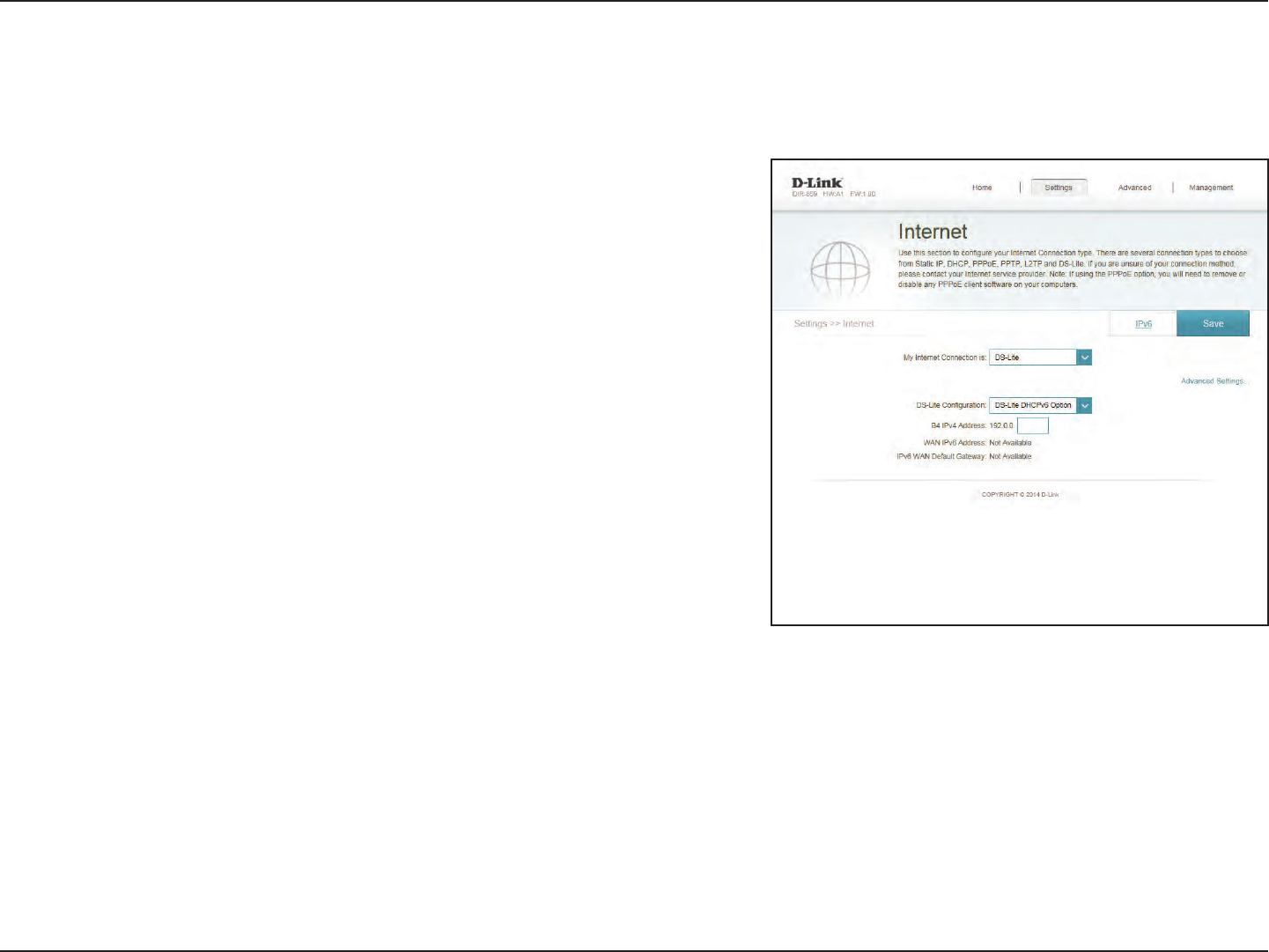
34D-Link DIR-859 User Manual
Section 4 - Conguration
DS-Lite
Select DS-Lite DHCPv6 to let the router allocate the AFTR IPv6
address automatically. Select Manual Conguration to enter the
AFTR IPv6 address manually.
If you selected Manual Conguration above, enter the AFTR IPv6
address used here.
Enter the B4 IPv4 address value used here.
Once connected, the WAN IPv6 address will be displayed here.
Once connected, the IPv6 WAN default gateway address will be
displayed here.
Click Save when you are done.
DS-Lite
Conguration:
AFTR IPv6
Address:
B4 IPv6
Address:
WAN IPv6
Address:
IPv6 WAN
Default
Gateway:
DS-Lite is an IPv6 connection type. After selecting DS-Lite, the following parameters will be available for conguration:
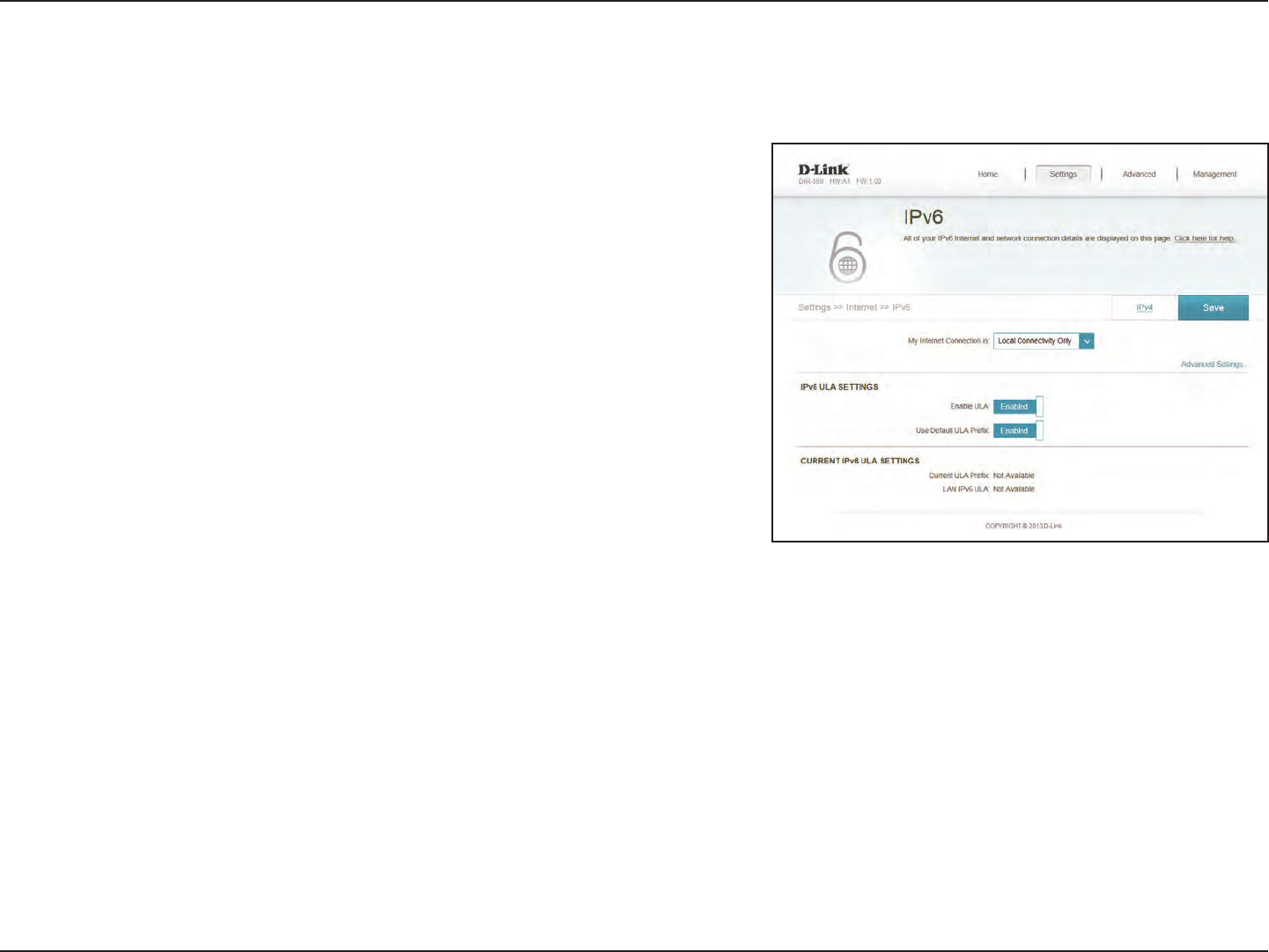
35D-Link DIR-859 User Manual
Section 4 - Conguration
IPv6
To congure an IPv6 connection, click the IPv6 link. To return to the IPv4 settings, click IPv4.
Choose your IPv6 connection type from the drop-down menu. You
will be presented with the appropriate options for your connection
type. Click Advanced Settings... to expand the list and see all of
the options.
My Internet
Connection Is:
For Auto Detection refer to page 36.
For Static IPv6 refer to page 38.
For Auto Conguration (SLAAC/DHCPv6) refer to page 40.
For PPPoE refer to page 42.
For IPv6 in IPv4 Tunnel refer to page 44.
For 6 to 4 refer to page 46.
For 6rd refer to page 47.
For Local Connectivity Only refer to page 49.
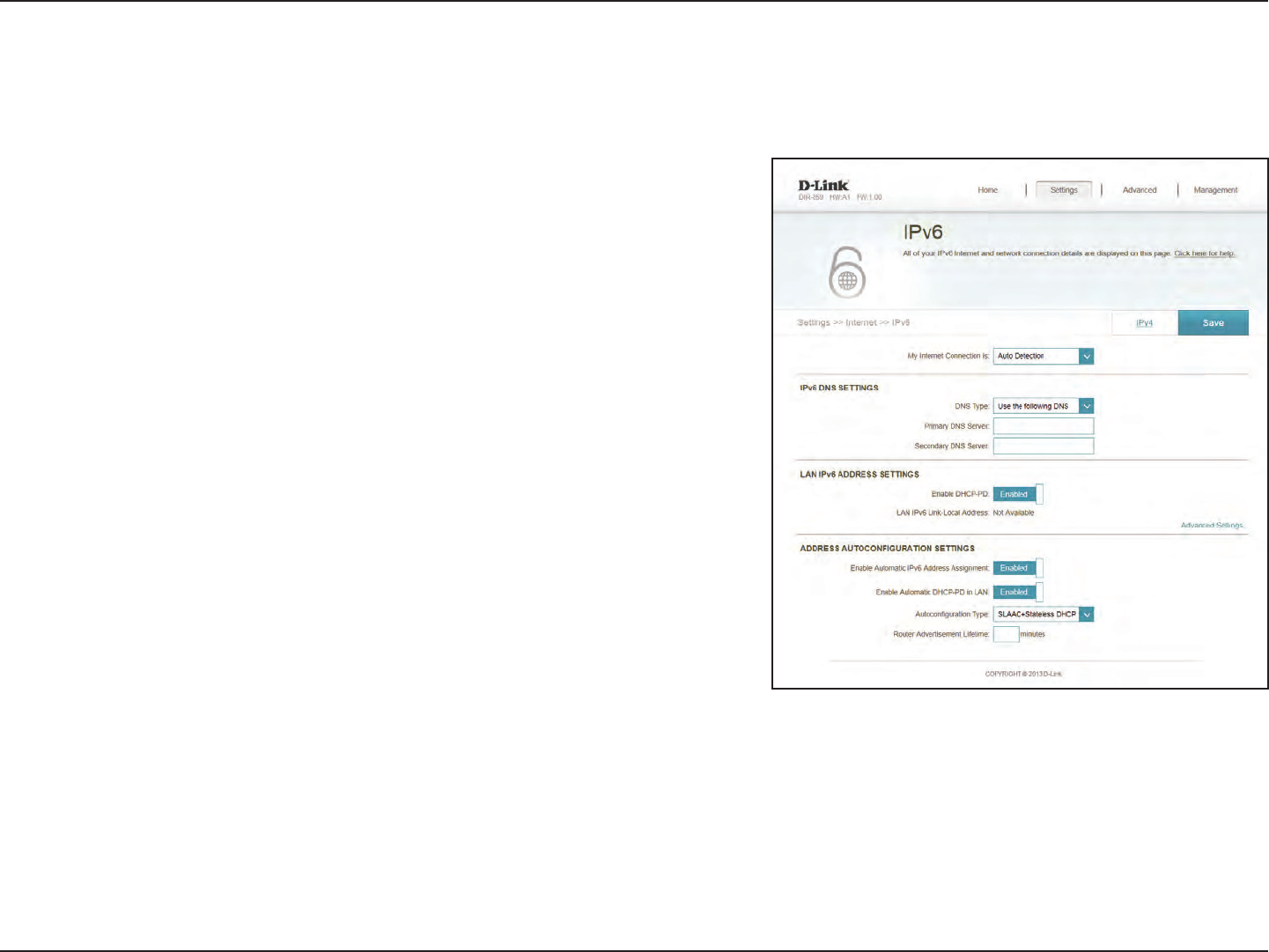
36D-Link DIR-859 User Manual
Section 4 - Conguration
Auto Detection
Select either Obtain DNS server address automatically or Use the
following DNS address.
If you selected Use the following DNS address above, enter the
primary DNS server address.
If you selected Use the following DNS address above, enter the
secondary DNS server address.
Enable or disable prex delegation services.
If you disabled DHCP-PD, enter the LAN (local) IPv6 address for the
router.
Displays the router’s LAN link-local address.
Enable or disable the Automatic IPv6 Address Assignment feature.
Enable or disable automatic DHCP-PD services.
DNS Type:
Primary DNS
Server:
Secondary DNS
Server:
Enable DHCP-
PD:
LAN IPv6
Address:
LAN IPv6 Link-
Local Address:
Enable
Automatic
IPv6 Address
Assignment:
Enable
Automatic
DHCP-PD in
LAN:
This is a connection method where the ISP assigns your IPv6 address when your router requests one from the ISP’s server. Some ISPs require you
to make some settings on your side before your router can connect to the IPv6 Internet.
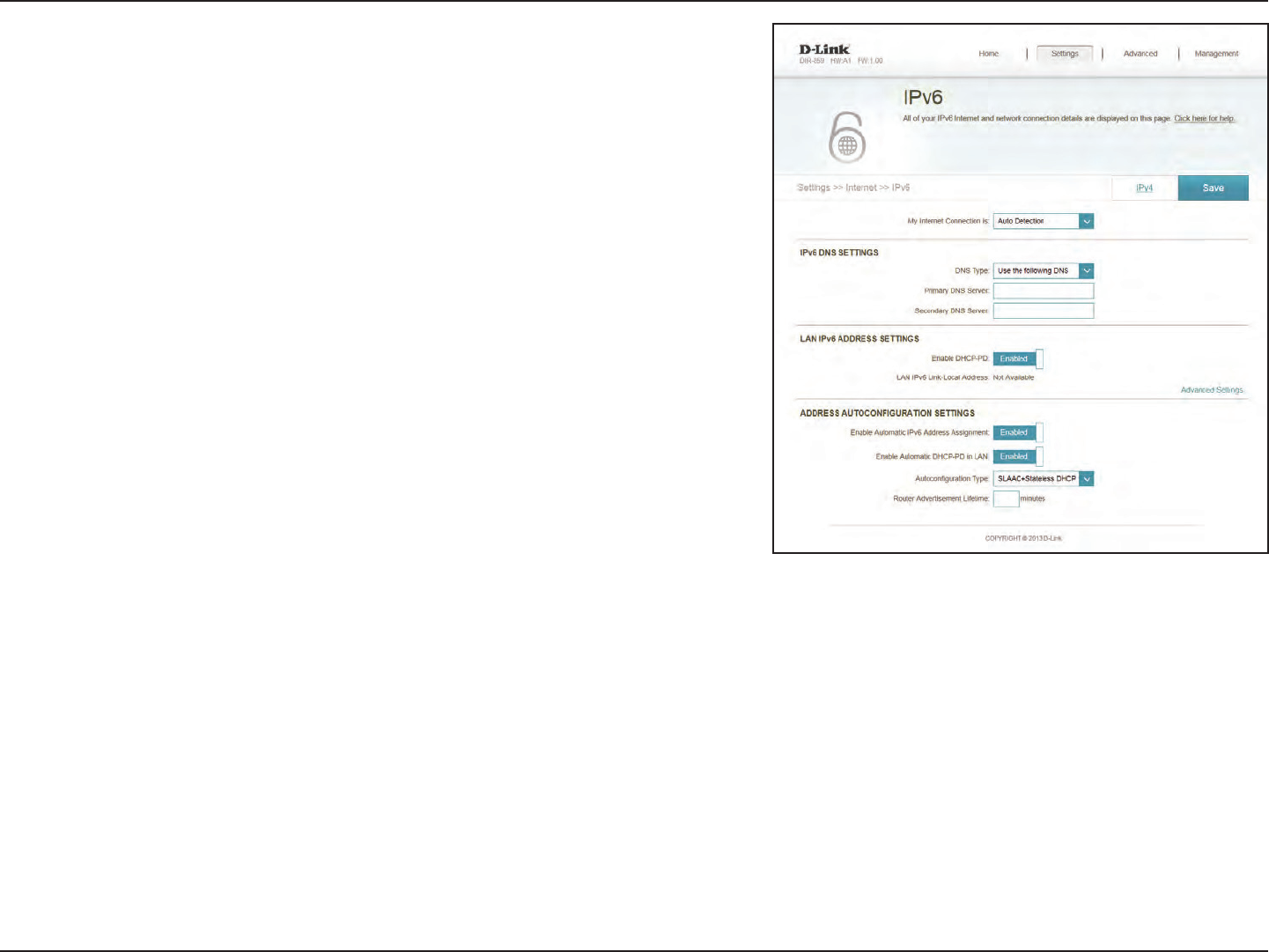
37D-Link DIR-859 User Manual
Section 4 - Conguration
Select Stateful (DHCPv6), SLAAC + RDNSS or SLAAC + Stateless
DHCPv6.
Enter the IPv6 address lifetime (in minutes).
Click Save when you are done.
Auto
Conguration
Type:
Router
Advertisement
Lifetime:
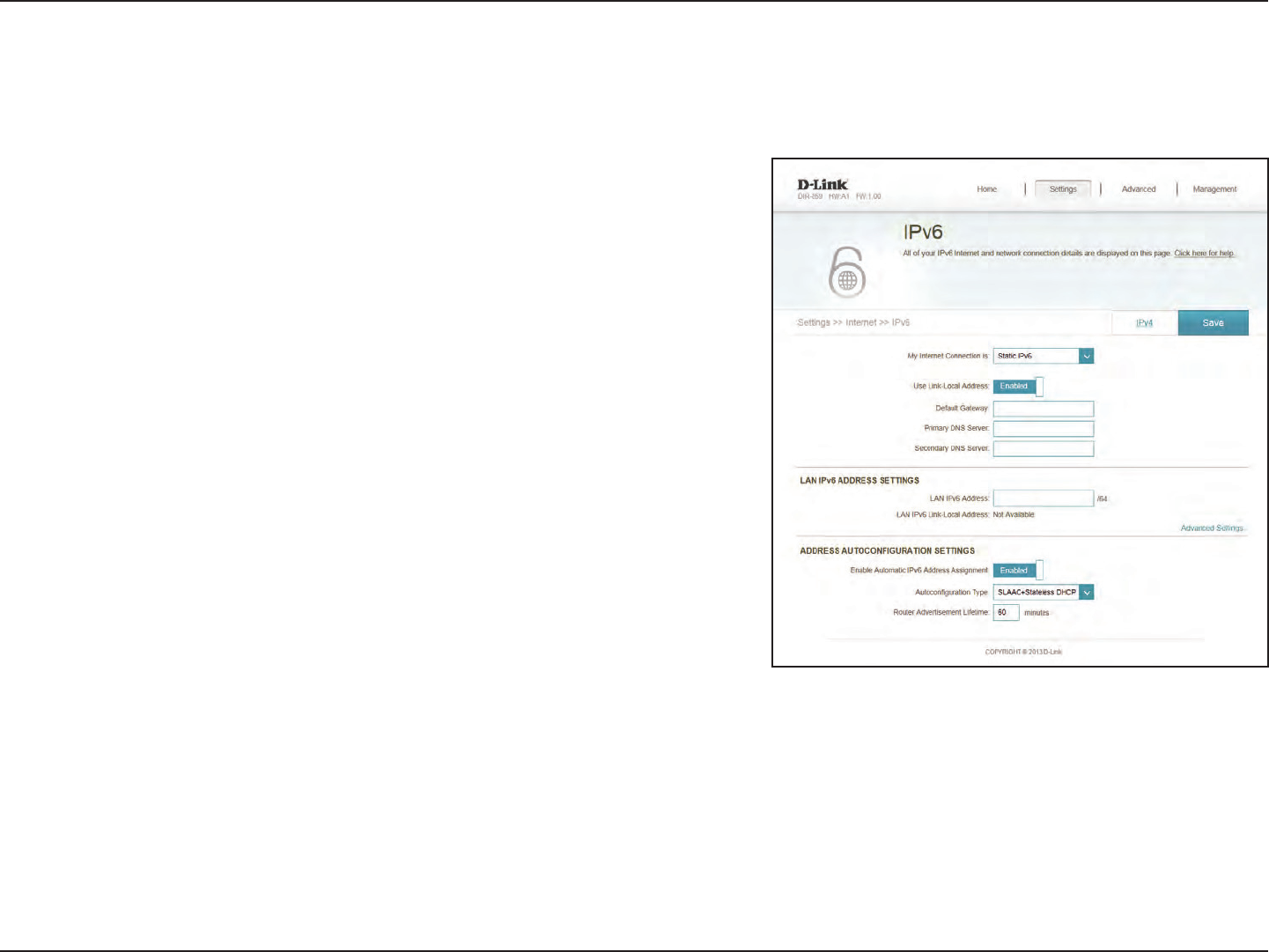
38D-Link DIR-859 User Manual
Section 4 - Conguration
Static IPv6
Enable or disable a link-local address.
If you disabled Use Link-Local Address, enter the address supplied
by your ISP.
If you disabled Use Link-Local Address, enter the subnet prex
length supplied by your ISP.
Enter the default gateway for your IPv6 connection.
Enter the primary DNS server address.
Enter the secondary DNS server address.
Enter the LAN (local) IPv6 address for the router.
Displays the router’s LAN link-local address.
Check to enable the Automatic IPv6 Address Assignment feature.
Use Link-Local
Address:
IPv6 Address:
Subnet Prex
Length:
Default
Gateway:
Primary DNS
Server:
Secondary DNS
Server:
LAN IPv6
Address:
LAN IPv6 Link-
Local Address:
Enable
Automatic
IPv6 Address
Assignment:
Select Static IP if your IPv6 information is provided by your Internet service provider (ISP).

39D-Link DIR-859 User Manual
Section 4 - Conguration
Select Stateful (DHCPv6), SLAAC + RDNSS or SLAAC + Stateless
DHCPv6.
Enter the IPv6 address lifetime (in minutes).
Click Save when you are done.
Auto
Conguration
Type:
Router
Advertisement
Lifetime:
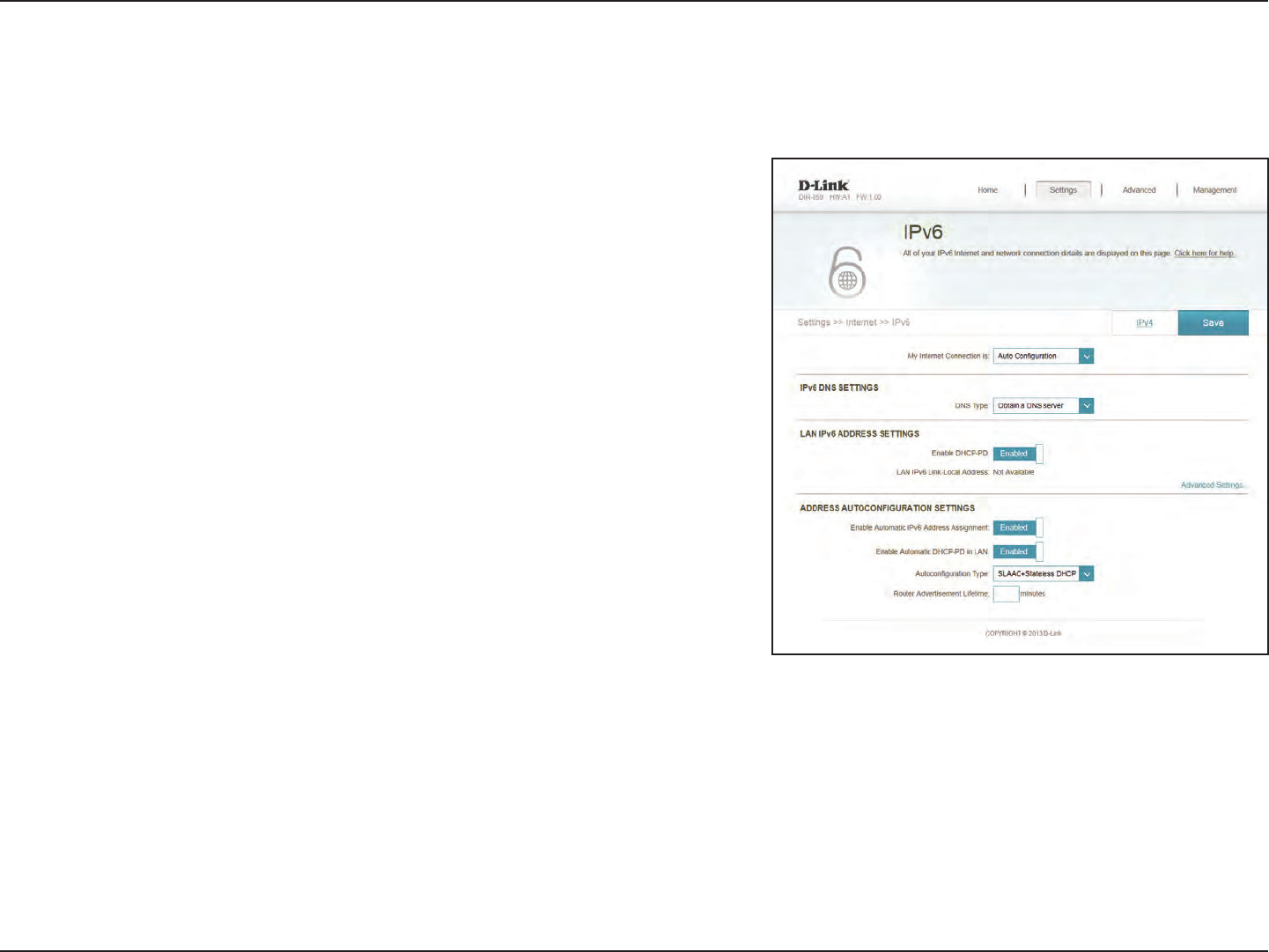
40D-Link DIR-859 User Manual
Section 4 - Conguration
Auto Conguration (SLAAC/DHCPv6)
Select either Obtain DNS server address automatically or Use the
following DNS address.
If you selected Use the following DNS address above, enter the
primary DNS server address.
If you selected Use the following DNS address above, enter the
secondary DNS server address.
Enable or disable prex delegation services.
If you disabled DHCP-PD, enter the LAN (local) IPv6 address for the
router.
Displays the router’s LAN link-local address.
Enable or disable the Automatic IPv6 Address Assignment feature.
Enable or disable automatic DHCP-PD services.
DNS Type:
Primary DNS
Server:
Secondary DNS
Server:
Enable DHCP-
PD:
LAN IPv6
Address:
LAN IPv6 Link-
Local Address:
Enable
Automatic
IPv6 Address
Assignment:
Enable
Automatic
DHCP-PD in
LAN:
This is a connection method where the ISP assigns your IPv6 address when your router requests one from the ISP’s server. Some ISPs require you
to make some settings on your side before your router can connect to the IPv6 Internet.
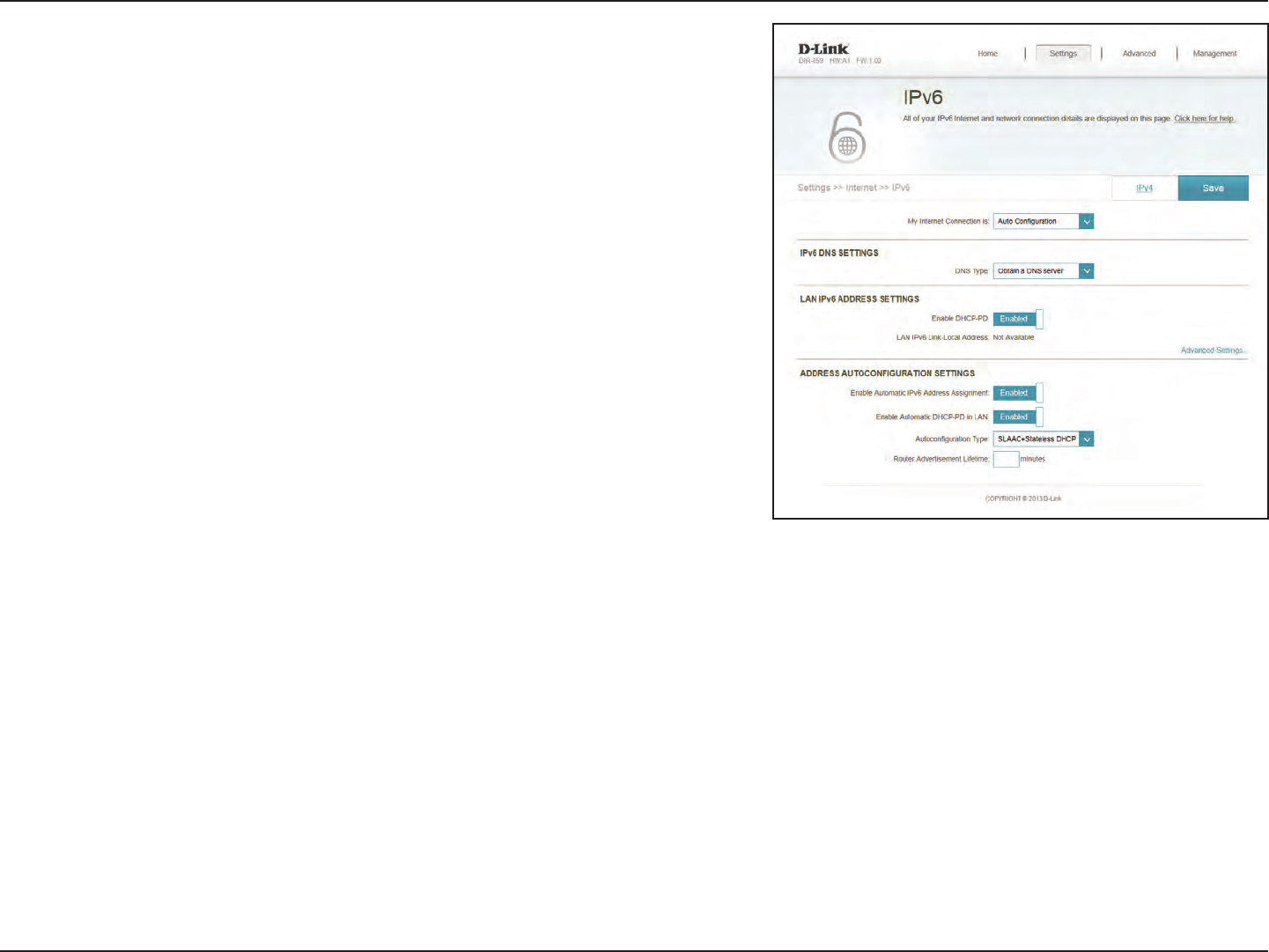
41D-Link DIR-859 User Manual
Section 4 - Conguration
Select Stateful (DHCPv6), SLAAC + RDNSS or SLAAC + Stateless
DHCPv6.
Enter the IPv6 address lifetime (in minutes).
Click Save when you are done.
Auto
Conguration
Type:
Router
Advertisement
Lifetime:

42D-Link DIR-859 User Manual
Section 4 - Conguration
PPPoE
Choose Share with IPv4 to re-use your IPv4 PPPoE username and
password, or Create a new session.
If you selected Create a new session above, enter the PPPoE
username provided by your ISP here.
If you selected Create a new session above, enter the PPPoE
password provided by your ISP here.
Select Static IP if your ISP assigned you the IP address, subnet mask,
gateway, and DNS server addresses. In most cases, select Dynamic IP.
Enter the IP address provided by your ISP (Static IP only).
Maximum Transmission Unit - you may need to change the MTU for
optimal performance with your ISP.
Select either Obtain DNS server address automatically or Use the
following DNS address.
If you selected Use the following DNS address above, enter the
primary DNS server address.
If you selected Use the following DNS address above, enter the
secondary DNS server address.
Enable or disable prex delegation services.
PPPoE Session:
Username:
Password:
Address Mode:
IP Address:
MTU:
DNS Type:
Primary DNS
Server:
Secondary DNS
Server:
Enable DHCP-
PD:
Select PPPoE if your Internet connection requires you to enter a username and password. This information is provided by your Internet service
provider (ISP).
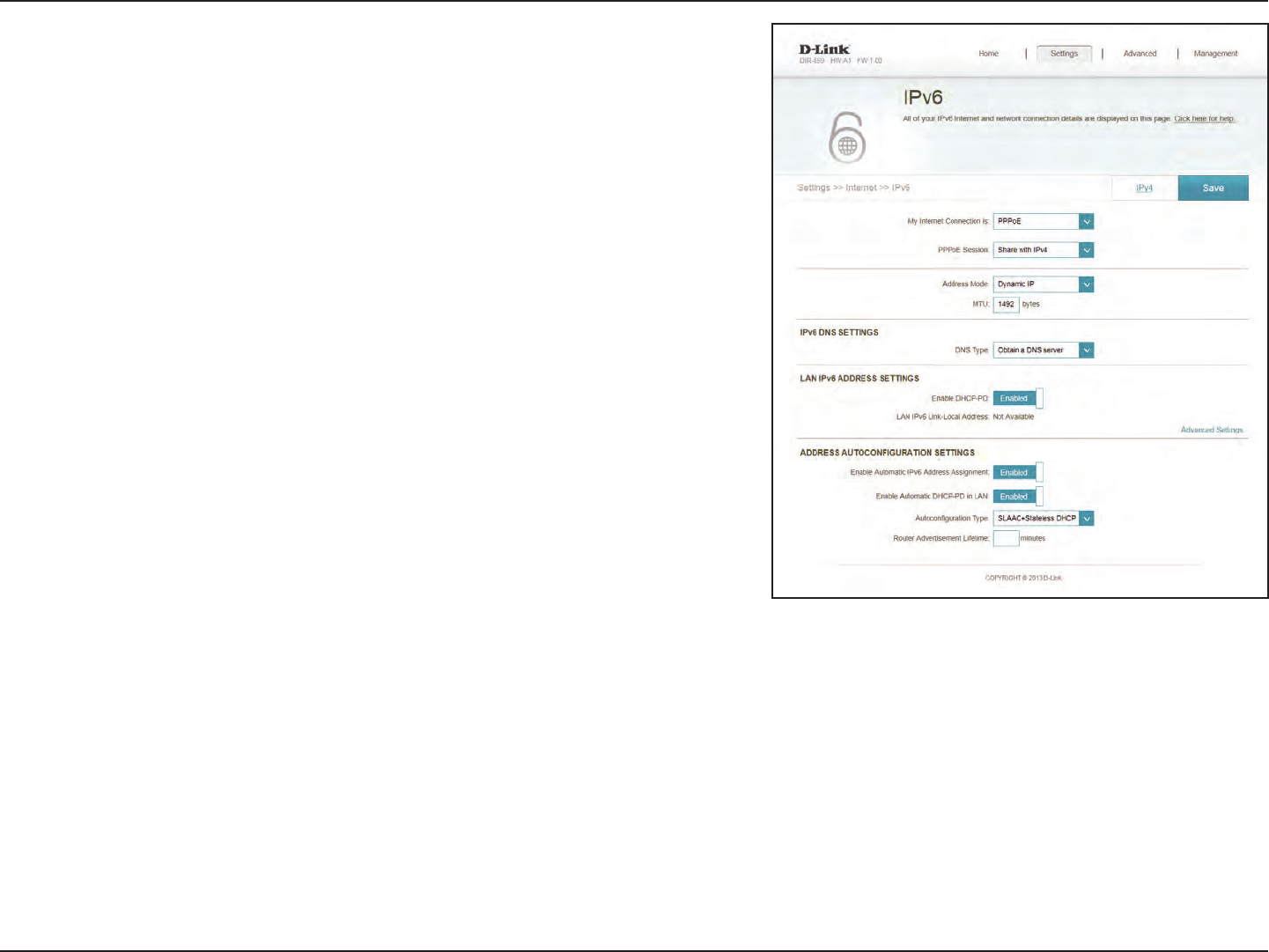
43D-Link DIR-859 User Manual
Section 4 - Conguration
Enter the LAN (local) IPv6 address for the router.
Displays the router’s LAN link-local address.
Enable or disable the Automatic IPv6 Address Assignment feature.
Select Stateful (DHCPv6), SLAAC + RDNSS or SLAAC + Stateless
DHCPv6.
Enter the IPv6 address lifetime (in minutes).
Click Save when you are done.
LAN IPv6
Address:
LAN IPv6 Link-
Local Address:
Enable
Automatic
IPv6 Address
Assignment:
Auto
Conguration
Type:
Router
Advertisement
Lifetime:
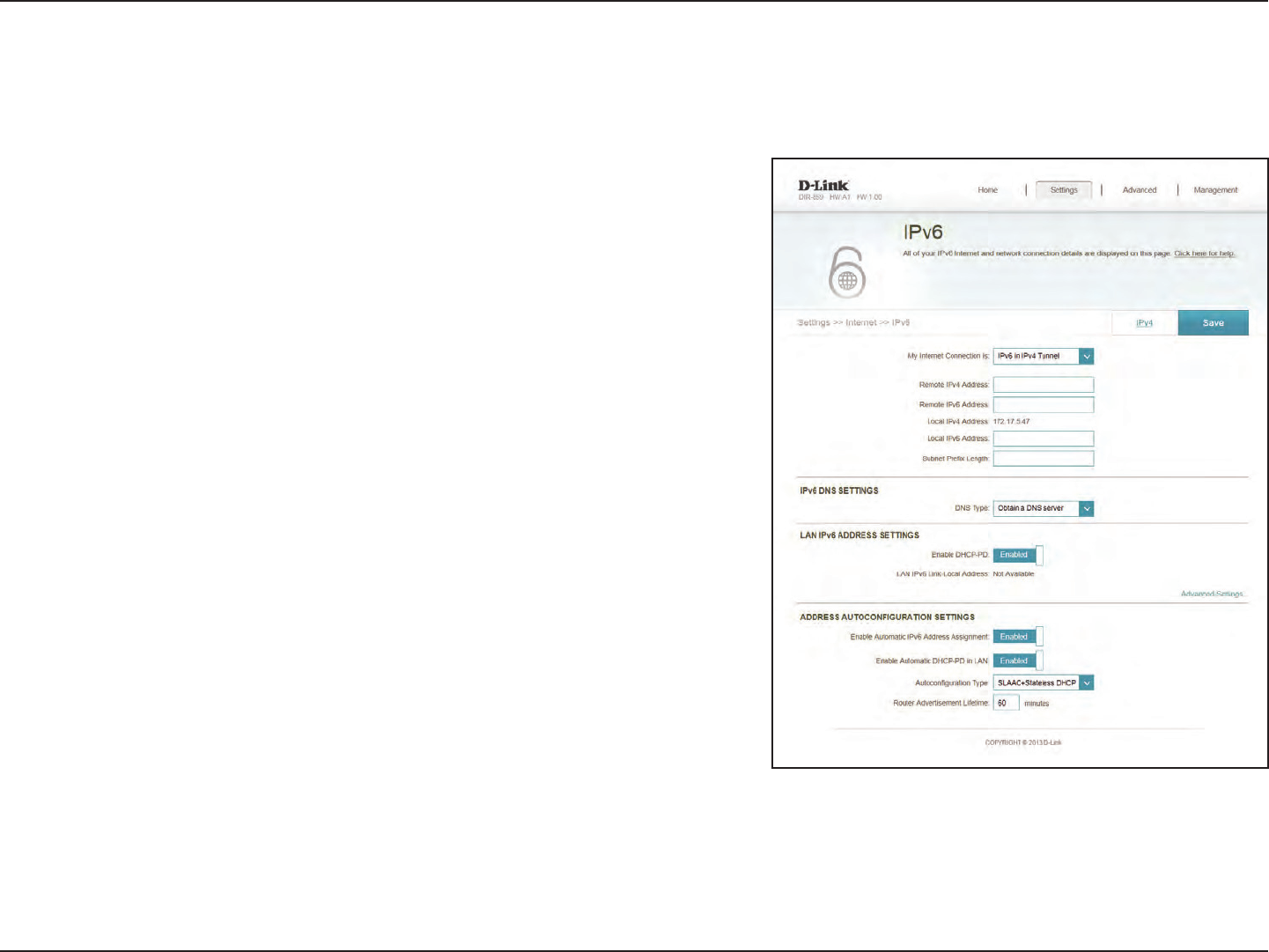
44D-Link DIR-859 User Manual
Section 4 - Conguration
IPv6 in IPv4 Tunnel
Enter the IPv4 remote address you will use.
Enter the IPv6 remote address you will use.
Enter the IPv4 local address you will use.
Enter the IPv6 local address you will use.
Enter the subnet prex length supplied by your ISP.
Select either Obtain DNS server address automatically or Use the
following DNS address.
If you selected Use the following DNS address above, enter the
primary DNS server address.
If you selected Use the following DNS address above, enter the
secondary DNS server address.
Enable or disable prex delegation services.
If you disabled DHCP-PD, enter the LAN (local) IPv6 address for the
router.
Remote IPv4
Address:
Remote IPv6
Address:
Local IPv4
Address:
Local IPv6
Address:
Subnet Prex
Length:
DNS Type:
Primary DNS
Server:
Secondary DNS
Server:
Enable DHCP-
PD:
LAN IPv6
Address:
The user can congure the IPv6 connection to run in IPv4 Tunnel mode. IPv6 over IPv4 tunneling encapsulates IPv6 packets in IPv4 packets so
that IPv6 packets can be sent over an IPv4 infrastructure.
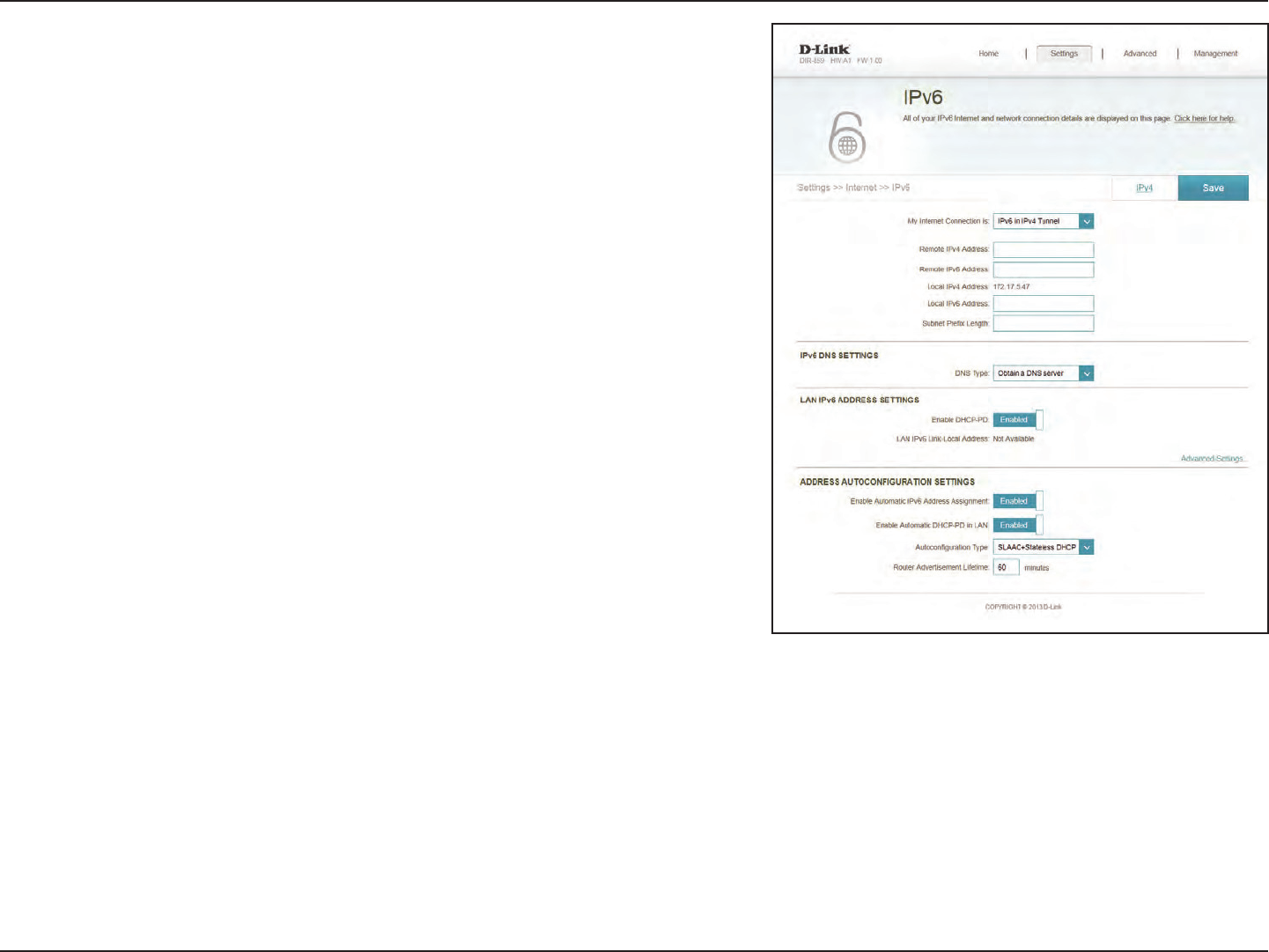
45D-Link DIR-859 User Manual
Section 4 - Conguration
Displays the router’s LAN link-local address.
Enable or disable the Automatic IPv6 Address Assignment feature.
Enable or disable automatic DHCP-PD services.
Select Stateful (DHCPv6), SLAAC + RDNSS or SLAAC + Stateless
DHCPv6.
Enter the IPv6 address lifetime (in minutes).
Click Save when you are done.
LAN IPv6 Link-
Local Address:
Enable
Automatic
IPv6 Address
Assignment:
Enable
Automatic
DHCP-PD in
LAN:
Auto
Conguration
Type:
Router
Advertisement
Lifetime:

46D-Link DIR-859 User Manual
Section 4 - Conguration
6to4
Displays the 6 to 4 address.
Enter the 6 to 4 relay supplied by your ISP.
Enter the primary DNS server address.
Enter the secondary DNS server address.
Enter the LAN (local) IPv6 address for the router.
Displays the router’s LAN link-local address.
Check to enable the Automatic IPv6 Address Assignment feature.
Select Stateful (DHCPv6), SLAAC + RDNSS or SLAAC + Stateless
DHCPv6.
Enter the IPv6 address lifetime (in minutes).
Click Save when you are done.
6 to 4 Address:
6 to 4 Relay:
Primary DNS
Server:
Secondary DNS
Server:
LAN IPv6
Address:
LAN IPv6 Link-
Local Address:
Enable
Automatic
IPv6 Address
Assignment:
Auto
Conguration
Type:
Router
Advertisement
Lifetime:
In this section the user can congure the IPv6 6 to 4 connection settings. 6to4 is an IPv6 address assignment and automatic tunneling technol-
ogy that is used to provide unicast IPv6 connectivity between IPv6 sites and hosts across the IPv4 Internet.

47D-Link DIR-859 User Manual
Section 4 - Conguration
6rd
Currently unsupported.
Enter the primary DNS server address.
Enter the secondary DNS server address.
Enable if you want to minimize the number of routes to the
destination by using a hub and spoke method of networking.
Choose the 6rd DHCPv4 Option to automatically discover and
populate the data values, or Manual Conguration to enter the
settings yourself.
Enter the 6rd IPv6 prex and mask length supplied by your ISP
(manual conguration only).
Enter the 6rd border relay IPv4 address settings supplied by your ISP
(manual conguration only).
Enter the LAN (local) IPv6 address for the router.
Displays the router’s LAN link-local address.
Assign IPv6
Prex:
Primary DNS
Server:
Secondary DNS
Server:
Enable Hub and
Spoke Mode:
6rd
Conguration:
6rd IPv6 Prex:
6rd Border
Relay IPv4
Address:
LAN IPv6
Address:
LAN IPv6 Link-
Local Address:
In this section the user can congure the IPv6 6rd connection settings.
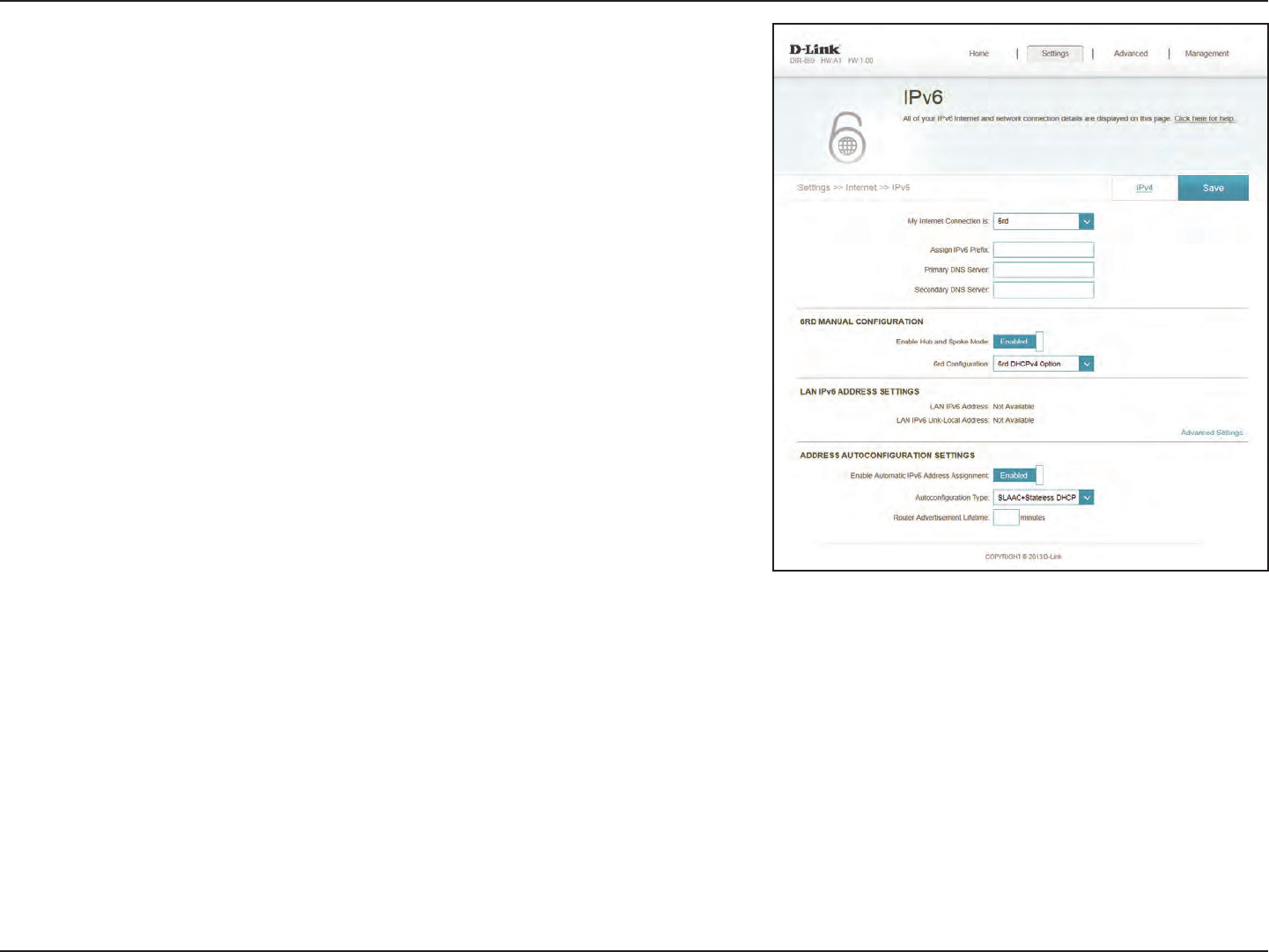
48D-Link DIR-859 User Manual
Section 4 - Conguration
Check to enable the Automatic IPv6 Address Assignment feature.
Select Stateful (DHCPv6), SLAAC + RDNSS or SLAAC + Stateless
DHCPv6.
Enter the IPv6 address lifetime (in minutes).
Click Save when you are done.
Enable
Automatic
IPv6 Address
Assignment:
Auto
Conguration
Type:
Router
Advertisement
Lifetime:

49D-Link DIR-859 User Manual
Section 4 - Conguration
Local Connectivity Only
Click here to enable Unique Local IPv6 Unicast Addresses settings.
Checking this box will automatically congure the ULA prex for
the default setting.
If you wish to choose your own ULA prex, enter it here.
This section will display the current settings for your IPv6 ULA.
Click Save when you are done.
Enable ULA:
Use Default
ULA Prex:
ULA Prex:
Current IPv6
ULA Settings:
Local Connectivity Only allows you to set up an IPv6 connection that will not connect to the Internet.
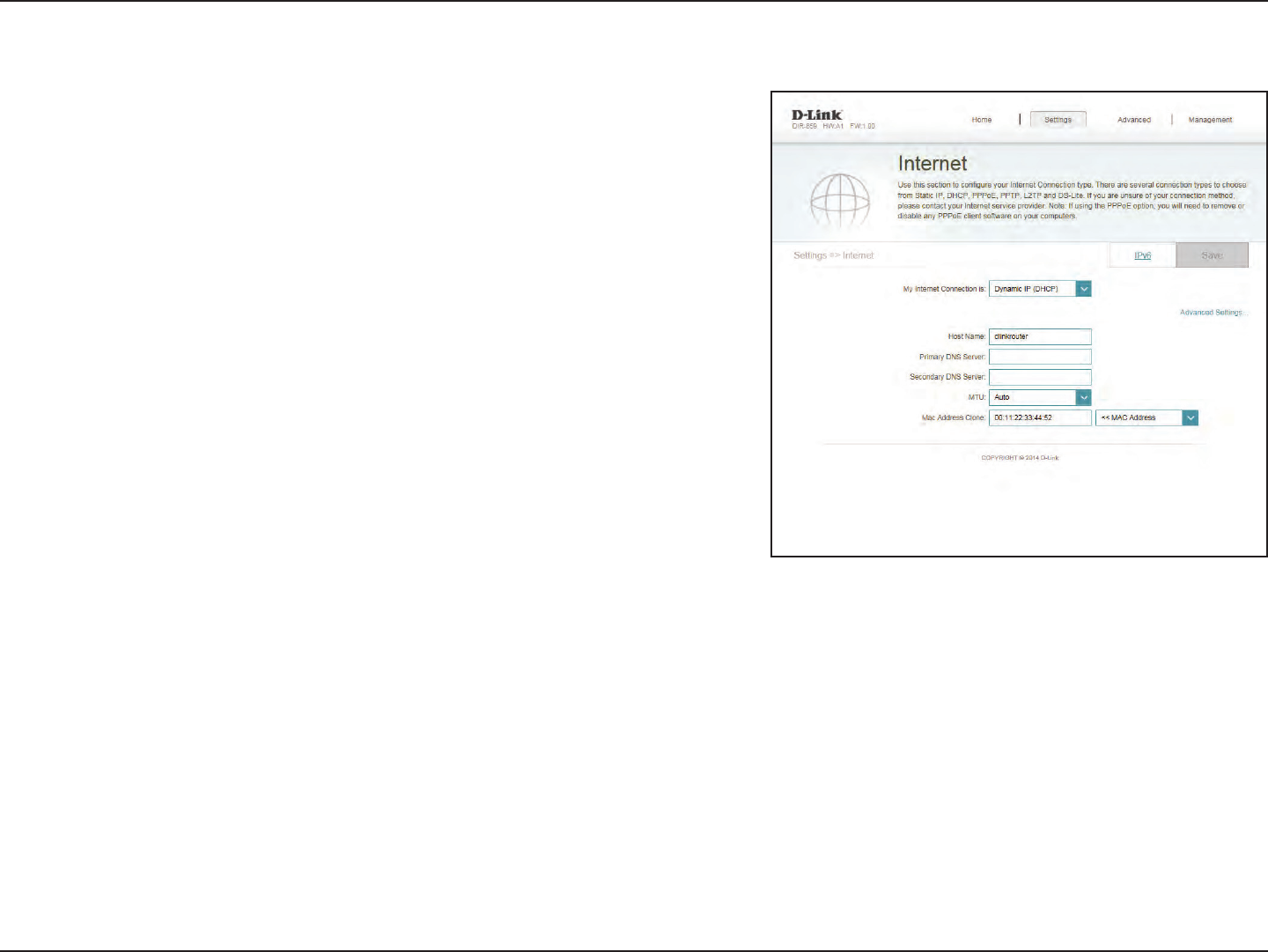
50D-Link DIR-859 User Manual
Section 4 - Conguration
Internet
In the Settings menu on the bar on the top of the page, click Internet to see the
Internet conguration options.
Choose your Internet connection type from the drop-down menu.
You will be presented with the appropriate options for your
connection type. Click Advanced Settings... to expand the list and
see all of the options.
My Internet
Connection Is:
For Dynamic IP (DHCP) refer to page 51.
For Static IP refer to page 52.

51D-Link DIR-859 User Manual
Section 4 - Conguration
The host name is optional but may be required by some ISPs. Leave
it blank if you are not sure.
Enter the primary DNS server IP address assigned by your ISP. This
address is usually obtained automatically from your ISP.
Enter the secondary DNS server IP address assigned by your ISP. This
address is usually obtained automatically from your ISP.
Maximum Transmission Unit - you may need to change the MTU for
optimal performance with your ISP.
Click Save when you are done.
Host Name:
Primary DNS
Server:
Secondary DNS
Server:
MTU:
Dynamic IP (DCHP)
Select Dynamic IP (DHCP) to obtain IP address information automatically from your Internet Service Provider (ISP). Select this option if your ISP
does not give you an IP address to use.

52D-Link DIR-859 User Manual
Section 4 - Conguration
Enter the IP address provided by your ISP.
Enter the subnet mask provided by your ISP.
Enter the default gateway address provided by your ISP.
Enter the primary DNS server IP address assigned by your ISP.
Enter the secondary DNS server IP address assigned by your ISP.
Maximum Transmission Unit - you may need to change the MTU for
optimal performance with your ISP.
Click Save when you are done.
IP Address:
Subnet Mask:
Default
Gateway:
Primary DNS
Server:
Secondary DNS
Server:
MTU:
Static IP
Select Static IP if your IP information is provided by your Internet service provider (ISP).
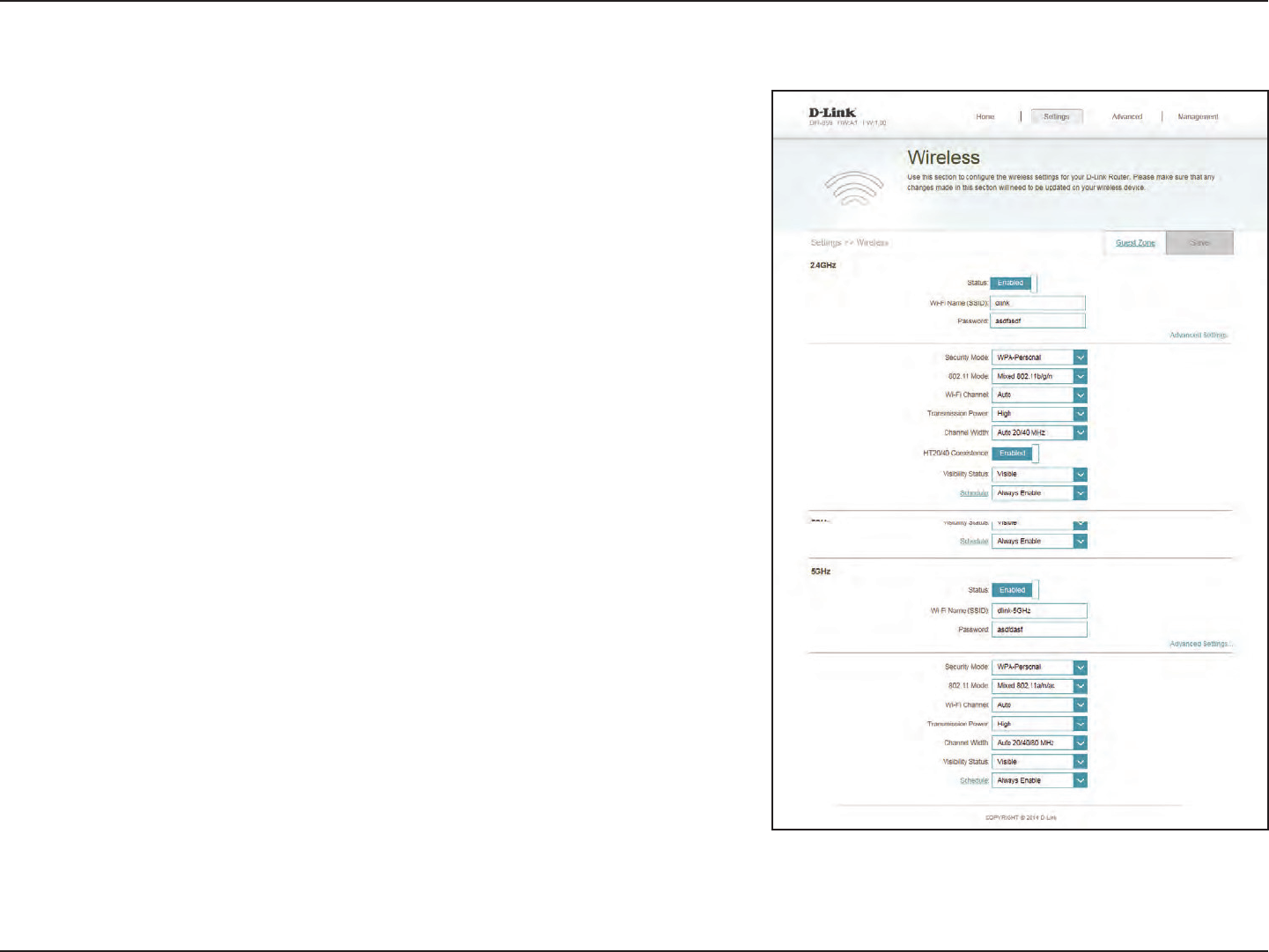
53D-Link DIR-859 User Manual
Section 4 - Conguration
Wireless
Enable or disable the wireless frequency band.
Create a name for your wireless network using up to 32 characters.
Create a password to use for wireless security. Wireless clients will
need to enter this password to successfully connect to the network.
Choose None, WEP, or WPA/WPA2-(Personal) (recommended).
Select the desired wireless networking standards to use. The available
options will depend on the wireless frequency band, as well as the
currently selected security mode.
Select the desired channel. The default is Auto (recommended).
Select the desired wireless transmission power.
Select Auto 20/40 if you are using both 802.11n and non-802.11n
wireless devices, or select 20 MHz if you are not using any 802.11n
wireless clients.
Enable this option to reduce interference from other wireless
networks in your area. If the channel width is operating at 40 MHz
and there is another wireless network’s channel over-lapping and
causing interference, the router will automatically change to 20 MHz.
Status:
Wi-Fi Name
(SSID):
Password:
Security Mode:
802.11 Mode:
Wi-Fi Channel:
Transmission
Power:
Channel Width:
HT20/40
Coexistence:
In the Settings menu on the bar on the top of the page, click Wireless to see the
wireless conguration options. To congure the router’s guest zone, click the Guest
Zone link. Refer to page 55 for details. Click Advanced Settings... to expand the list
and see all of the options. The following options apply to both the 2.4 GHz and the
5 GHz wireless frequency bands:

54D-Link DIR-859 User Manual
Section 4 - Conguration
The default setting is Visible. Select Invisible if you do not want to
broadcast the SSID of your wireless network.
Use the drop-down menu to select the time schedule that the rule
will be enabled on. The schedule may be set to Always Enable, or
you can create your own schedules in the Schedules section (refer
to page 69).
Click Save when you are done.
Visibility Status:
Schedule:
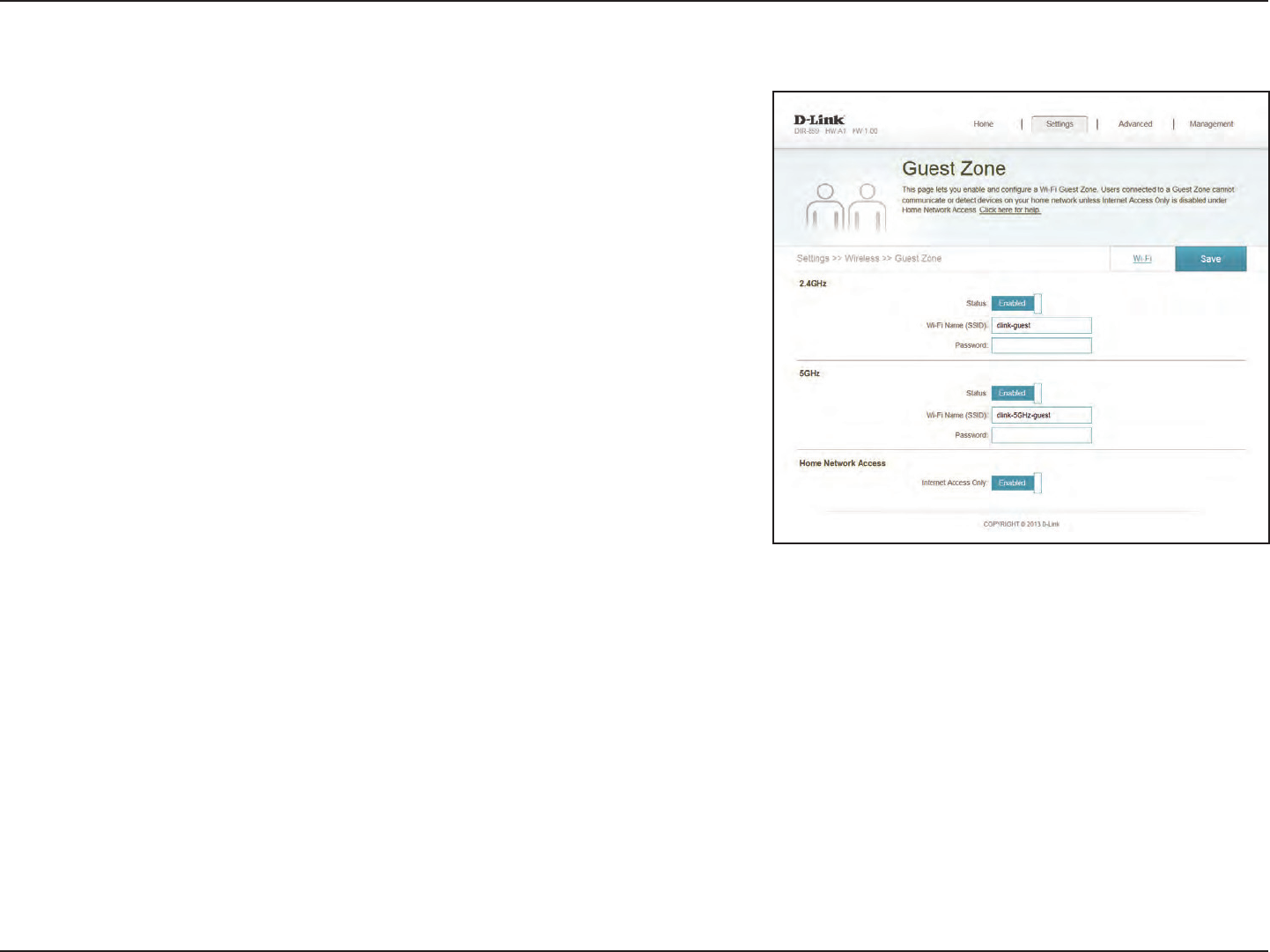
55D-Link DIR-859 User Manual
Section 4 - Conguration
Guest Zone
Enable or disable the guest zone for each wireless frequency band.
Enter a wireless network name (SSID) that is dierent from your main
wireless network.
Create a password to use for wireless security. Wireless clients will
need to enter this password to successfully connect to the guest zone.
Enabling this option will confine connectivity to the Internet,
disallowing guests from accessing other local network devices.
Click Save when you are done.
Status:
Wi-Fi Name
(SSID):
Password:
Internet Access
Only:
In the Settings menu on the bar on the top of the page, click Wireless, then click
the Guest Zone link. Click Advanced Settings... to expand the list and see all of
the options. The following options apply to both the 2.4 GHz and the 5 GHz wireless
frequency bands:
The guest zone feature will allow you to create temporary zones that can be used by
guests to access the Internet. These zones will be separate from your main wireless
network. You may congure dierent zones for the 2.4 GHz and 5 GHz wireless bands.

56D-Link DIR-859 User Manual
Section 4 - Conguration
Network
Enter the IP address of the router. The default IP address is
192.168.0.1.
If you change the IP address, once you click Save, you will need
to enter the new IP address in your browser to get back into the
conguration utility.
Enter the subnet mask of the router. The default subnet mask is
255.255.255.0.
The default address to access the router’s configuration is
http://dlinkrouter.local. Here, you can replace dlinkrouter with a
name of your choice.
Enter the domain name (optional).
Disable to transfer the DNS server information from your ISP to your
computers. If enabled, your computers will use the router for a DNS
server.
Enable or disable the DHCP server.
Enter the starting and ending IP addresses for the DHCP server’s IP
assignment.
Note: If you statically (manually) assign IP addresses to your computers
or devices, make sure the IP addresses are outside of this range or you
may have an IP conict.
LAN IP Address:
Subnet Mask:
Management
Link:
Local Domain
Name:
Enable DNS
Relay:
Status:
DHCP IP
Address Range:
This section will allow you to change the local network settings of the router and to
congure the DHCP settings. In the Settings menu on the bar on the top of the page,
click Network. Click Advanced Settings... to expand the list and see all of the options.
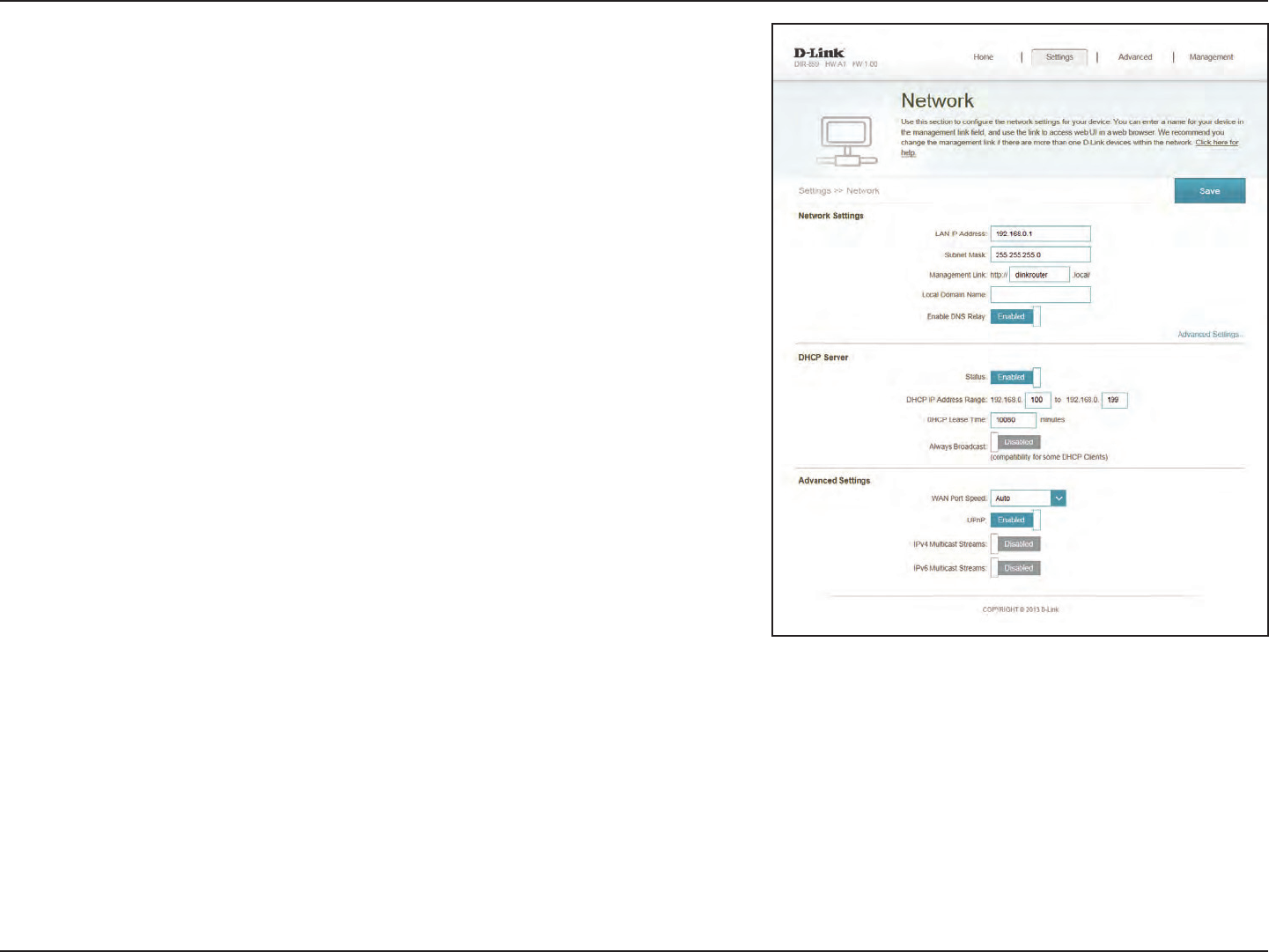
57D-Link DIR-859 User Manual
Section 4 - Conguration
DHCP Lease
Time:
Always
Broadcast:
WAN Port
Speed:
UPnP:
IPv4 Multicast
Stream:
IPv6 Multicast
Stream:
Enter the length of time for the IP address lease in minutes.
Enable this feature to broadcast your networks DHCP server to LAN/
WLAN clients.
You may set the port speed of the Internet port to 10 Mbps, 100
Mbps, 1000 Mbps, or Auto (recommended).
Enable or disable Universal Plug and Play (UPnP). UPnP provides
compatibility with networking equipment, software and peripherals.
Enable to allow IPv4 multicast trac to pass through the router from
the Internet.
Enable to allow IPv6 multicast trac to pass through the router from
the Internet.
Click Save when you are done.

58D-Link DIR-859 User Manual
Section 4 - Conguration
Advanced
QoS Engine
This section will allow you to prioritize particular clients over others, so that those
clients receive higher bandwidth. For example, if one client is streaming a movie
and another is downloading a non-urgent le, you might wish to assign the former
device a higher priority than the latter so that the movie streaming is not disrupted
by the trac of the other devices on the network.
In the Features menu on the bar on the top of the page, click QoS Engine.
Under All Devices, you will see device cards representing each connected client. If
some are o-screen, you can use the < and > buttons to scroll through the cards.
A maximum of one device can be assigned Highest priority.
A maximum of two devices can be assigned High priority.
A maximum of eight devices can be assigned Medium priority.
If no devices are explicitly assigned a priority, they will all be treated with equal
priority. If some devices are not assigned a priority and others are, the unassigned
devices will be treated with the lowest priority.
To assign a priority level to a device, drag the device card from the All Devices list
over an empty slot and release the mouse button. The card will remain in the slot.
If you want to remove a priority assignment from a device and return it to the All
Devices list, click the cross icon in the top right of the device card.
Click Save when you are done.

59D-Link DIR-859 User Manual
Section 4 - Conguration
Firewall Settings
Enable or disable Demilitarized Zone (DMZ). This completely exposes
the client to threats over the Internet, and is not recommended in
ordinary situations.
If you enabled DMZ, enter the IP address of the client you wish to
expose, or use the drop-down menu to quickly select it.
Enabling Stateful Packet Inspection (SPI) helps to prevent cyber
attacks by validating that the trac passing through the session
conforms to the protocol.
Enable this feature to protect your network from certain kinds of
“spoong” attacks.
Enable or disable IPv6 simple security.
Enable or disable IPv6 ingress ltering.
Allows multiple machines on the LAN to connect to their corporate
network using the PPTP protocol.
Enable DMZ:
DMZ IP
Address:
Enable SPI IPv4:
Enable
Anti-Spoof
Checking:
IPv6 Simple
Security:
IPv6 Ingress
Filtering:
PPTP:
The router’s rewall protects your network from malicious attacks over the Internet.
In the Advanced menu on the bar on the top of the page, click Firewall Settings.
Click Advanced Settings... to expand the list and see all of the options.
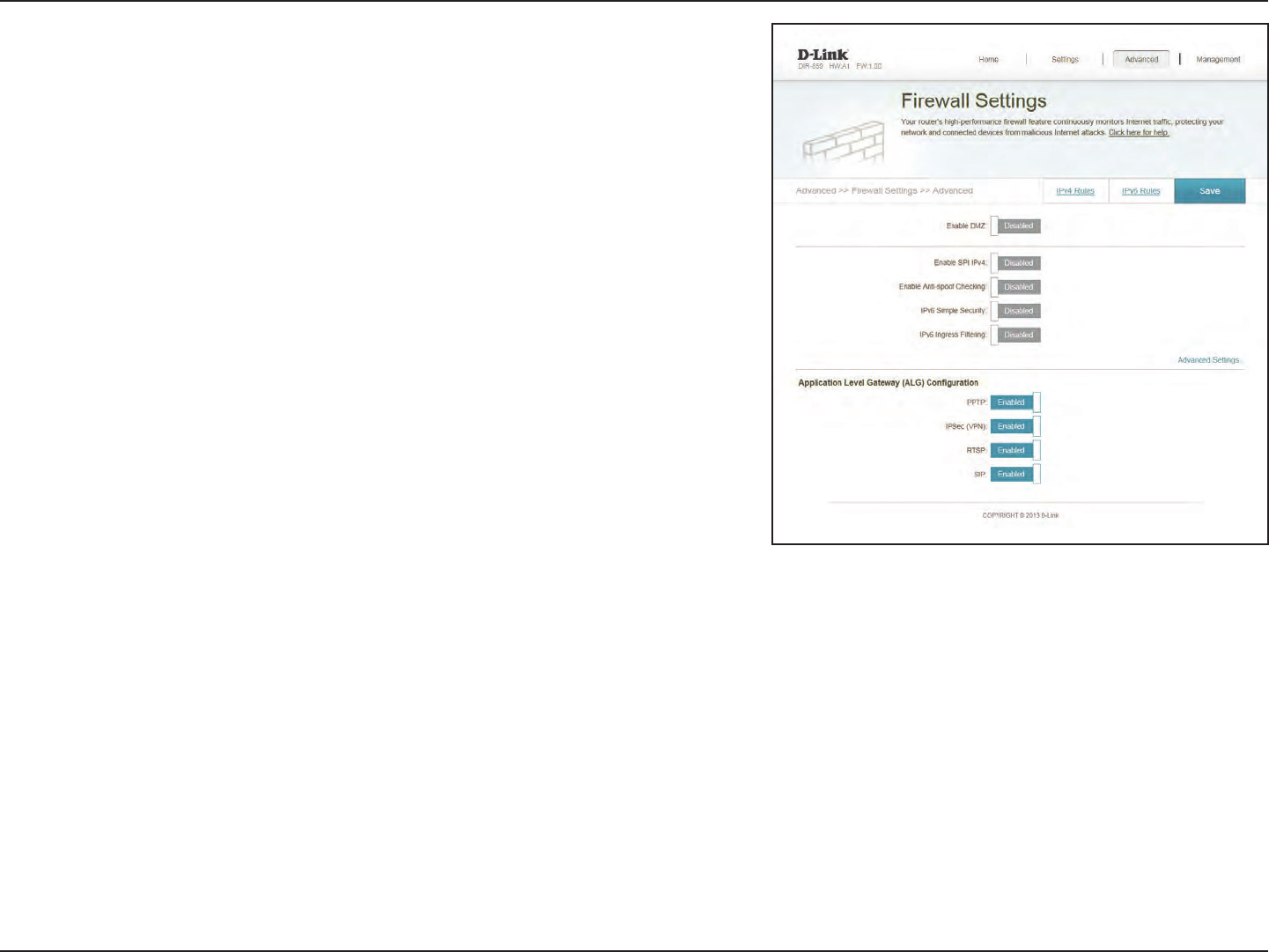
60D-Link DIR-859 User Manual
Section 4 - Conguration
Allows multiple VPN clients to connect to their corporate network
using IPSec. Some VPN clients support traversal of IPSec through
NAT. This Application Level Gateway (ALG) may interfere with the
operation of such VPN clients. If you are having trouble connecting
with your corporate network, try turning this ALG o. Please check
with the system administrator of your corporate network whether
your VPN client supports NAT traversal.
Allows applications that uses Real Time Streaming Protocol (RTSP)
to receive streaming media from the Internet.
Allows devices and applications using VoIP (Voice over IP) to
communicate across NAT. Some VoIP applications and devices have
the ability to discover NAT devices and work around them. This ALG
may interfere with the operation of such devices. If you are having
trouble making VoIP calls, try turning this ALG o.
Click Save when you are done.
IPSec (VPN):
RTSP:
SIP:
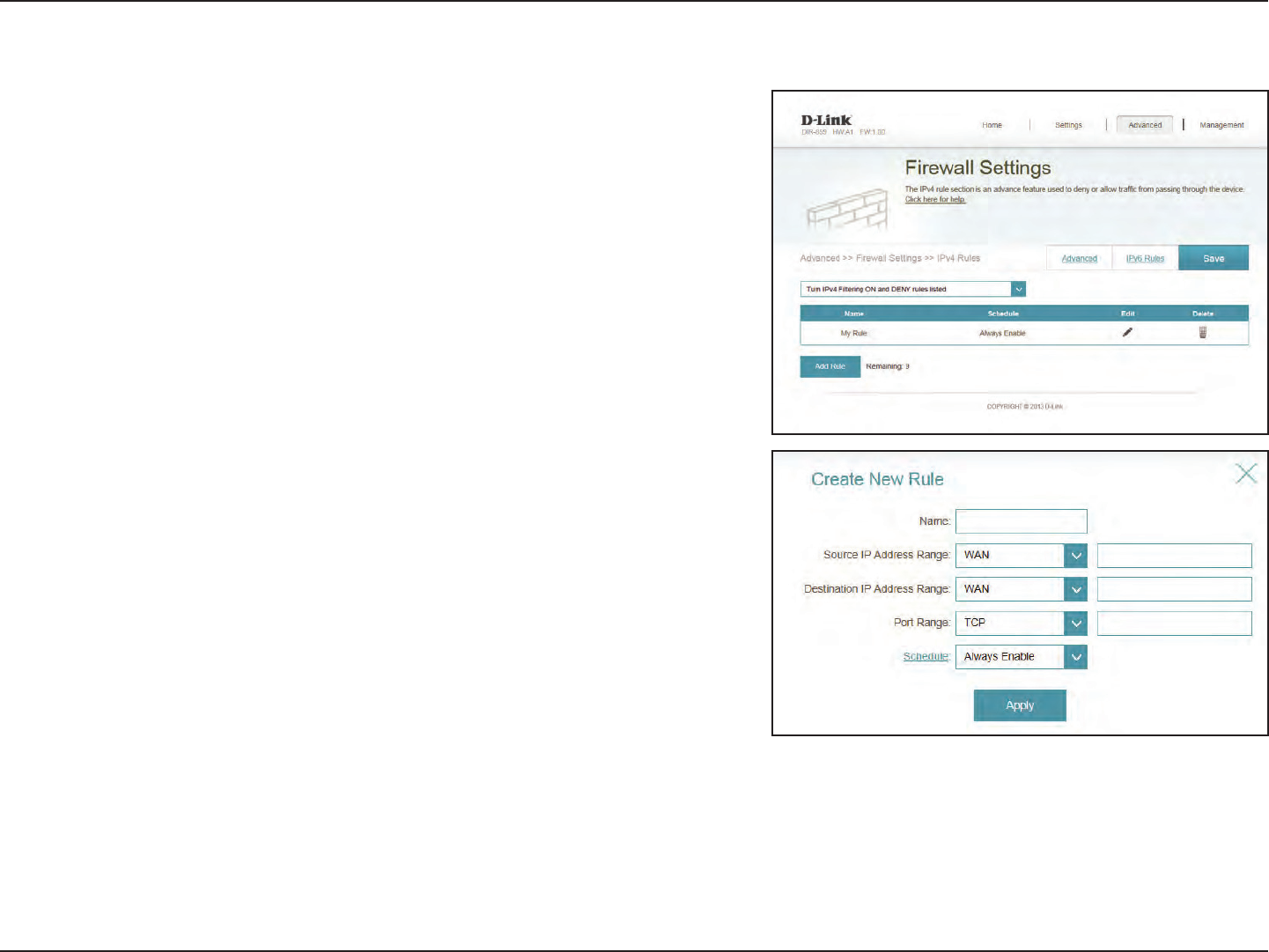
61D-Link DIR-859 User Manual
Section 4 - Conguration
IPv4/IPv6 Rules
Enter a name for the rule.
Enter the source IP address range that the rule will apply to, and using
the drop-down menu, specify whether it is a WAN or LAN IP address.
Enter the destination IP address range that the rule will apply to, and
using the drop-down menu, specify whether it is a WAN or LAN IP
address.
Select the protocol of the trac to allow or deny (Any, TCP, or UDP)
and then enter the range of ports that the rule will apply to.
Use the drop-down menu to select the time schedule that the rule
will be enabled on. The schedule may be set to Always Enable, or
you can create your own schedules in the Schedules section (refer
to page 69).
Click OK when you are done.
The IPv4/IPv6 Rules section is an advanced option that lets you congure what kind
of trac is allowed to pass through the network. To congure the IPv4 rules, from
the Firewall Settings page click IPv4 Rules. To congure IPv6 rules, from the Firewall
Settings page click IPv6 Rules. To return to the main Firewall Settings page, click
Security Check.
To begin, use the drop-down menu to select whether you want to ALLOW or DENY
the rules you create. You can also choose to turn ltering OFF.
If you wish to remove a rule, click on its trash can icon in the Delete column. If you
wish to edit a rule, click on its pencil icon in the Edit column. If you wish to create a
new rule, click the Add Rules button. Click Save when you are done. If you edit or
create a rule, the following options will appear:
Name:
Source IP
Address Range:
Destination IP
Address Range:
Port Range:
Schedule:

62D-Link DIR-859 User Manual
Section 4 - Conguration
Port Forwarding
Enter a name for the rule.
Enter the IP address of the computer on your local network that you
want to allow the incoming service to. Alternatively, select the device
from the drop-down menu.
Enter the TCP ports that you want to open. You can enter a single
port or a range of ports. Separate ports with a comma (for example:
24,1009,3000-4000).
Enter the UDP ports that you want to open. You can enter a single
port or a range of ports. Separate ports with a comma (for example:
24,1009,3000-4000).
Use the drop-down menu to select the time schedule that the rule
will be enabled on. The schedule may be set to Always Enable, or
you can create your own schedules in the Schedules section (refer
to page 69).
Click OK when you are done.
Name:
Local IP:
TCP Port:
UDP Port:
Schedule:
Port forwarding allows you to specify a port or range of ports to open for specic
devices on the network. This might be necessary for certain applications to connect
through the router. In the Advanced menu on the bar on the top of the page, click
Port Forwarding.
If you wish to remove a rule, click on its trash can icon in the Delete column. If you
wish to edit a rule, click on its pencil icon in the Edit column. If you wish to create a
new rule, click the Add Rules button. Click Save when you are done. If you edit or
create a rule, the following options will appear:
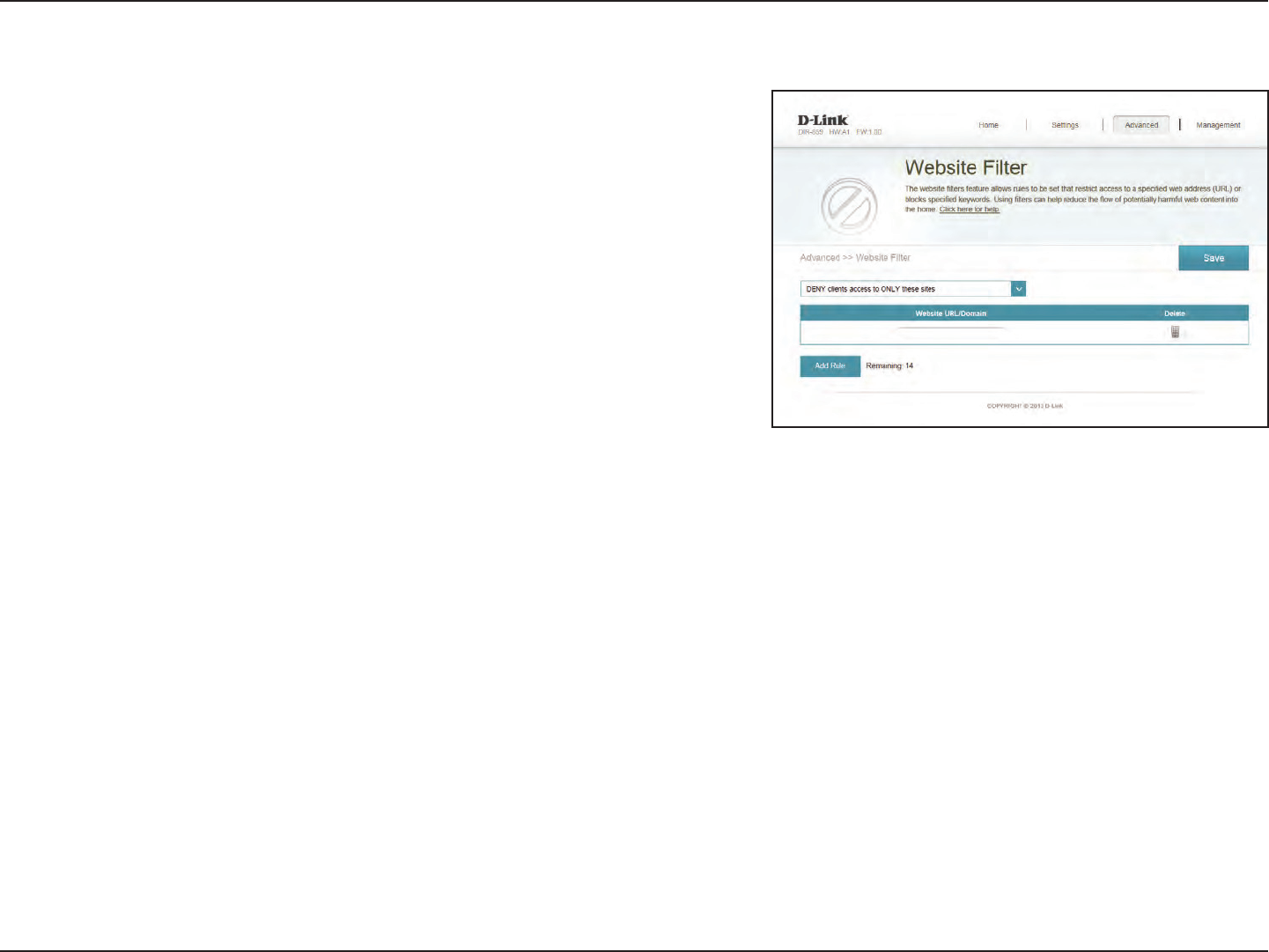
63D-Link DIR-859 User Manual
Section 4 - Conguration
Website Filter
The website lter settings allow you to block access to certain web sites. You can
either create a list of sites to block, or create a list of sites to allow (with all other sites
being blocked).
In the Advanced menu on the bar on the top of the page, click Website Filter.
If you want to create a list of sites to block, select DENY computers access to ONLY
these sites from the drop-down menu. All other sites will be accessible. If you want
to specify a list of sites to allow, select ALLOW computers access to ONLY these
sites from the drop-down menu. All other sites will be blocked.
You may specify a maximum of fteen web sites. To add a new site to the list, click
Create New Rule. Next, under Website URL/Domain enter the URL or domain. If you
wish to remove a rule, click on its trash can icon in the Delete column. If you wish to
edit a rule, simply replace the URL or domain.
Click Save when you are done.

64D-Link DIR-859 User Manual
Section 4 - Conguration
Static Routes
Enter a name for the rule.
Enter the IP address of packets that will take this route.
Enter the netmask of the route.
Enter your next hop gateway to be taken if this route is used.
The route metric is a value from 1 to 16 that indicates the cost of
using this route. A value 1 is the lowest cost and 15 is the highest cost.
Select the interface that the IP packet must use to transit out of the
router when this route is used.
Click OK when you are done.
The Static Routes section allows you to dene custom routes to control how data
trac is moved around your network.
In the Advanced menu on the bar on the top of the page, click Static Routes.
To congure IPv6 rules, click IPv6 and refer to page 65. To return to the main IPv4 static
routes page, click IPv4.
If you wish to remove a rule, click on its trash can icon in the Delete column. If you
wish to edit a rule, click on its pencil icon in the Edit column. If you wish to create a
new rule, click the Add Rules button. Click Save when you are done. If you edit or
create a rule, the following options will appear:
Name:
Destination IP:
Netmask:
Gateway:
Metric:
Interface:
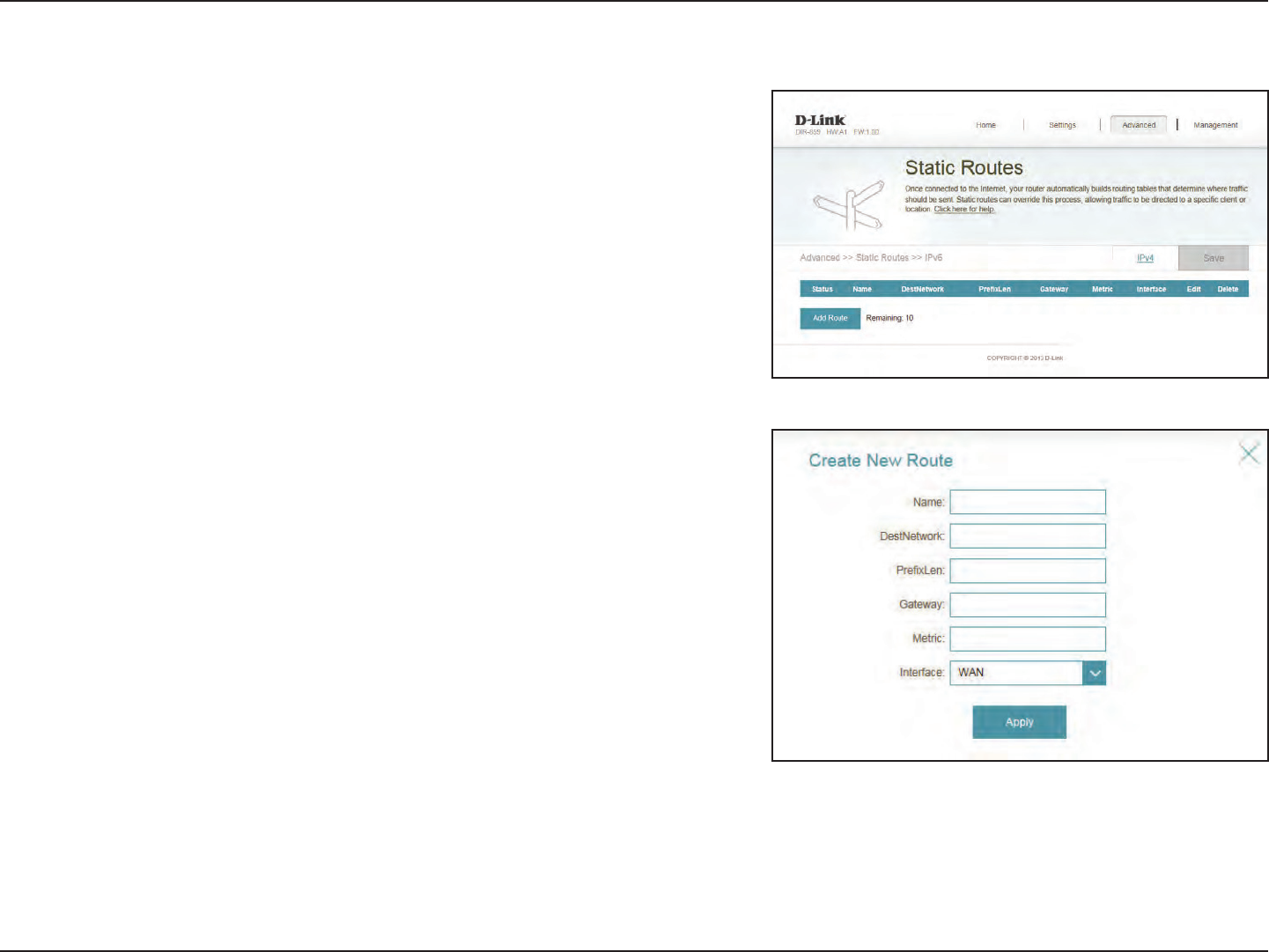
65D-Link DIR-859 User Manual
Section 4 - Conguration
Enter a name for the rule.
This is the IP address of the router used to reach the specied
destination.
Enter the IPv6 address prex length of the packets that will take this
route.
Enter the IP address of the gateway.
Enter the metric value for this rule here.
Select the interface that the IP packet must use to transit out of the
router when this route is used.
Click OK when you are done.
Name:
DestNetwork:
PrexLen:
Gateway:
Metric:
Interface:
IPv6
To congure IPv6 rules, on the Static Routes page click IPv6. To return to the main
IPv4 static routes page, click IPv4.
If you wish to remove a rule, click on its trash can icon in the Delete column. If you
wish to edit a rule, click on its pencil icon in the Edit column. If you wish to create a
new rule, click the Add Rules button. Click Save when you are done. If you edit or
create a rule, the following options will appear:
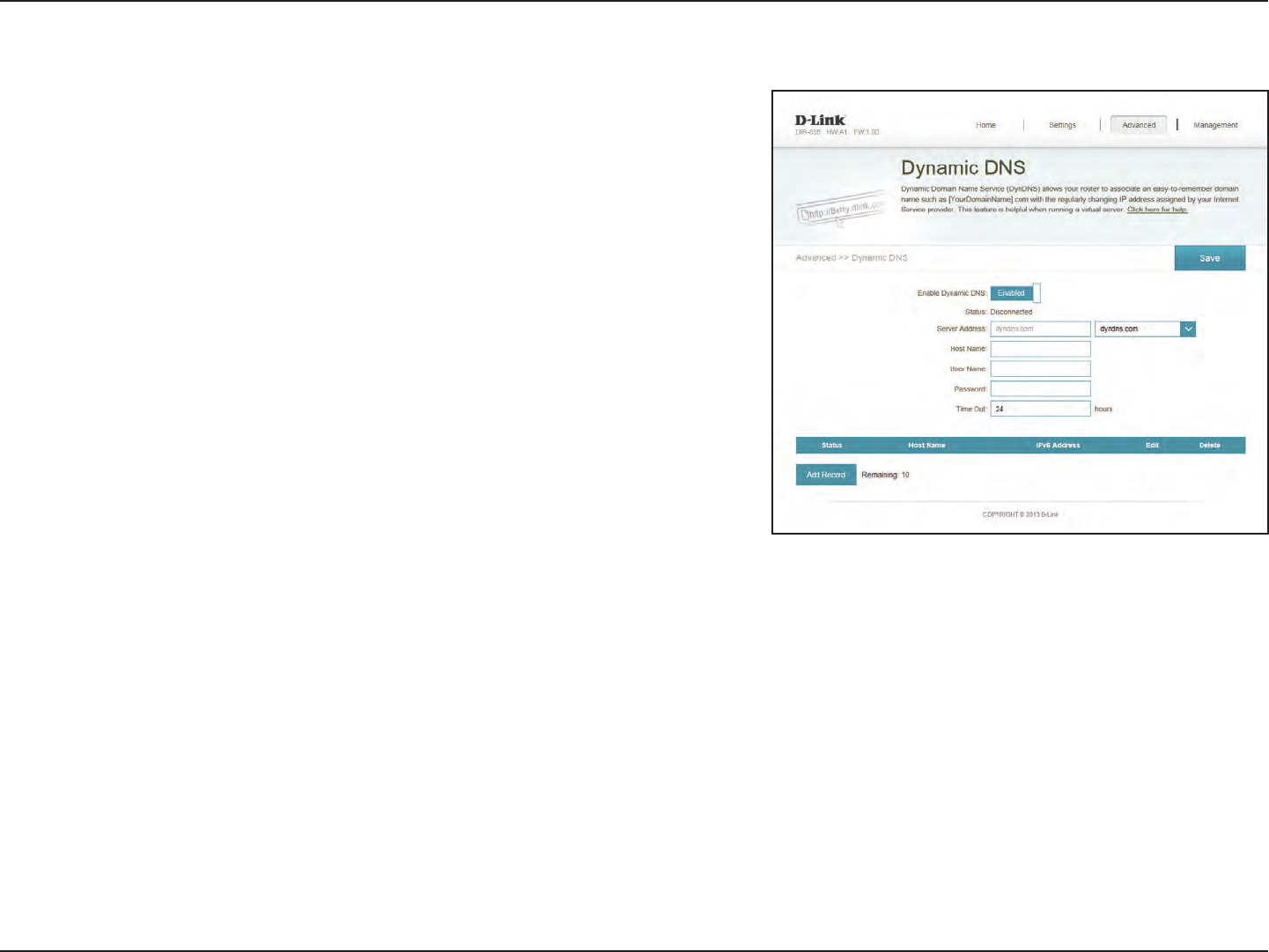
66D-Link DIR-859 User Manual
Section 4 - Conguration
Dynamic DNS
Most Internet Service Providers (ISPs) assign dynamic (changing) IP addresses. Using
a dynamic DNS service provider, people can enter your domain name in their web
browser to connect to your server no matter what your IP address is.
In the Advanced menu on the bar on the top of the page, click Dynamic DNS.
Enabling dynamic DNS will reveal further conguration options.
Displays the current dynamic DNS connection status.
Enter the address of your dynamic DNS server, or select one from
the drop-down menu.
Enter the host name that you registered with your dynamic DNS
service provider.
Enter your dynamic DNS username.
Enter your dynamic DNS password.
Enter a timeout time (in hours).
Click Save when you are done.
Enable
Dynamic DNS:
Status:
Server Address:
Host Name:
User Name:
Password:
Time Out:
At the bottom of the page are the IPv6 host settings. To congure an IPv6 dynamic
DNS host, refer to page 67.

67D-Link DIR-859 User Manual
Section 4 - Conguration
Enter the host name that you registered with your dynamic DNS
service provider.
Enter the IPv6 address of the dynamic DNS server. Alternatively, select
the server device in the drop-down menu.
Click OK when you are done.
Host Name:
IPv6 Address:
The IPv6 host settings are found at the bottom of the Dynamic DNS page.
If you wish to remove a rule, click on its trash can icon in the Delete column. If you
wish to edit a rule, click on its pencil icon in the Edit column. If you wish to create a
new rule, click the Add Rules button. Click Save when you are done. If you edit or
create a rule, the following options will appear:
IPv6 Host

68D-Link DIR-859 User Manual
Section 4 - Conguration
Management
Time & Schedule
Time
The Time page allows you to congure, update, and maintain the correct time on
the internal system clock. From here you can set the time zone, the Network Time
Protocol (NTP) server, and enable or disable daylight saving time.
In the Management menu on the bar on the top of the page, click Time & Schedule.
Select your time zone from the drop-down menu.
Displays the current date and time of the router.
Enable or disable daylight saving time.
Enable or disable to allow an NTP server on the Internet to synchronize
the time and date with your router. If you enable this option, select
an NTP server from the drop-down menu. To congure the router’s
time and date manually, disable this option and use the drop-down
menus that appear to input the time and date.
Click Save when you are done.
Time Zone:
Time:
Daylight
Saving:
Update Time
Using an NTP
Server:
To congure and manage your schedules, click Schedule and refer to page 69.
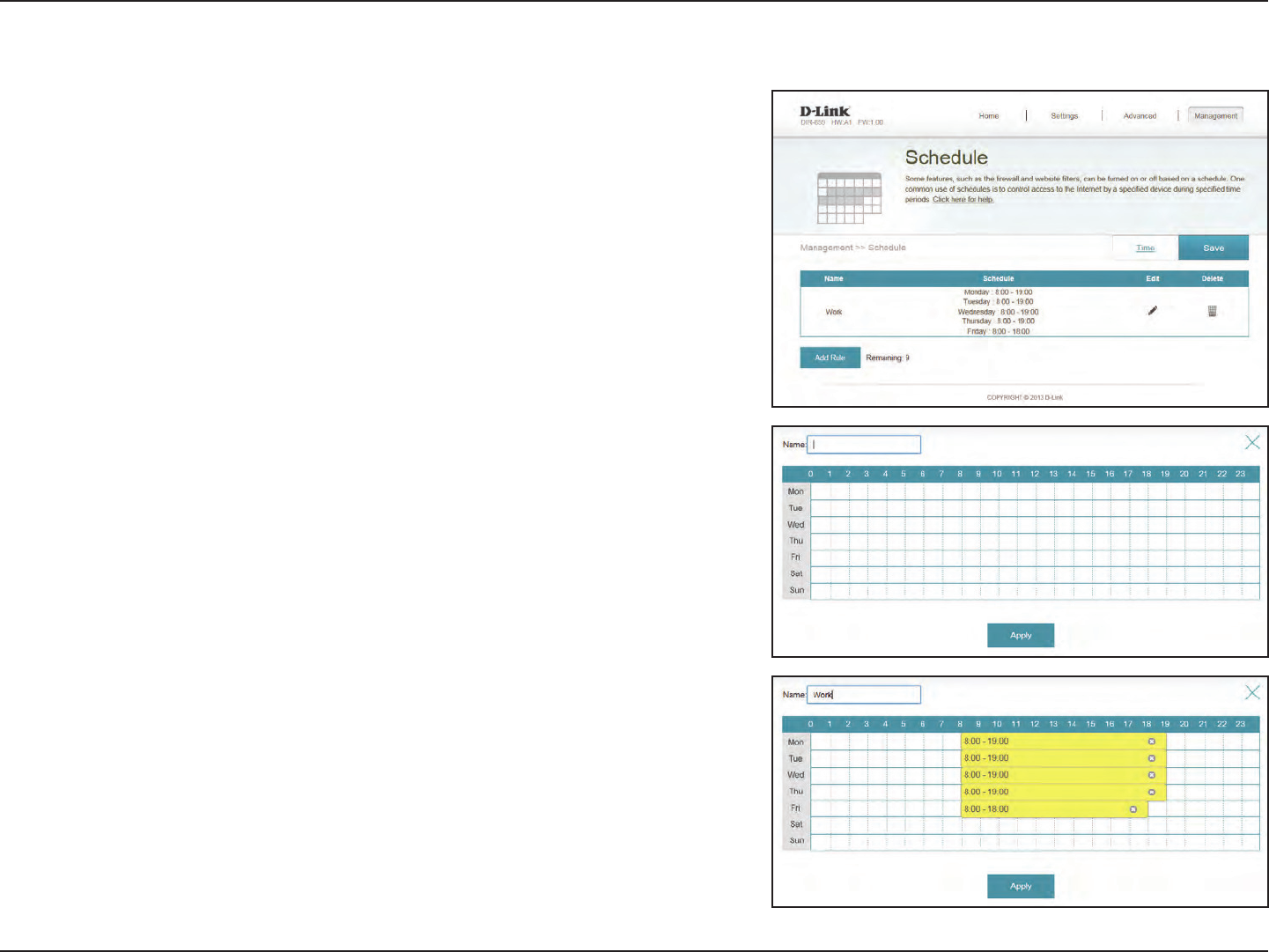
69D-Link DIR-859 User Manual
Section 4 - Conguration
Schedule
Some conguration rules can be set according to a pre-congured schedule. To
create, edit, or delete schedules, from the Time page click Schedule. To return to
the Time page, click Time.
If you wish to remove a rule, click on its trash can icon in the Delete column. If you
wish to edit a rule, click on its pencil icon in the Edit column. If you wish to create a
new rule, click the Add Rules button. Click Save when you are done. If you edit or
create a rule, the following screen will appear:
First, enter the name of your schedule in the Name eld.
Each box represents one hour, with the time at the top of each column. To add a time
period to the schedule, simply click on the start hour and drag to the end hour. You
can add multiple days to the schedule, but only one period per day.
To remove a time period from the schedule, click on the cross icon.
Click OK when you are done.

70D-Link DIR-859 User Manual
Section 4 - Conguration
System Log
Check this box to send the router logs to a SysLog Server. If this is
disabled, there will be no other options on this page.
Enter the IP address for the Syslog server. If the Syslog server is
connected to the router, select it from the drop-down menu to
automatically populate the eld.
If you want the logs to be automatically sent to an email address,
enable this option.
Enter the settings for your email account. These are obtained from
your email service provider.
If email notication is enabled, this option will set the router to send
the log by email when the log is fully.
This option can be enabled to send an email according to a pre-
congured schedule. See below.
If Send On Schedule is enabled, use the drop-down menu to select
the time schedule that the rule will be enabled on. The schedule may
be set to Always Enable, or you can create your own schedules in
the Schedules section (refer to page 69).
Click Save when you are done.
Enable Logging
to Syslog
Server:
Syslog Server IP
Address:
Enable Email
Notication:
Send When Log
Full:
Send On
Schedule:
Schedule:
The router keeps a running log of events. This log can be sent to a Syslog server, and
sent to your email address. In the Management menu on the bar on the top of the
page, click System Log.
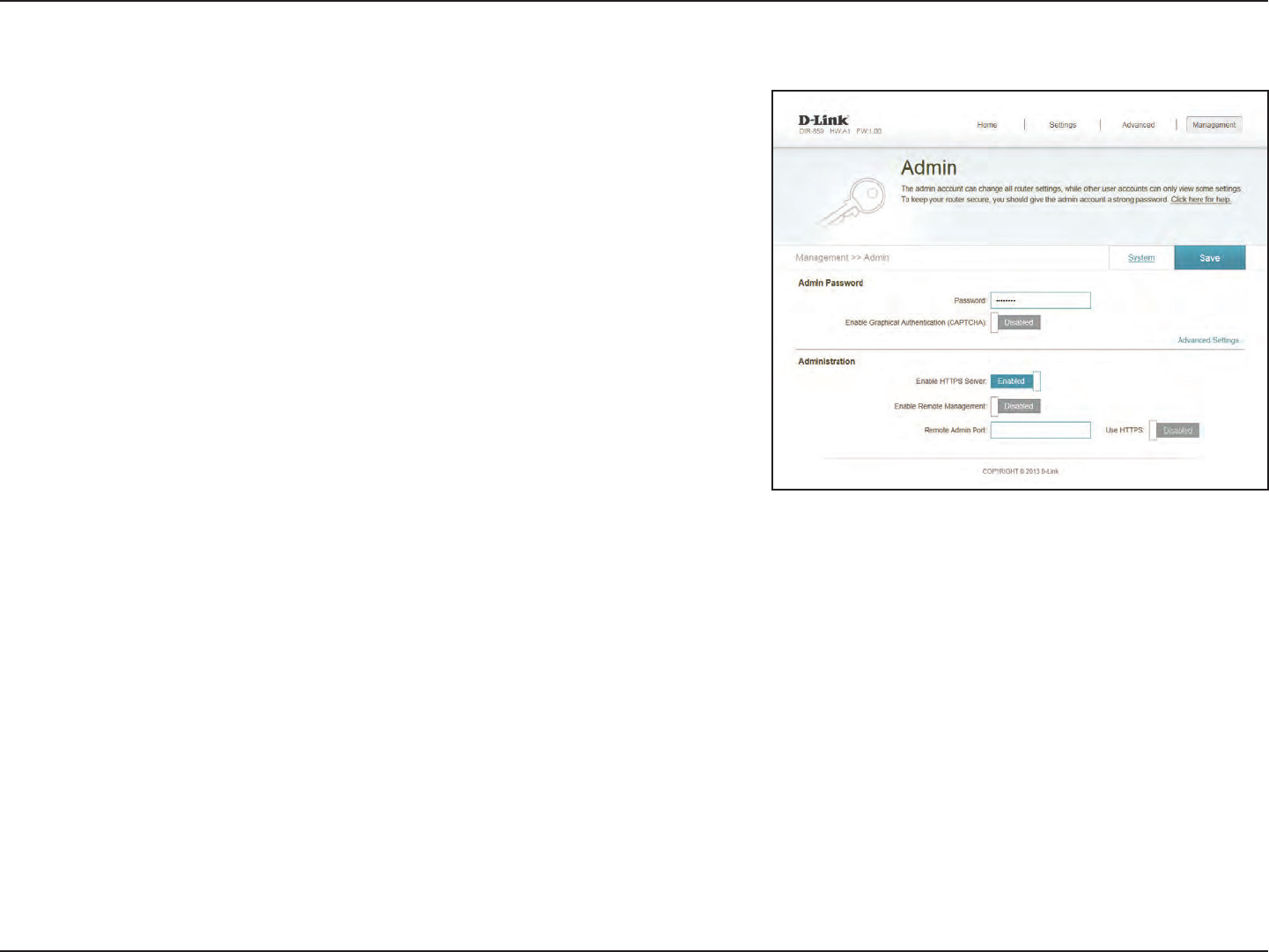
71D-Link DIR-859 User Manual
Section 4 - Conguration
Admin
This page will allow you to change the administrator (Admin) password and enable
remote management.
In the Management menu on the bar on the top of the page, click Admin.
Enter a new password for the administrator account. You will need to
enter this password whenever you congure the router using a web
browser.
Enables a challenge-response test to require users to type letters or
numbers from a distorted image displayed on the screen to prevent
online hackers and unauthorized users from gaining access to your
router’s network settings.
Check to enable HTTPS to connect to the router securely. This means
to connect to the router, you must enter https://192.168.0.1 instead
of http://192.168.0.1.
Remote management allows the DIR-859 to be congured from the
Internet by a web browser. A password is still required to access the
web management interface.
The port number used to access the DIR-859 is used in the URL. Example:
http://x.x.x.x:8080 where x.x.x.x is the Internet IP address of the DIR-859
and 8080 is the port used for the web management interface. If you
enable HTTPS Server, you must enter https:// as part of the URL to
access the router remotely.
Click Save when you are done.
Password:
Enable
Graphical
Authentication
(CAPTCHA):
Enable HTTPS
Server:
Enable Remote
Management:
Remote Admin
Port:
To load, save, or reset settings, or reboot the router, click System and refer to page 72.
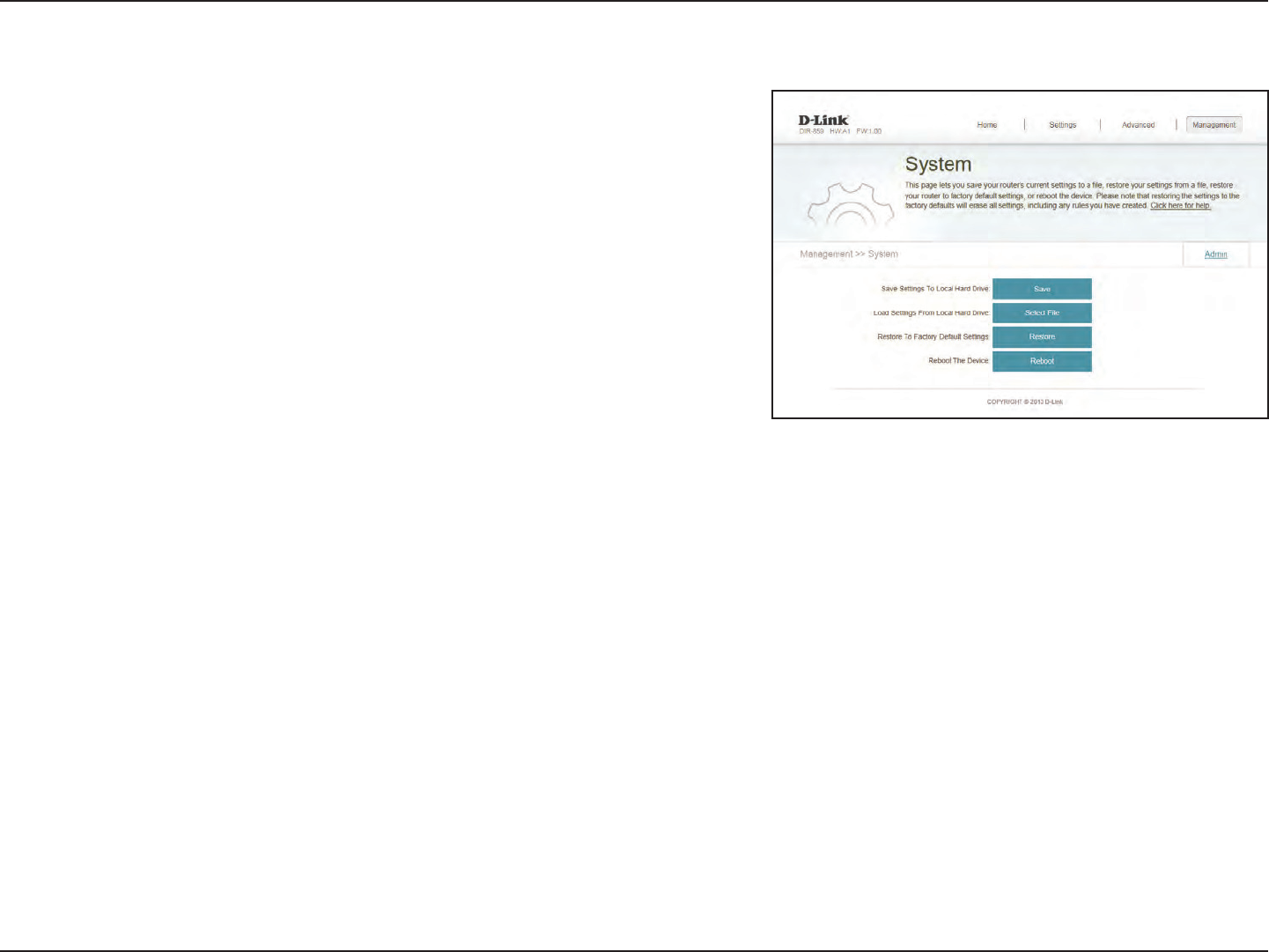
72D-Link DIR-859 User Manual
Section 4 - Conguration
System
This option will save the current router conguration settings to a le
on your computer.
This option will load previously saved router conguration le. This will
overwrite the router’s current conguration.
This option will restore all conguration settings back to the settings that
were in eect at the time the router was shipped from the factory. Any
settings that have not been saved will be lost, including any rules that
you have created. If you want to save the current router conguration
settings, use the Save Settings To Local Hard Drive button above.
Click to reboot the router.
Click Save when you are done.
Save Settings
To Local Hard
Drive:
Load Settings
From Local
Hard Drive:
Restore To
Factory Default
Settings:
Reboot The
Device:
This page allows you to save the router’s current conguration, load a previously saved
conguration, reset the router to its factory default settings, or reboot the router.
From the Admin page click System. To return to the Admin page, click Admin.

73D-Link DIR-859 User Manual
Section 4 - Conguration
Upgrade
This page will allow you to upgrade the router’s rmware or language pack, either
automatically or manually. To manually upgrade the rmware or language pack, you
must rst download the relevant le from http://support.dlink.com.
In the Management menu on the bar on the top of the page, click Upgrade.
The current rmware’s version and date will be displayed.
Click this button to prompt the router to automatically check for a new
rmware version. If a newer version is found, it will prompt you to install
it.
If you wish to upgrade manually, rst download the rmware le you
wish to upgrade to. Next, click the Upgrade Firmware button and
browse to the le to install the new rmware. You can also browse to a
language pack le to install a new language pack.
Firmware
Information:
Check for New
Firmware:
Upgrade
Firmware:

74D-Link DIR-859 User Manual
Section 4 - Conguration
Statistics
On the Statistics page you can view the amount of packets that pass through the router
on the WAN, LAN, and wireless segments.
In the Management menu on the bar on the top of the page, click Statistics.
You can view the Internet, LAN, Wi-Fi 2.4 GHz, or Wi-Fi 5 GHz by clicking on the
respective tabs at the top. The graph will update in real time. To clear the information
on the graph, click Clear.
The trac counter will reset if the device is rebooted.
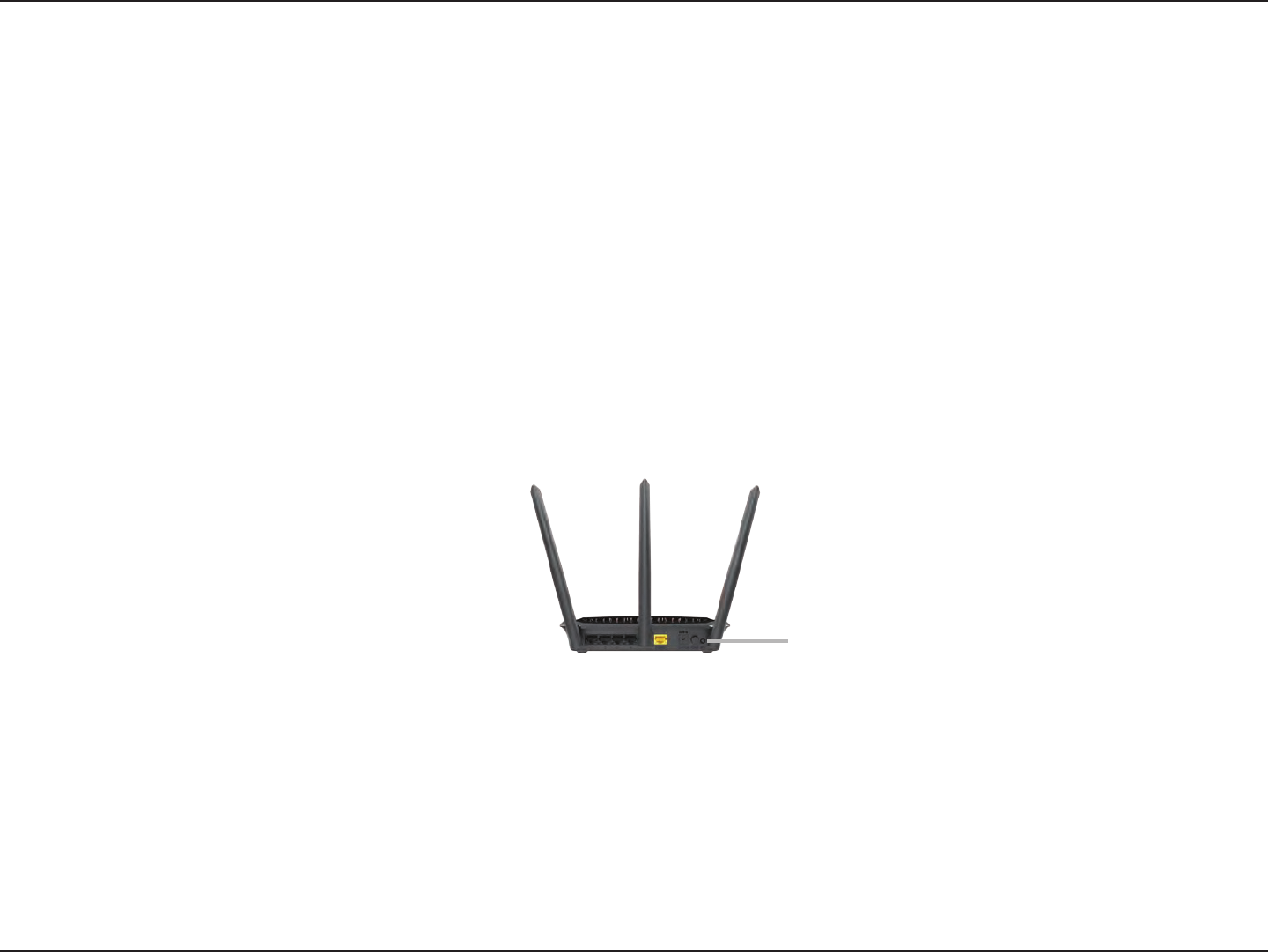
75D-Link DIR-859 User Manual
Section 5 - Connecting to a Wireless Network
Connect a Wireless Client to your Router
WPS Button
Step 2 - Within 2 minutes, press the WPS button on your wireless client (or launch the software utility and start the WPS
process).
The easiest and most secure way to connect your wireless devices to the router is with WPS (Wi-Fi Protected Setup). Most wireless
devices such as wireless adapters, media players, Blu-ray DVD players, wireless printers and cameras will have a WPS button
(or a software utility with WPS) that you can press to connect to the DIR-859 router. Please refer to your user manual for the
wireless device you want to connect to make sure you understand how to enable WPS. Once you know, follow the steps below:
Step 1 - Press the WPS button on the DIR-859 for about 1 second. The Internet LED on the front will start to blink.
Step 3 - Allow up to 1 minute for your connection to be congured. Once the Internet light stops blinking, you will be connected
and your wireless connection will be secure with WPA2.
WPS Button

76D-Link DIR-859 User Manual
Section 5 - Connecting to a Wireless Network
Windows® 8
WPA/WPA2
It is recommended that you enable wireless security (WPA/WPA2) on your wireless router or access point before conguring
your wireless adapter. If you are joining an existing network, you will need to know the security key (Wi-Fi password) being used.
To join an existing network, locate the wireless network icon in the
taskbar next to the time display.
Wireless Icon
Clicking on this icon will display a list of wireless networks that are within
connecting proximity of your computer. Select the desired network by
clicking on the network name.
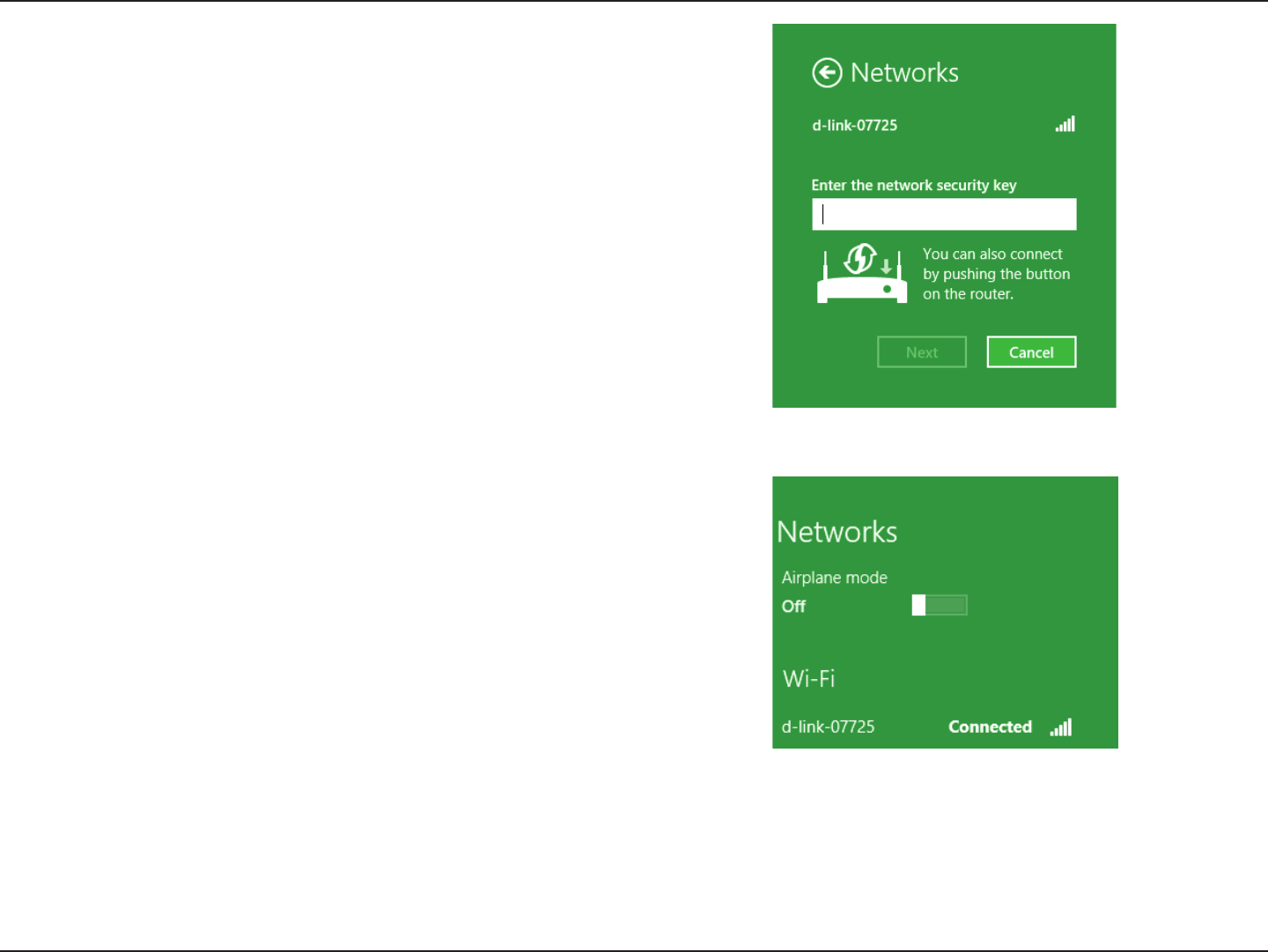
77D-Link DIR-859 User Manual
Section 5 - Connecting to a Wireless Network
You will then be prompted to enter the network security key (Wi-Fi
password) for the wireless network. Enter the password into the box
and click Next.
If you wish to use Wi-Fi Protected Setup (WPS) to connect to the router,
you can also press the WPS button on your router during this step to
enable the WPS function.
When you have established a successful connection to a wireless network,
the word Connected will appear next to the name of the network to
which you are connected to.

78D-Link DIR-859 User Manual
Section 5 - Connecting to a Wireless Network
Windows® 7
It is recommended that you enable wireless security (WPA/WPA2) on your wireless router or access point before conguring
your wireless adapter. If you are joining an existing network, you will need to know the security key or passphrase being used.
1. Click on the wireless icon in your system tray (lower-right corner).
2. The utility will display any available wireless networks in your area.
Wireless Icon
WPA/WPA2
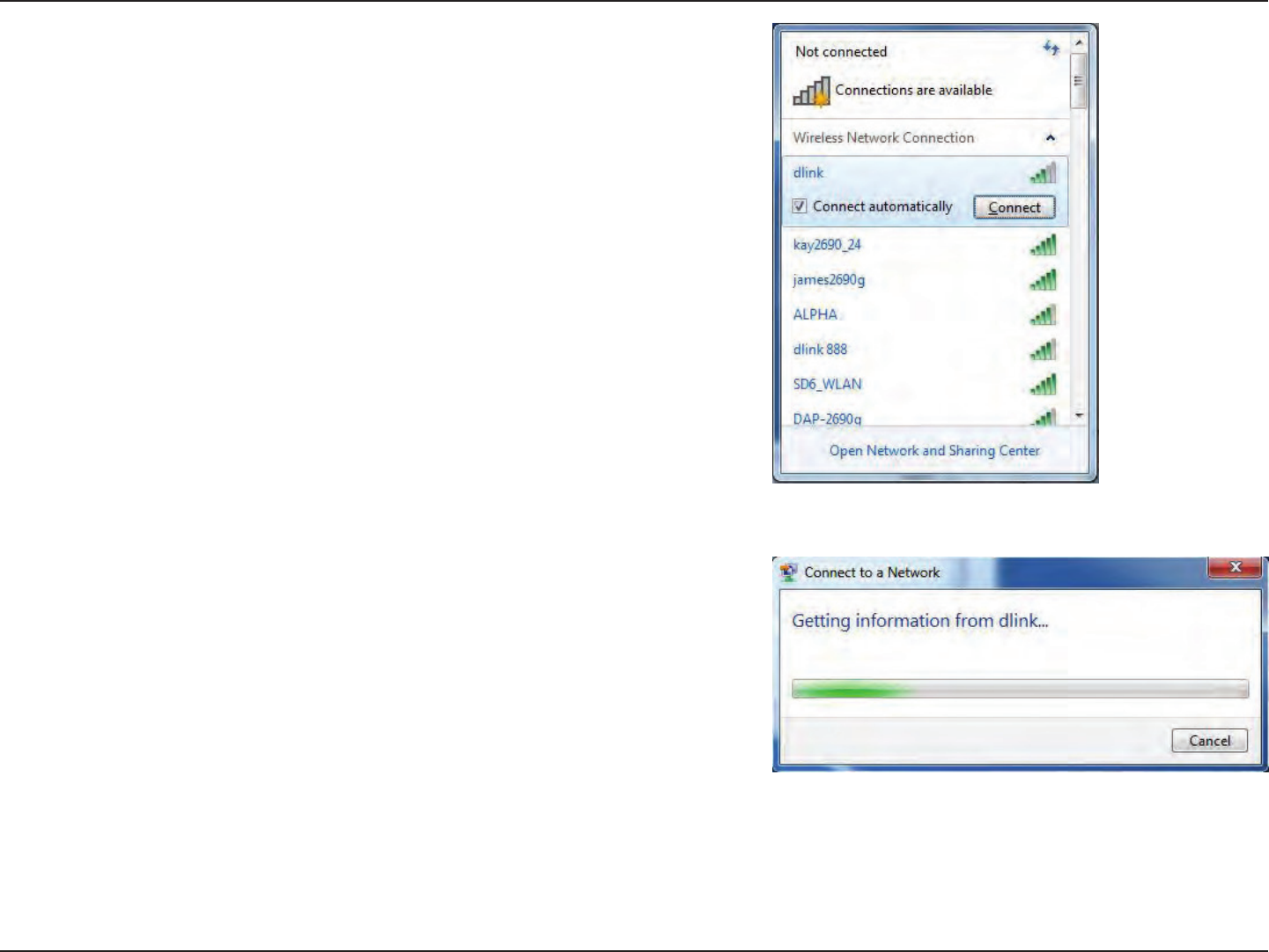
79D-Link DIR-859 User Manual
Section 5 - Connecting to a Wireless Network
3. Highlight the wireless connection with Wi-Fi name (SSID) you would
like to connect to and click the Connect button.
If you get a good signal but cannot access the Internet, check your TCP/
IP settings for your wireless adapter. Refer to the Networking Basics
section in this manual for more information.
4. The following window appears while your computer tries to connect
to the router.
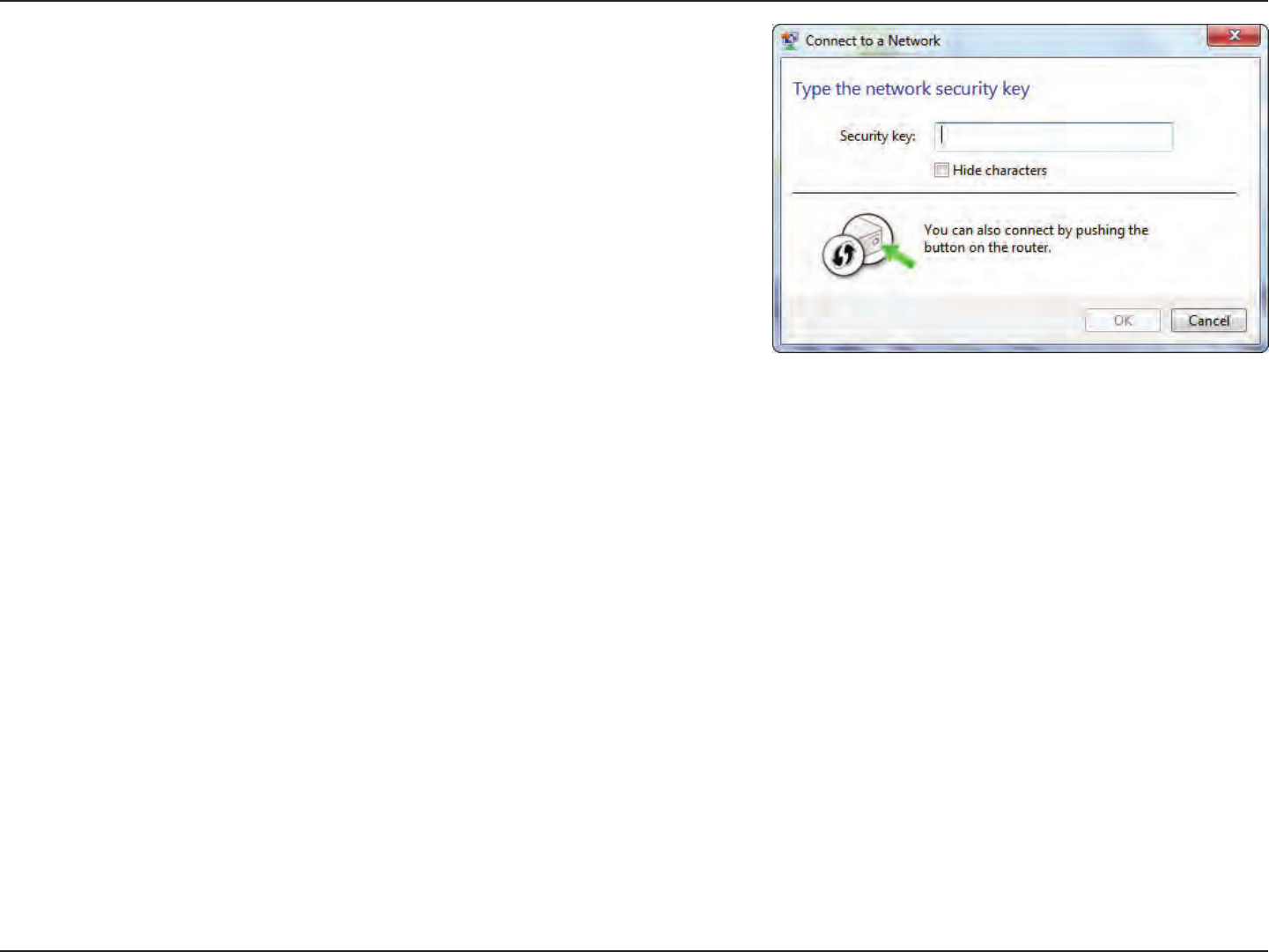
80D-Link DIR-859 User Manual
Section 5 - Connecting to a Wireless Network
5. Enter the same security key or passphrase (Wi-Fi password) that is on
your router and click Connect. You can also connect by pushing the
WPS button on the router.
It may take 20-30 seconds to connect to the wireless network. If the
connection fails, please verify that the security settings are correct. The
key or passphrase must be exactly the same as the one on the wireless
router.

81D-Link DIR-859 User Manual
Section 5 - Connecting to a Wireless Network
WPS
The WPS feature of the DIR-859 can be congured using Windows® 7. Carry out the following steps to use Windows® 7 to
congure the WPS feature:
1. Click the Start button and select Computer from the Start menu.
2. Click Network on the left side.

82D-Link DIR-859 User Manual
Section 5 - Connecting to a Wireless Network
3. Double-click the DIR-859.
4. Input the WPS PIN number (on the router label) in the Setup > Wireless
Setup menu in the router’s web UI) and click Next.
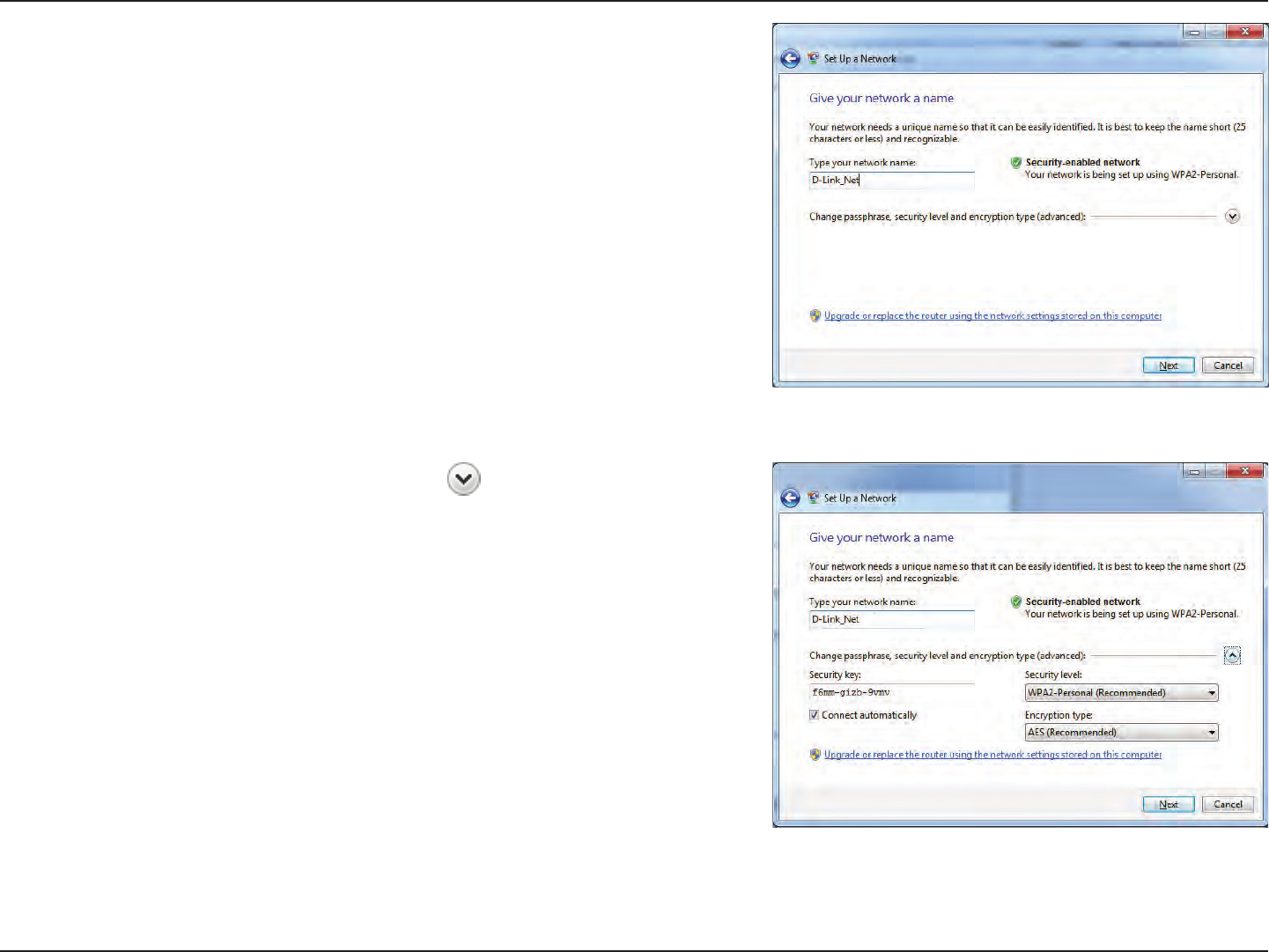
83D-Link DIR-859 User Manual
Section 5 - Connecting to a Wireless Network
5. Type a name to identify the network.
6. To congure advanced settings, click the icon.
Click Next to continue.

84D-Link DIR-859 User Manual
Section 5 - Connecting to a Wireless Network
7. The following window appears while the Router is being congured.
Wait for the conguration to complete.
8. The following window informs you that WPS on the router has been
set up successfully.
Make a note of the security key as you may need to provide this security
key if adding an older wireless device to the network in the future.
9. Click Close to complete WPS setup.
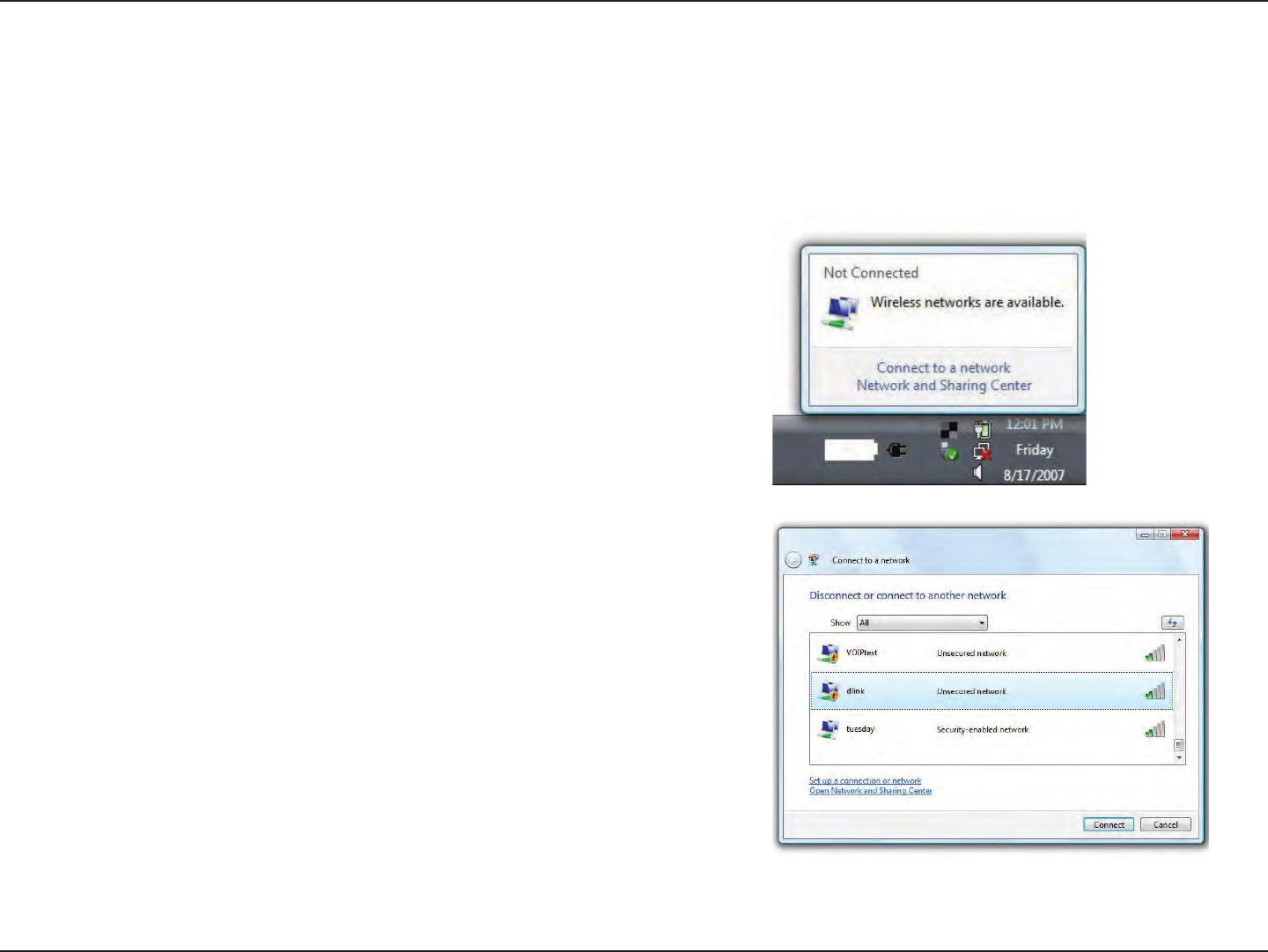
85D-Link DIR-859 User Manual
Section 5 - Connecting to a Wireless Network
Windows Vista®
Windows Vista® users may use the built-in wireless utility. If you are using another company’s wireless utility, please refer to the
user manual of your wireless adapter for help connecting to a wireless network. Most wireless utilities will have a “site survey”
option similar to the Windows Vista® utility as seen below.
Right-click on the wireless computer icon in your system tray (lower-right
corner next to the time). Select Connect to a network.
If you receive the Wireless Networks Detected bubble, click on the
center of the bubble to access the utility.
or
The utility will display any available wireless networks in your area. Click
on a network (displayed using the SSID) and click the Connect button.
If you get a good signal but cannot access the Internet, check you
TCP/IP settings for your wireless adapter. Refer to the Networking Basics
section in this manual for more information.
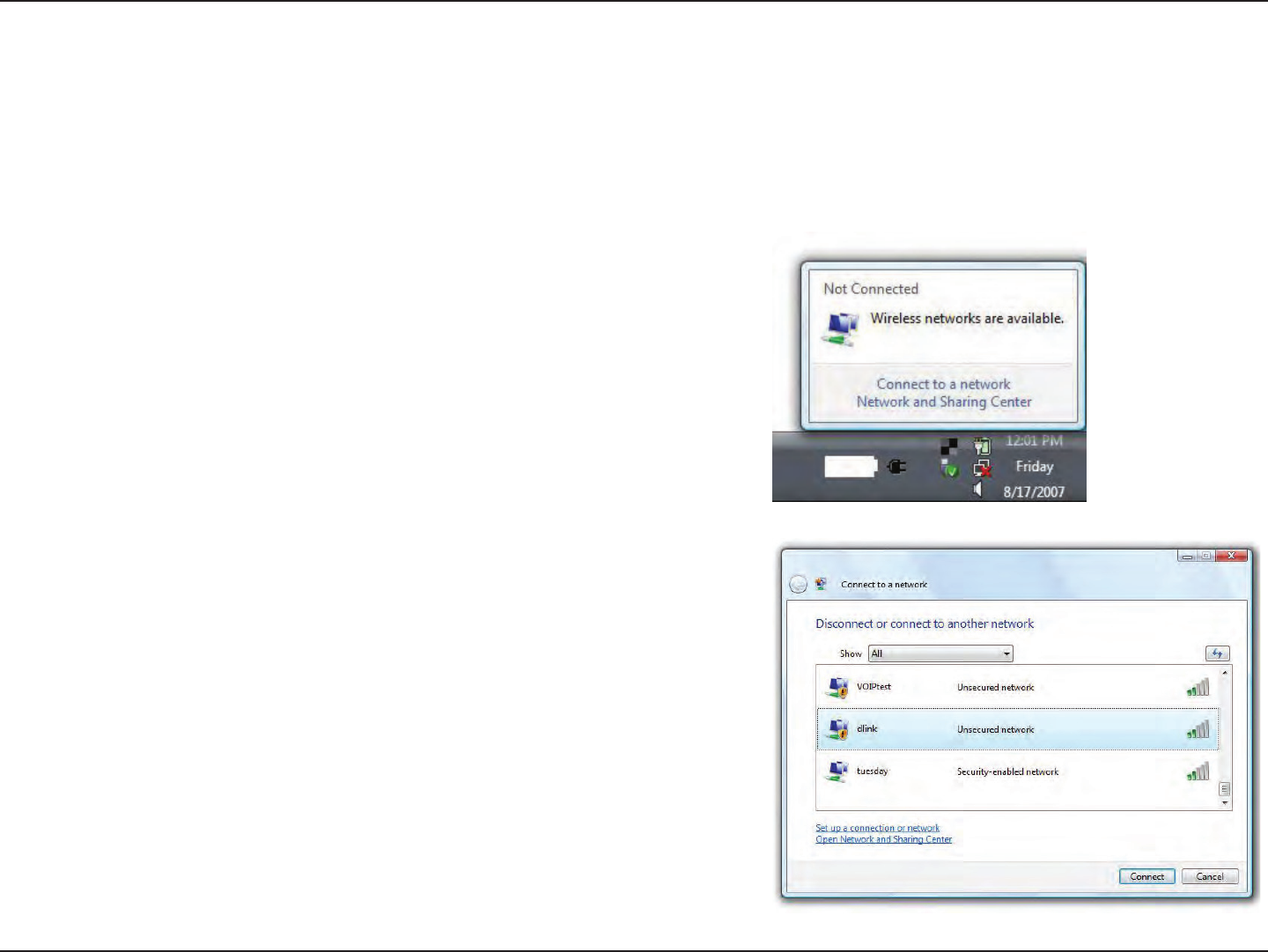
86D-Link DIR-859 User Manual
Section 5 - Connecting to a Wireless Network
WPA/WPA2
It is recommended that you enable wireless security (WPA/WPA2) on your wireless router or access point before conguring
your wireless adapter. If you are joining an existing network, you will need to know the security key or passphrase being used.
2. Highlight the Wi-Fi name (SSID) you would like to connect to and
click Connect.
1. Open the Windows Vista® Wireless Utility by right-clicking on the
wireless computer icon in your system tray (lower right corner of
screen). Select Connect to a network.
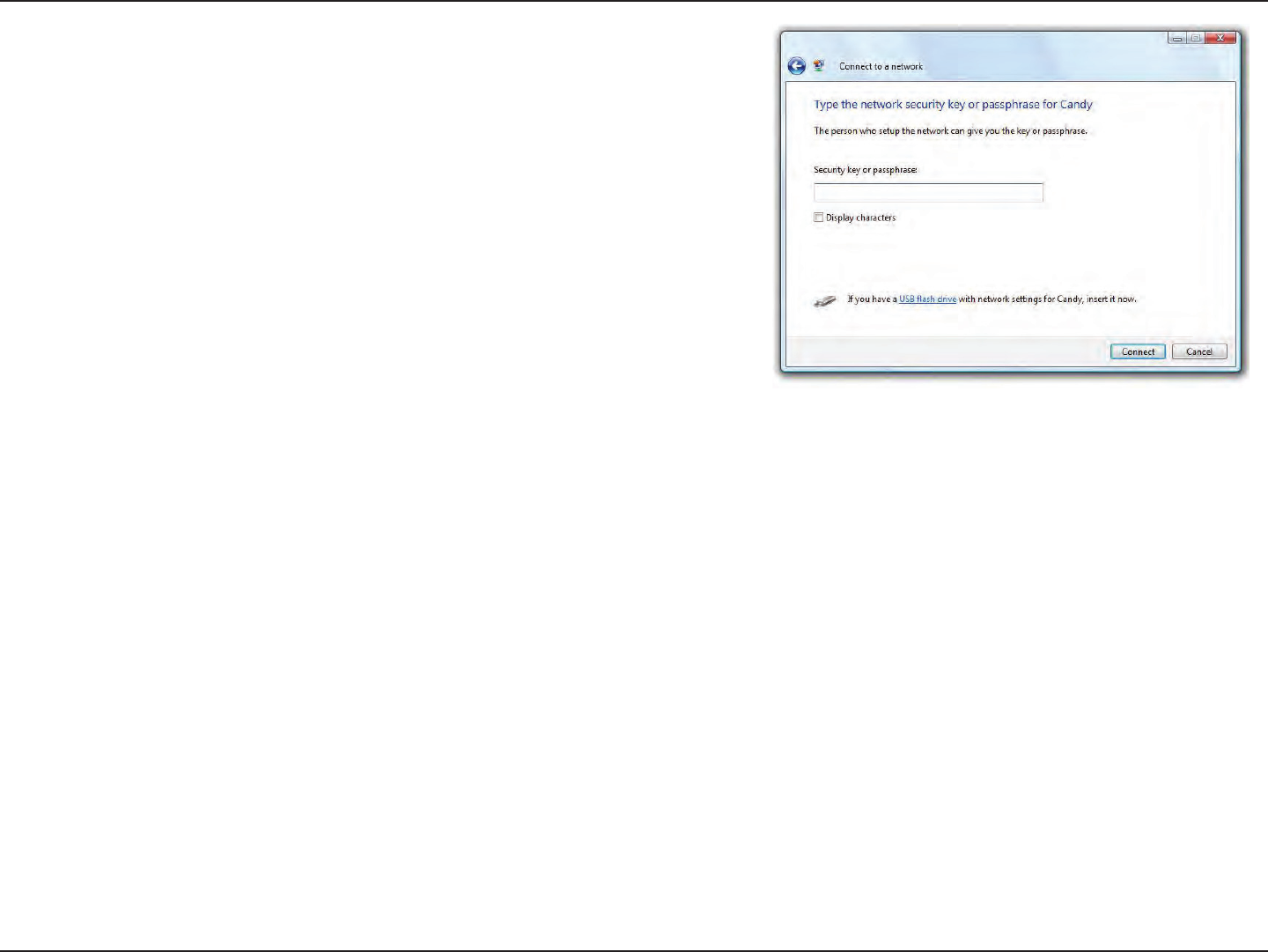
87D-Link DIR-859 User Manual
Section 5 - Connecting to a Wireless Network
3. Enter the same security key or passphrase (Wi-Fi password) that is on
your router and click Connect.
It may take 20-30 seconds to connect to the wireless network. If the
connection fails, please verify that the security settings are correct. The
key or passphrase must be exactly the same as the one on the wireless
router.
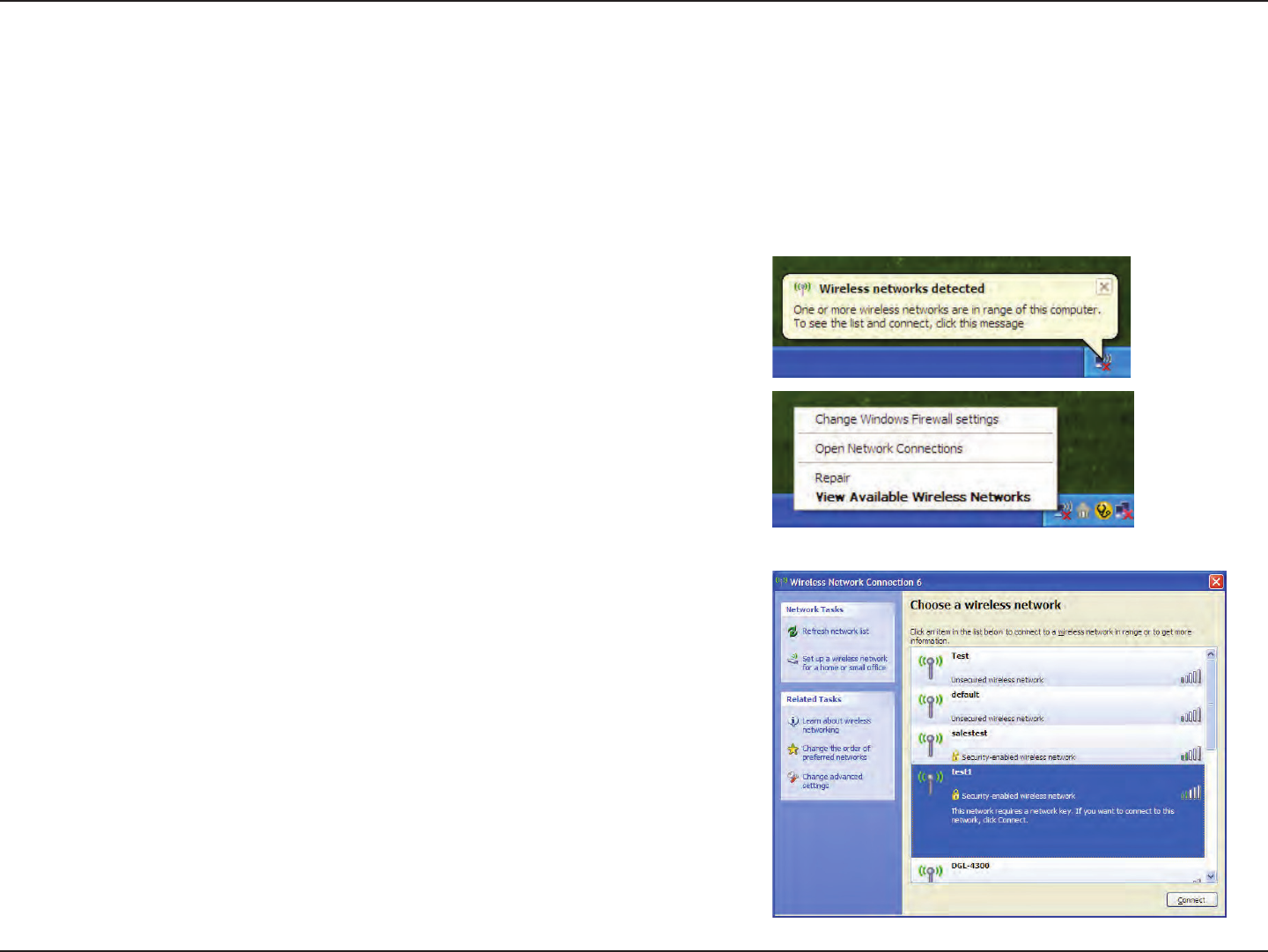
88D-Link DIR-859 User Manual
Section 5 - Connecting to a Wireless Network
Windows® XP
Windows® XP users may use the built-in wireless utility (Zero Conguration Utility). The following instructions are for Service
Pack 2 users. If you are using another company’s utility, please refer to the user manual of your wireless adapter for help with
connecting to a wireless network. Most utilities will have a “site survey” option similar to the Windows® XP utility as seen below.
Right-click on the wireless computer icon in your system tray (lower-right
corner next to the time). Select View Available Wireless Networks.
If you receive the Wireless Networks Detected bubble, click on the
center of the bubble to access the utility.
or
The utility will display any available wireless networks in your area. Click
on a Wi-Fi network (displayed using the SSID) and click the Connect
button.
If you get a good signal but cannot access the Internet, check you
TCP/IP settings for your wireless adapter. Refer to the Networking Basics
section in this manual for more information.
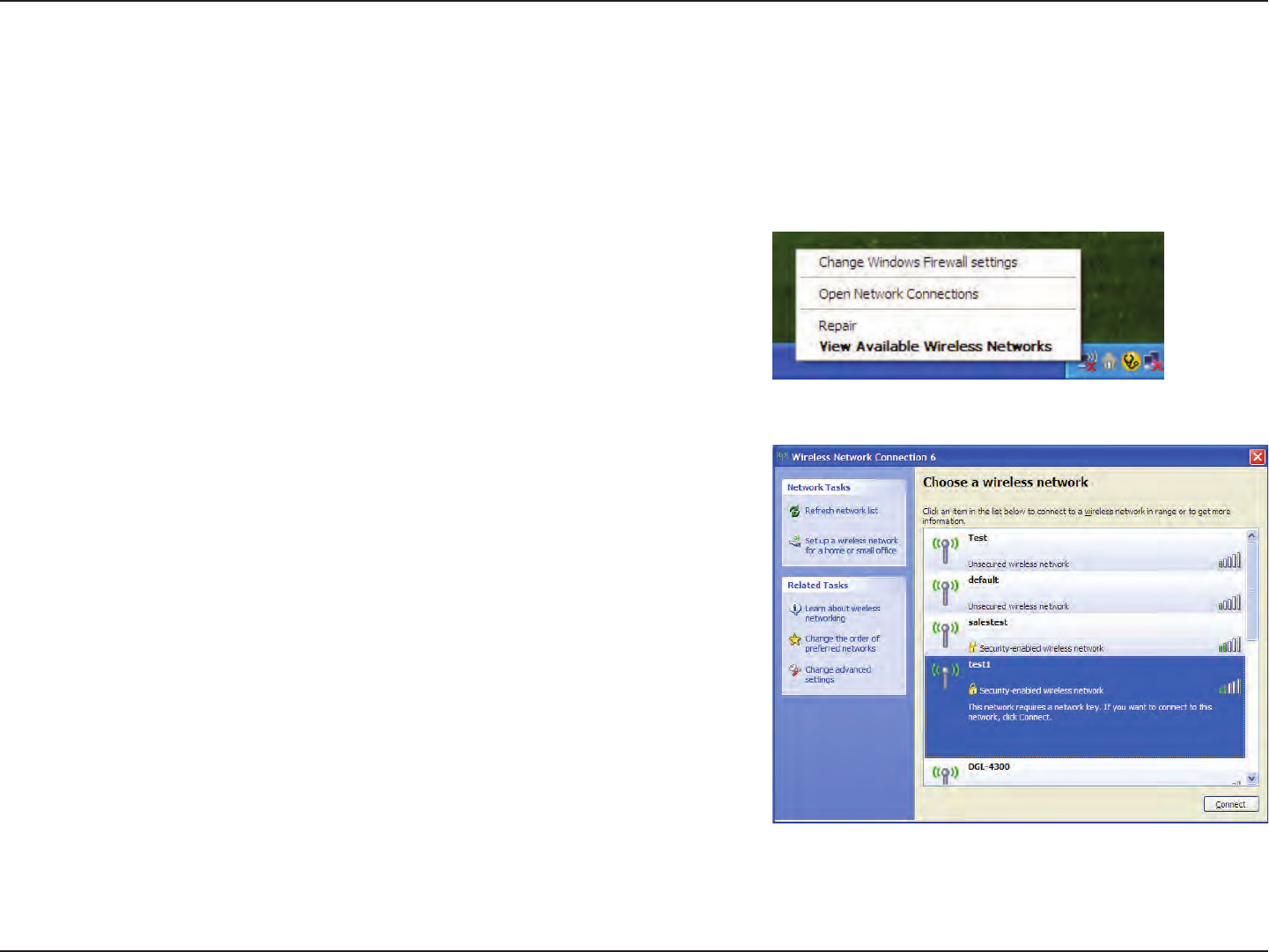
89D-Link DIR-859 User Manual
Section 5 - Connecting to a Wireless Network
It is recommended to enable WPA on your wireless router or access point before conguring your wireless adapter. If you are
joining an existing network, you will need to know the WPA key being used.
2. Highlight the Wi-Fi network (SSID) you would like to connect to and
click Connect.
1. Open the Windows® XP Wireless Utility by right-clicking on the wireless
computer icon in your system tray (lower-right corner of screen). Select
View Available Wireless Networks.
WPA/WPA2

90D-Link DIR-859 User Manual
Section 5 - Connecting to a Wireless Network
3. The Wireless Network Connection box will appear. Enter the WPA-
PSK Wi-Fi password and click Connect.
It may take 20-30 seconds to connect to the wireless network. If the
connection fails, please verify that the WPA-PSK settings are correct. The
Wi-Fi password must be exactly the same as on the wireless router.

91D-Link DIR-859 User Manual
Section 6 - Troubleshooting
Troubleshooting
This chapter provides solutions to problems that can occur during the installation and operation of the DIR-859. Read the
following descriptions if you are having problems. The examples below are illustrated in Windows® XP. If you have a dierent
operating system, the screenshots on your computer will look similar to these examples.
1. Why can’t I access the web-based conguration utility?
When entering the IP address of the D-Link router (192.168.0.1 for example), you are not connecting to a website, nor do you
have to be connected to the Internet. The device has the utility built-in to a ROM chip in the device itself. Your computer must
be on the same IP subnet to connect to the web-based utility.
• Make sure you have an updated Java-enabled web browser. We recommend the following:
- Microsoft Internet Explorer® 9 or higher
- Mozilla Firefox® 20 or higher
- Google™ Chrome 25 or higher
- Apple Safari 5.1 or higher
• Verify physical connectivity by checking for solid link lights on the device. If you do not get a solid link light, try using a
dierent cable, or connect to a dierent port on the device if possible. If the computer is turned o, the link light may not
be on.
• Disable any Internet security software running on the computer. Software rewalls such as ZoneAlarm, BlackICE, Sygate,
Norton Personal Firewall, and Windows® XP rewall may block access to the conguration pages. Check the help les included
with your rewall software for more information on disabling or conguring it.

92D-Link DIR-859 User Manual
Section 6 - Troubleshooting
• Congure your Internet settings:
• Go to Start > Settings > Control Panel. Double-click the Internet Options Icon. From the Security tab, click
the button to restore the settings to their defaults.
• Click the Connection tab and set the dial-up option to Never Dial a Connection. Click the LAN Settings button.
Make sure nothing is checked. Click OK.
• Go to the Advanced tab and click the button to restore these settings to their defaults. Click OK three times.
• Close your web browser (if open) and open it.
• Access the web management. Open your web browser and enter the IP address of your D-Link router in the address bar. This
should open the login page for your web management.
• If you still cannot access the conguration, unplug the power to the router for 10 seconds and plug back in. Wait about 30
seconds and try accessing the conguration. If you have multiple computers, try connecting using a dierent computer.
2. What can I do if I forgot my password?
If you forgot your password, you must reset your router. This process will change all your settings back to the factory defaults.
To reset the router, locate the reset button (hole) on the rear panel of the unit. With the router powered on, use a paperclip
to hold the button down for 10 seconds. Release the button and the router will go through its reboot process. Wait about 30
seconds to access the router. The default IP address is 192.168.0.1. When logging in, leave the password box empty.
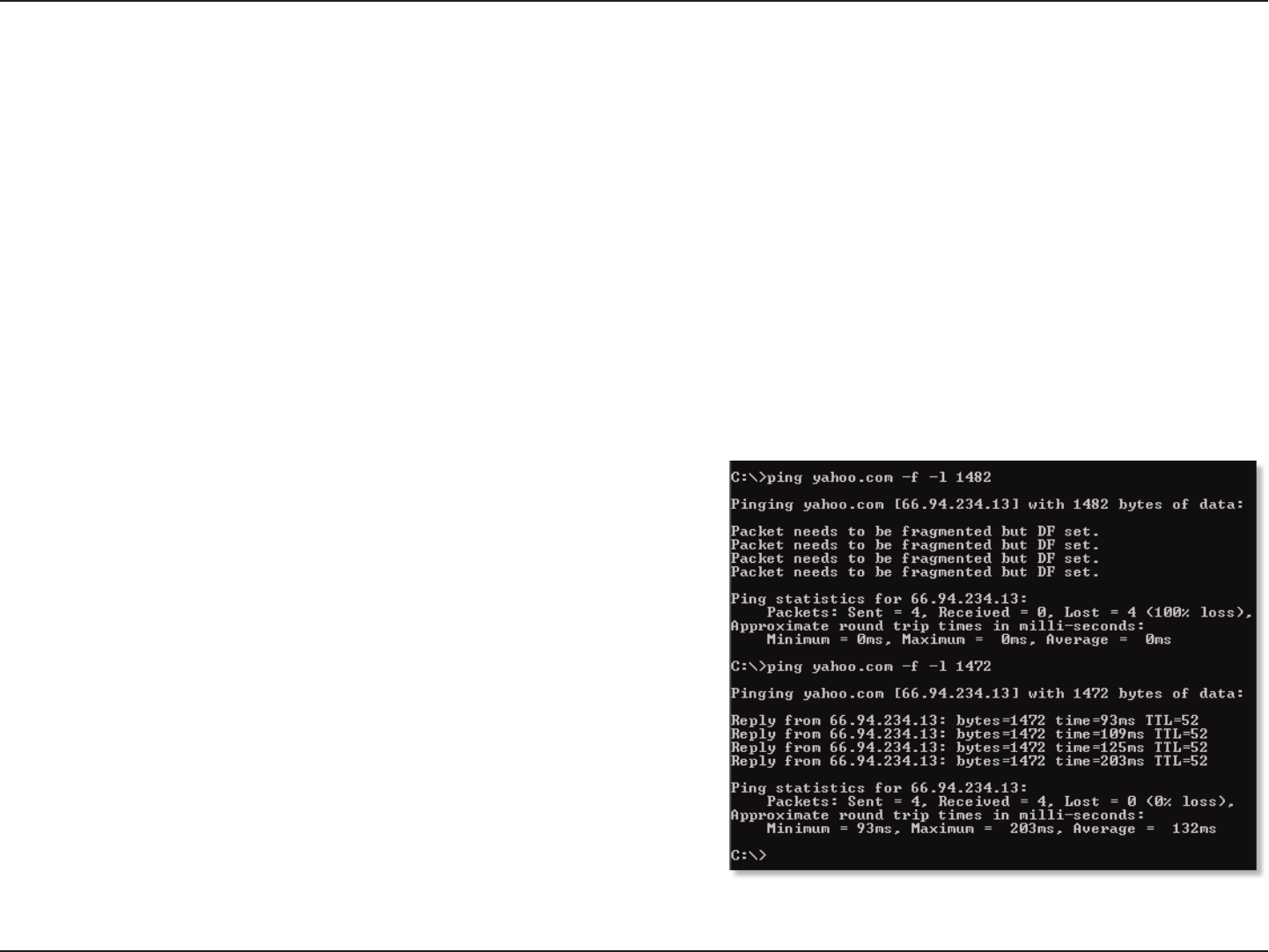
93D-Link DIR-859 User Manual
Section 6 - Troubleshooting
3. Why can’t I connect to certain sites or send and receive emails when connecting through my router?
If you are having a problem sending or receiving email, or connecting to secure sites such as eBay, banking sites, and Hotmail,
we suggest lowering the MTU in increments of ten (Ex. 1492, 1482, 1472, etc).
To nd the proper MTU Size, you’ll have to do a special ping of the destination you’re trying to go to. A destination could be
another computer, or a URL.
• Click on Start and then click Run.
• Windows® 95, 98, and Me users type in command (Windows® NT, 2000, XP, Vista®, and 7 users type in cmd) and
press Enter (or click OK).
• Once the window opens, you’ll need to do a special ping. Use the following syntax:
ping [url] [-f] [-l] [MTU value]
Example: ping yahoo.com -f -l 1472

94D-Link DIR-859 User Manual
Section 6 - Troubleshooting
You should start at 1472 and work your way down by 10 each time. Once you get a reply, go up by 2 until you get a fragmented
packet. Take that value and add 28 to the value to account for the various TCP/IP headers. For example, lets say that 1452 was the
proper value, the actual MTU size would be 1480, which is the optimum for the network we’re working with (1452+28=1480).
Once you nd your MTU, you can now congure your router with the proper MTU size.
To change the MTU rate on your router follow the steps below:
• Open your browser, enter the IP address of your router (192.168.0.1) and click OK.
• Enter your username (admin) and password (blank by default). Click OK to enter the web conguration page
for the device.
• Click on Setup and then click Manual Congure.
• To change the MTU, enter the number in the MTU eld and click Save Settings to save your settings.
• Test your email. If changing the MTU does not resolve the problem, continue changing the MTU in increments
of ten.

95D-Link DIR-859 User Manual
Appendix A - Wireless Basics
D-Link wireless products are based on industry standards to provide easy-to-use and compatible high-speed wireless
connectivity within your home, business, or public access wireless networks. Strictly adhering to the IEEE standard, the D-Link
wireless family of products will allow you to securely access the data you want, when, and where you want it. You will be able
to enjoy the freedom that wireless networking delivers.
A wireless local area network (WLAN) is a cellular computer network that transmits and receives data with radio signals instead
of wires. Wireless LANs are used increasingly in both home and oce environments, and public areas such as airports, coee
shops and universities. Innovative ways to utilize WLAN technology are helping people work, and communicate more eciently.
Increased mobility and the absence of cabling and other xed infrastructure have proven to be benecial for many users.
Wireless users can use the same applications they use on a wired network. Wireless adapter cards used on laptop and desktop
systems support the same protocols as Ethernet adapter cards.
Under many circumstances, it may be desirable for mobile network devices to link to a conventional Ethernet LAN in order to
use servers, printers or an Internet connection supplied through the wired LAN. A Wireless Router is a device used to provide
this link.
Wireless Basics

96D-Link DIR-859 User Manual
Appendix A - Wireless Basics
What is Wireless?
Wireless or Wi-Fi technology is another way of connecting your computer to the network without using wires. Wi-Fi uses radio
frequency to connect wirelessly so you have the freedom to connect computers anywhere in your home or oce network.
Why D-Link Wireless?
D-Link is the worldwide leader and award winning designer, developer, and manufacturer of networking products. D-Link
delivers the performance you need at a price you can aord. D-Link has all the products you need to build your network.
How does wireless work?
Wireless works similarly to how cordless phones work, through radio signals that transmit data from one point A to point B.
But wireless technology has restrictions as to how you can access the network. You must be within the wireless network range
area to be able to connect your computer. There are two dierent types of wireless networksl: Wireless Local Area Network
(WLAN), and Wireless Personal Area Network (WPAN).
Wireless Local Area Network (WLAN)
In a wireless local area network, a device called an Access Point (AP) connects computers to the network. The access point
has a small antenna attached to it, which allows it to transmit data back and forth over radio signals. With an indoor access
point the signal can travel up to 300 feet. With an outdoor access point the signal can reach out up to 30 miles to serve places
like manufacturing plants, industrial locations, university and high school campuses, airports, golf courses, and many other
outdoor venues.

97D-Link DIR-859 User Manual
Appendix A - Wireless Basics
Wireless Personal Area Network (WPAN)
Bluetooth is the industry standard wireless technology used for WPAN. Bluetooth devices in WPAN operate in a range up to
30 feet away.
Compared to WLAN the speed and wireless operation range are both less than WLAN, but in return it doesn’t use nearly as
much power. This makes it ideal for personal devices, such as mobile phones, PDAs, headphones, laptops, speakers, and other
devices that operate on batteries.
Who uses wireless?
Wireless technology as become so popular in recent years that almost everyone is using it, whether it’s for home, oce, business,
D-Link has a wireless solution for it.
Home Uses/Benets
• Gives everyone at home broadband access
• Surf the web, check email, instant message, etc.
• Gets rid of the cables around the house
• Simple and easy to use
Small Oce and Home Oce Uses/Benets
• Stay on top of everything at home as you would at oce
• Remotely access your oce network from home
• Share Internet connection and printer with multiple computers
• No need to dedicate oce space

98D-Link DIR-859 User Manual
Appendix A - Wireless Basics
Where is wireless used?
Wireless technology is expanding everywhere, not just at home or oce. People like the freedom of mobility and it’s becoming
so popular that more and more public facilities now provide wireless access to attract people. The wireless connection in public
places is usually called “hotspots”.
Using a D-Link CardBus adapter with your laptop, you can access the hotspot to connect to the Internet from remote locations
like: airports, hotels, coee shops, libraries, restaurants, and convention centers.
Wireless network is easy to setup, but if you’re installing it for the rst time it could be quite a task not knowing where to start.
That’s why we’ve put together a few setup steps and tips to help you through the process of setting up a wireless network.
Tips
Here are a few things to keep in mind, when you install a wireless network.
Centralize your router or access point
Make sure you place the router/access point in a centralized location within your network for the best performance. Try to
place the router/access point as high as possible in the room, so the signal gets dispersed throughout your home. If you have
a two-story home, you may need a repeater to boost the signal to extend the range.
Eliminate interference
Place home appliances such as cordless telephones, microwaves, and televisions as far away as possible from the router/access
point. This would signicantly reduce any interference that the appliances might cause since they operate on same frequency.

99D-Link DIR-859 User Manual
Appendix A - Wireless Basics
Security
Don’t let your next-door neighbors or intruders connect to your wireless network. Secure your wireless network by turning on
the WPA or WEP security feature on the router. Refer to the product manual for detail information on how to set it up.
There are basically two modes of networking:
• Infrastructure – All wireless clients will connect to an access point or wireless router.
• Ad-Hoc – Directly connecting to another computer for peer-to-peer communication using wireless network
adapters on each computer, such as two or more DIR-859 wireless network Cardbus adapters.
An Infrastructure network contains an access point or wireless router. All the wireless devices, or clients, will connect to the
wireless router or access point.
An Ad-Hoc network contains only clients, such as laptops with wireless cardbus adapters. All the adapters must be in Ad-Hoc
mode to communicate.
Wireless Modes
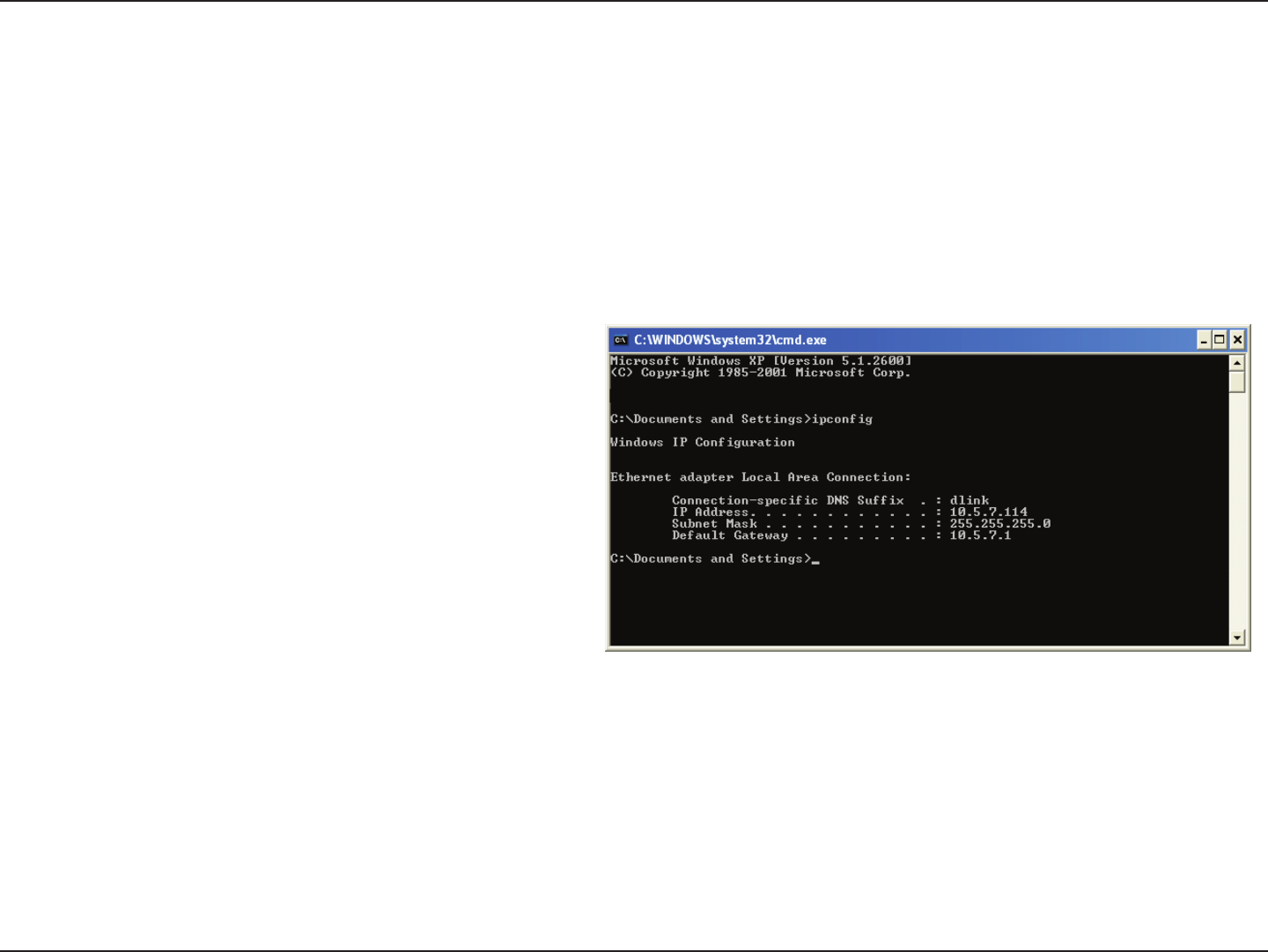
100D-Link DIR-859 User Manual
Appendix B - Networking Basics
Networking Basics
Check your IP address
After you install your new D-Link adapter, by default, the TCP/IP settings should be set to obtain an IP address from a DHCP
server (i.e. wireless router) automatically. To verify your IP address, please follow the steps below.
Click on Start > Run. In the run box type cmd and click OK. (Windows® 7/Vista® users type cmd in the Start Search box.)
At the prompt, type ipcong and press Enter.
This will display the IP address, subnet mask, and the
default gateway of your adapter.
If the address is 0.0.0.0, check your adapter installation,
security settings, and the settings on your router. Some
rewall software programs may block a DHCP request on
newly installed adapters.
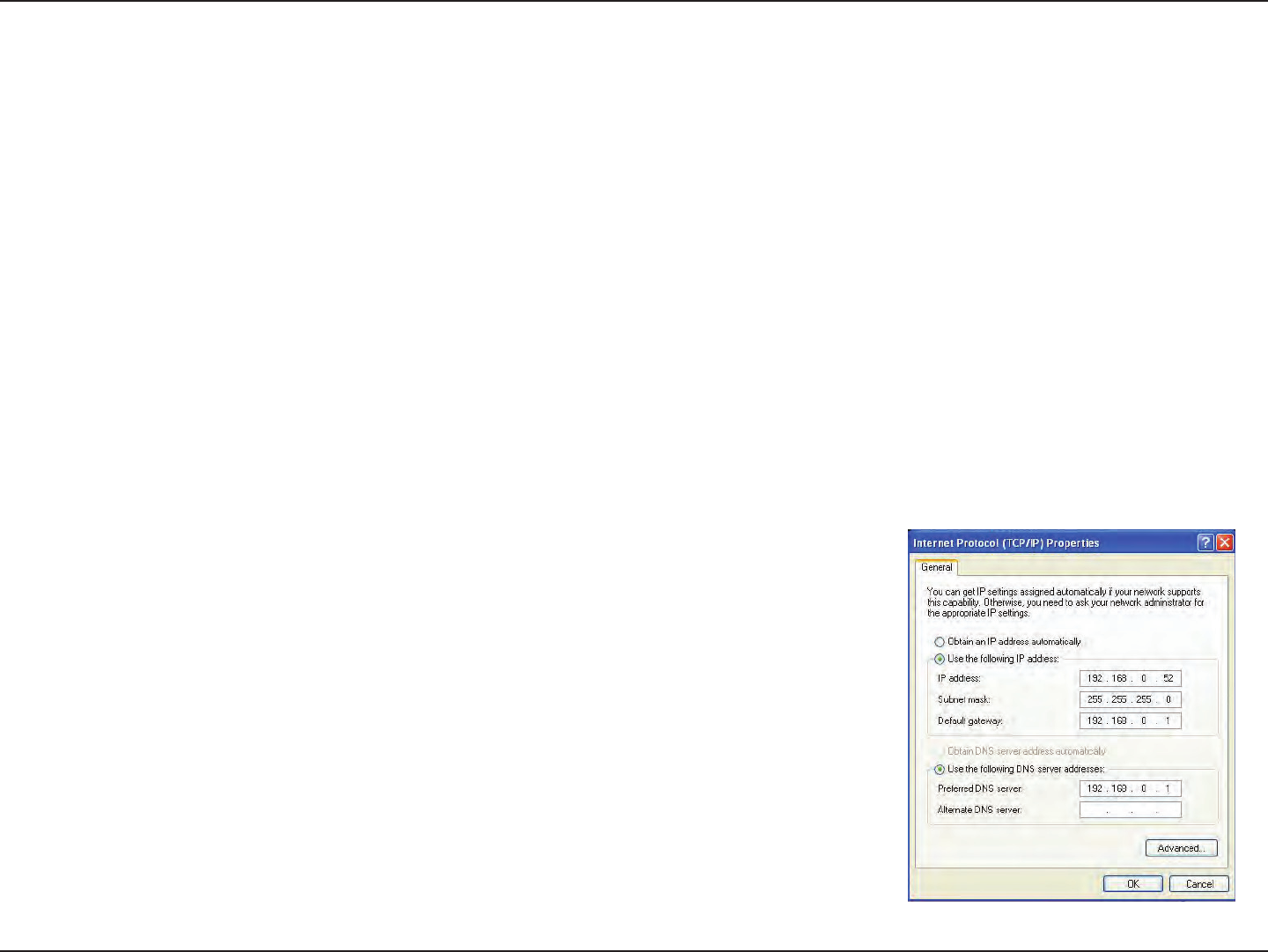
101D-Link DIR-859 User Manual
Appendix B - Networking Basics
Statically Assign an IP address
If you are not using a DHCP capable gateway/router, or you need to assign a static IP address, please follow the steps below:
Step 1
Windows® 7 - Click on Start > Control Panel > Network and Internet > Network and Sharing Center.
Windows Vista® - Click on Start > Control Panel > Network and Internet > Network and Sharing Center > Manage Network
Connections.
Windows® XP - Click on Start > Control Panel > Network Connections.
Windows® 2000 - From the desktop, right-click My Network Places > Properties.
Step 2
Right-click on the Local Area Connection which represents your network adapter and select Properties.
Step 3
Highlight Internet Protocol (TCP/IP) and click Properties.
Step 4
Click Use the following IP address and enter an IP address that is on the same subnet
as your network or the LAN IP address on your router.
Example: If the router´s LAN IP address is 192.168.0.1, make your IP address 192.168.0.X
where X is a number between 2 and 99. Make sure that the number you choose is not
in use on the network. Set the Default Gateway the same as the LAN IP address of your
router (I.E. 192.168.0.1).
Set Primary DNS the same as the LAN IP address of your router (192.168.0.1). The
Secondary DNS is not needed or you may enter a DNS server from your ISP.
Step 5
Click OK twice to save your settings.

102D-Link DIR-859 User Manual
Appendix B - Networking Basics
Wireless Security
This section will show you the dierent levels of security you can use to protect your data from intruders. The DIR-859 oers the following
types of security:
• WPA2 (Wi-Fi Protected Access 2) • WPA2-PSK (Pre-Shared Key)
• WPA (Wi-Fi Protected Access) • WPA-PSK (Pre-Shared Key)
What is WPA?
WPA (Wi-Fi Protected Access), is a Wi-Fi standard that was designed to improve the security features of WEP (Wired Equivalent Privacy).
The 2 major improvements over WEP:
• Improved data encryption through the Temporal Key Integrity Protocol (TKIP). TKIP scrambles the keys using a hashing
algorithm and by adding an integrity-checking feature, ensures that the keys haven’t been tampered with. WPA2 is based
on 802.11i and uses Advanced Encryption Standard (AES) instead of TKIP.
• User authentication, which is generally missing in WEP, through the extensible authentication protocol (EAP). WEP
regulates access to a wireless network based on a computer’s hardware-specic MAC address, which is relatively simple
to be snied out and stolen. EAP is built on a more secure public-key encryption system to ensure that only authorized
network users can access the network.
WPA-PSK/WPA2-PSK uses a passphrase or key to authenticate your wireless connection. The key is an alpha-numeric password between
8 and 63 characters long. The password can include symbols (!?*&_) and spaces. This key must be the exact same key entered on your
wireless router or access point.
WPA/WPA2 incorporates user authentication through the Extensible Authentication Protocol (EAP). EAP is built on a more secure public
key encryption system to ensure that only authorized network users can access the network.

103D-Link DIR-859 User Manual
Appendix C - Technical Specications
Technical Specications
Device Interfaces
• 802.11 a/b/g/n/ac wireless LAN
• Four 10/100/1000 Gigabit LAN ports
• 10/100/1000 Gigabit WAN port
Antenna Types
• Three dual-band dipole antennas
Standards
• IEEE 802.11ac
• IEEE 802.11n
• IEEE 802.11g
• IEEE 802.11b
• IEEE 802.11a
• IEEE 802.3
• IEEE 802.3u
Security
• WPA™ - Personal/Enterprise
• WPA2™ - Personal/Enterprise
• Wi-Fi Protected Setup (WPS) PIN/PBC
Power
• Input: 100 to 240 V AC, 50/60 Hz
• Output: 12 V / 1.5 A
Operating Temperature
• 0 to 40 °C (32 to 104 °F)
Humidity
• 95% maximum (non-condensing)
Certications
• FCC Class B
• CE Class B
• IPv6 Ready
• Wi-Fi Protected Setup (WPS)
• Wi-Fi Multimedia (WMM)
• Compatible with Windows 8
Dimensions
• L = 246.9 mm (9.72 inches)
• W = 190.4 mm (7.50 inches)
• H = 47.2 mm (1.86 inches)

104D-Link DIR-859 User Manual
Appendix D - Regulatory Information
Caution: Do not remove the plug and connect it to a power outlet by itself; always attach the plug to the power adaptor rst
before connecting it to a power outlet.
Federal Communication Commission Interference Statement:
This equipment has been tested and found to comply with the limits for a Class B digital device, pursuant to Part 15 of the FCC
Rules. These limits are designed to provide reasonable protection against harmful interference in a residential installation. This
equipment generates, uses and can radiate radio frequency energy and, if not installed and used in accordance with the instructions,
may cause harmful interference to radio communications. However, there is no guarantee that interference will not occur in a
particular installation. If this equipment does cause harmful interference to radio or television reception, which can be determined
by turning the equipment o and on, the user is encouraged to try to correct the interference by one of the following measures:
• Reorient or relocate the receiving antenna.
• Increase the separation between the equipment and receiver.
• Connect the equipment into an outlet on a circuit dierent from that to which the receiver is connected.
• Consult the dealer or an experienced radio/TV technician for help.
Non-modications Statement:
Any changes or modications not expressly approved by the party responsible for compliance could void the user’s authority
to operate this equipment.
Caution:
This device complies with Part 15 of the FCC Rules. Operation is subject to the following two conditions: (1) This device may
not cause harmful interference, and (2) this device must accept any interference received, including interference that may
cause undesired operation.
For product available in the USA/Canada market, only channel 1~11 can be operated. Selection of other channels is not possible.
This device and its antenna(s) must not be co-located or operating in conjunction with any other antenna or transmitter except
in accordance with FCC multi-transmitter product procedures.
Regulatory Information

105D-Link DIR-859 User Manual
Appendix D - Regulatory Information
Note:
The country code selection is for non-US model only and is not available to all US model. Per FCC regulation, all Wi-Fi
product marketed in US must xed to US operation channels only.
RF Frequency Requirements:
This device is for indoor use only when using all channels in the 5.150-5.250 GHz, 5.725-5.850 GHz frequency ranges. High
power radars are allocated as primary users of the 5.150-5.250 GHz, 5.725-5.850 GHz bands. These radar stations can cause
interference with and/or damage this device. This device will not operate on channels which overlap the 5600-5650 MHz
band. It is restricted in indoor environments only.
IMPORTANT NOTE:
FCC Radiation Exposure Statement:
This equipment complies with FCC radiation exposure limits set forth for an uncontrolled environment. This equipment should
be installed and operated with minimum distance 25 cm between the radiator and your body.
Customer Information:
(1) This equipment complies with Part 68 of the FCC rules and the requirements adopted by the ACTA. On bottom of this
equipment is a label that contains, among other information, a product identier of 0. If requested, this number must be
provided to the telephone company.
(2) If this equipment 0 causes harm to the telephone network, the telephone company will notify you in advance that
temporary discontinuance of service may be required. But if advance notice isn’t practical, the telephone company will
notify the customer as soon as possible. Also you will be advised of your right to le a complaint with the FCC if you believe
it is necessary.
(3) The telephone company may make changes in its facilities, equipment, operations or procedures that could aect the
operation of the equipment. If this happens, the telephone company will provide advance notice in order for you to make
necessary modication to maintain uninterrupted service.
(4) If you experience trouble with this equipment, you disconnect it from the network until the problem has been corrected
or until you are sure that the equipment is not malfunctioning.
(5) Please follow instructions for repairing if any (e.g. battery replacement section); otherwise do not alternate or repair any
parts of device except specied.
(6) Connection to party line service is subject to state taris. Contact the state public utility commission, public service

106D-Link DIR-859 User Manual
Appendix D - Regulatory Information
commission or corporation commission for information.
(7) If the telephone company requests information on what equipment is connected to their lines, inform them of:
(a)The telephone number that this unit is connected to,
(b)The ringer equivalence number 0
(c)The USOC jack required 0 and
(d)The FCC Registration Number 0
Items (b) and (d) are indicated on the label. The ringer equivalence number (REN) is used to determine how many devices
can be connected to your telephone line. In most areas, the sum of the RENs of all devices on any one line should not
exceed ve (5.0). If too many devices are attached, they may not ring properly.
(8) If your home has specially wired alarm equipment connected to the telephone line, ensure the installation of this
equipment does not disable alarm equipment, consult your telephone company or a qualied installer.
Safety Warning:
CAUTION: Risk of Explosion if Battery is replaced by an Incorrect Type. Dispose of Used Batteries According to the
Instructions.
ATTENTION: Risque d'explosion si la batterie est remplacée par un type incorrect. Jetez les piles usagées selon les
instructions.
Industry Canada Statement:
This device complies with Industry Canada licence-exempt RSS standard(s). Operation is subject to the following two
conditions:
(1) this device may not cause interference, and
(2) this device must accept any interference, including interference that may cause undesired operation of the device.
Le présent appareil est conforme aux CNR d'Industrie Canada applicables aux appareils radio exempts de licence.
L'exploitation est autorisée aux deux conditions suivantes :
(1) l'appareil ne doit pas produire de brouillage, et
(2) l'utilisateur de l'appareil doit accepter tout brouillage radioélectrique subi, même si le brouillage est susceptible d'en
compromettre le fonctionnement.

107D-Link DIR-859 User Manual
Appendix D - Regulatory Information
Caution:
(i) the device for operation in the band 5150-5250 MHz is only for indoor use to reduce the potential for harmful
interference to co-channel mobile satellite systems.
Avertissement:
(i) les dispositifs fonctionnant dans la bande 5150-5250 MHz sont réservés uniquement pour une utilisation à l’intérieur an
de réduire les risques de brouillage préjudiciable aux systèmes de satellites mobiles utilisant les mêmes canaux.
Radiation Exposure Statement
This equipment complies with IC radiation exposure limits set forth for an uncontrolled environment. This equipment
should be installed and operated with minimum distance 20 cm between the radiator & your body.
Déclaration d'exposition aux radiations
Cet équipement est conforme aux limites d'exposition aux rayonnements IC établies pour un environnement non contrôlé.
Cet équipement doit être installé et utilisé avec un minimum de 20 cm de distance entre la source de rayonnement et votre
corps.
Warning
This unit is to be used with a power supply, P/N AMS3-1201500FV , AMS3-1201500FU or WA-18Q12R-ABBE APD-G-1/
APD-K-1.
Avertissement
Cet appareil doit etre utilise avec une source de courrant, modele AMS3-1201500FV , AMS3-1201500FU or WA-18Q12R-ABBE
APD-G-1/ APD-K-1.
CAUTION: Risk of explosion if battery is replaced by an incorrect type. Dispose of used batteries according to the
instructions.
ATTENTION: Risque d'explosion si la batterie est remplacée par un type incorrect. Jetez les piles usagées selon les
instructions.